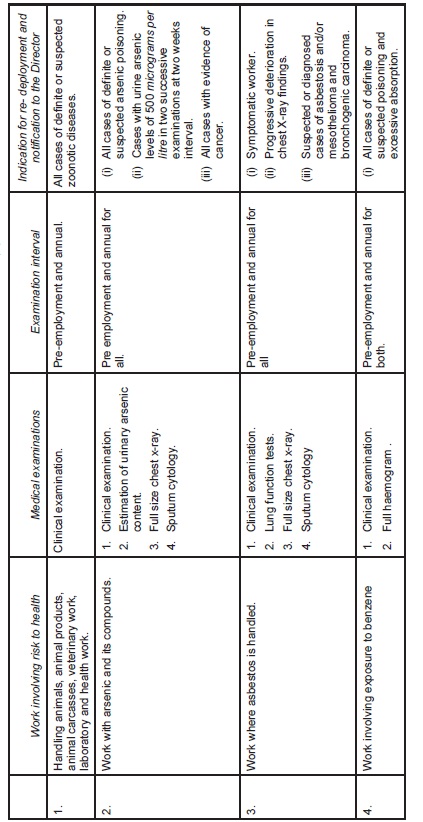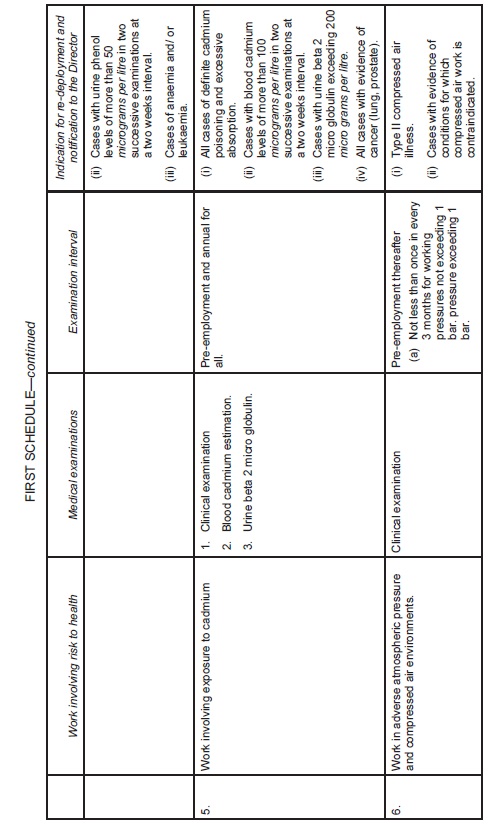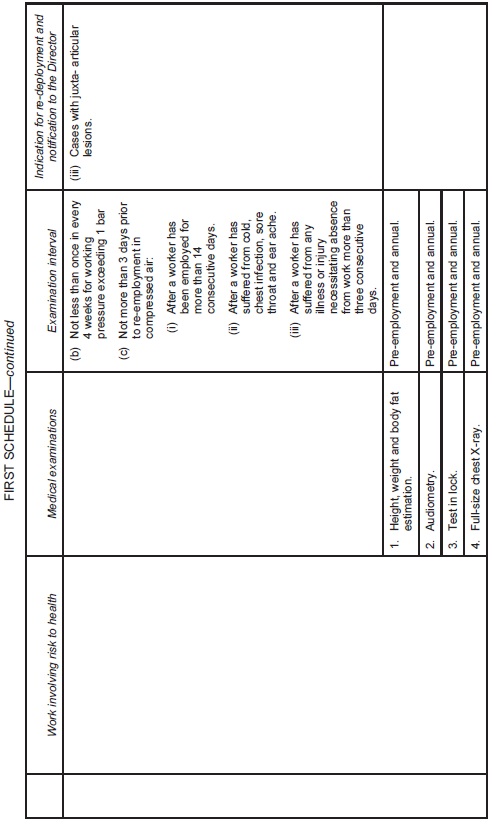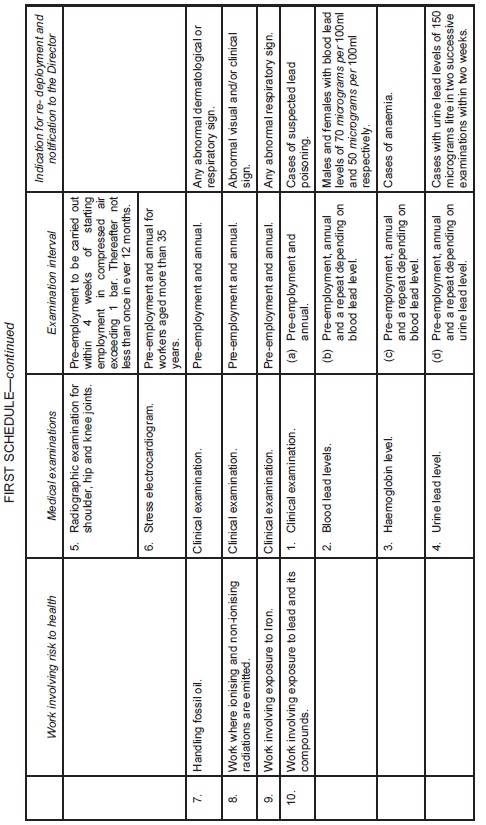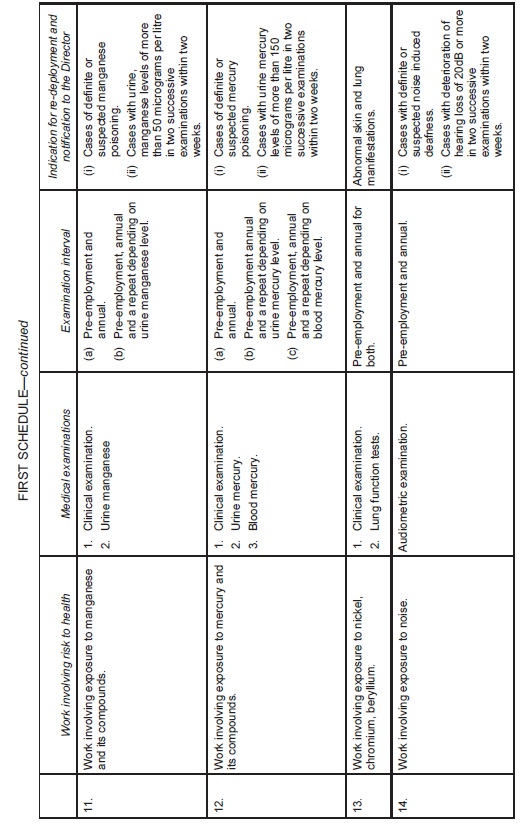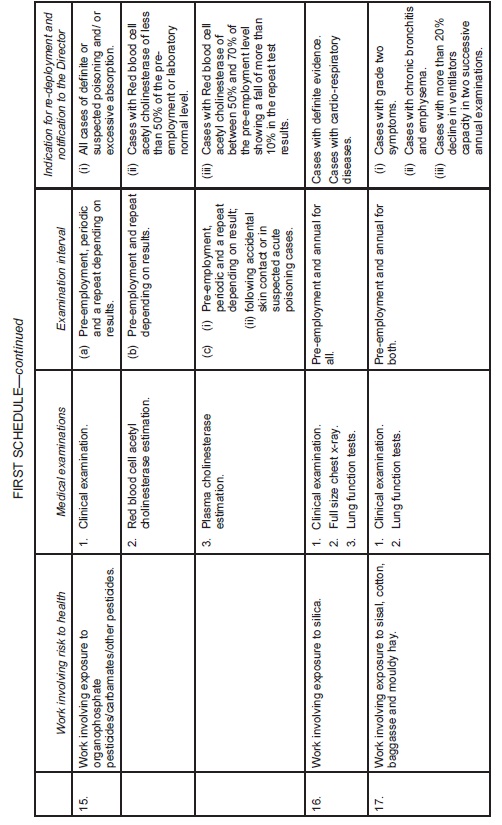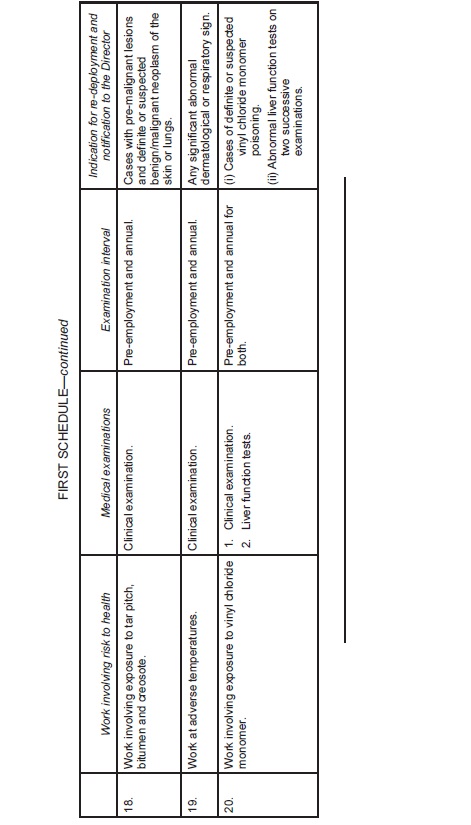|
Arrangement of Sections
|
-
FACTORIES (WOODWORKING
MACHINERY) RULES
-
FACTORIES (EXAMINATION
OF PLANT) ORDER
-
FACTORIES (FIRST-AID) ORDER
-
FACTORIES (CELLULOSE
SOLUTIONS) RULES
-
FACTORIES (DOCKS) RULES
-
1. Citation
-
2. Application
-
3. Interpretation
-
4. Classification of ships
-
4. Classification of ships
-
5. Exemptions
-
6.Duties
-
7. Means of approach over dock, wharf or quay
-
8. Lighting
-
9. Means of rescue from drowning
-
9. Means of rescue from drowning
-
10. First-aid boxes and cupboards
-
11. Stretchers
-
12. Provision of ambulance
-
12. Provision of ambulance
-
13.Ambulance rooms
-
13.Ambulance rooms
-
14. Notices as to first-aid appliances
-
15. Sanitary conveniences and washing facilities
-
16. Drinking water
-
17. Means of access from ship to shore and shore to ship
-
18. Means of access from ship to ship
-
19. Means of access to holds, etc.
-
19. Means of access to holds, etc.
-
20. Lifting gear for hatch beams
-
21. Marking of hatch coverings and hatch beams
-
22. Maintenance of hatch beams and hatch coverings
-
23. Provision of hand grips, etc., on hatch coverings
-
24. Working space around hatches
-
25. Lighting of ships
-
26. Lifting machinery
-
27. Lifting tackle
-
27. Lifting tackle
-
28. Ropes
-
29. Competent persons
-
29. Competent persons
-
30. Register of lifting machinery and lifting tackle
-
30. Register of lifting machinery and lifting tackle
-
31. Marking of safe working loads on pulley blocks
-
32. Marking of safe working loads on slings
-
33. Marking of safe working loads on cranes and derricks
-
34. Fencing of machinery and plant
-
35. Special provisions regarding conveyors
-
36. Stability of lifting appliances
-
37. Cranes and winches — prevention of accidental descent of
load
-
38. Access to and fencing of crane platforms
-
39. Steam cranes and winches
-
40. Precautions with respect to the use of chains and ropes
-
41. Pallets and cargo trays
-
42. Keeping of registers, etc., by Class 2 ships
-
43. Requirements on first visits of Class 3 ships
-
44. Disposition of goods on wharf or quay
-
45. Use of deck-stages, hand trucks, etc.
-
46. Fencing or covering of hatches
-
47. Securing of hatch beams
-
48. Work at intermediate decks
-
49. Work on skeleton decks
-
50. Stacking of cargo
-
51. Means of escape from holds, etc.
-
52.Restrictions on use of hooks
-
53. Use of signallers
-
54. Overloading of machinery, and use of coupled derricks
-
55. Drivers of cranes or winches and signallers
-
56. Ventilation
-
57. Precautions where dangerous fumes liable to be present
-
58. Protection against dust
-
59. Provision of protective clothing
-
60. Transport to or from ship by water
-
61. Prohibition of removal or interference with safety appliances
-
62. Prohibition of removal of fencing
-
63. Use of means of access
-
64. Prohibition as to going on beams
-
65. Prohibition as to riding on conveyors
-
66. Duty of master as to hold which has been fumigated
-
67. Duty of employer as to use of machinery
-
68. Duty of employer as to means of access and lighting
-
69. Prescribed register
-
1....
-
2....
-
3....
-
3....
-
4....
-
5....
-
1....
-
2....
-
...
-
...
-
FACTORIES (EXTENSION
OF APPLICATION) ORDER
-
FACTORIES (FORM
OF ABSTRACT) ORDER
-
FACTORIES (GENERAL
REGISTER) ORDER
-
FACTORIES AND
OTHER PLACES OF WORK (SAFETY AND HEALTH COMMITTEES) RULES, 2004
-
FACTORIES AND
OTHER PLACES OF WORK (MEDICAL EXAMINATION) RULES, 2005
-
FACTORIES AND
OTHER PLACES OF WORK (NOISE PREVENTION AND CONTROL) RULES, 2005
-
FACTORIES AND
OTHER PLACES OF WORK (FIRE RISK REDUCTION) RULES
-
FACTORIES AND
OTHER PLACES OF WORK (HAZARDOUS SUBSTANCES) RULES, 2007
|
|
FACTORIES (WOODWORKING MACHINERY) RULES
ARRANGEMENT OF RULES
PART I – PRELIMINARY
PART II – DUTIES OF OCCUPIERS
| 7. |
Push-sticks for use at circular saws.
|
| 10. |
Band mills and band re-saws.
|
| 11. |
Cutter blocks of overhand planing machines.
|
| 12. |
“Bridge” guards for overhand planing machines.
|
| 13. |
Planing machines used for thicknessing, moulding, matching or tenoning.
|
| 14. |
Vertical spindle moulding machines and routing machines.
|
| 15. |
Jigs and holders for use at vertical spindle moulding machines and routing machines.
|
| 16. |
“Spikes” for use at vertical spindle moulding machines and routing machines.
|
| 17. |
Chain mortising machines.
|
| 18. |
Maintenance and adjustment of guards.
|
| 19. |
Certain rules not to apply when other safeguards provided.
|
PART III – DUTIES OF PERSONS EMPLOYED
| 20. |
Duties of persons employed.
|
PART IV – DISPOSAL OF WOODWORKING MACHINERY
| 21. |
Disposal of Woodworking Machinery.
|
RULES UNDER SECTIONS 26 AND 55
FACTORIES (WOODWORKING
MACHINERY) RULES
[Cap 514, Sub.Leg, L.N. 431/1959, L.N. 514/1990.]
PART I – PRELIMINARY
| 1. |
Citation
These Rules may be cited as the Factories (Woodworking Machinery) Rules.
|
| 2. |
Interpretation
In these Rules—
“circular saw” means a circular saw working in a bench (including a rack bench) for the purpose of ripping, deep cutting or cross cutting, but does not include a swing saw or other saw which is moved towards the wood;
“gauge” means the Imperial Standard Wire Gauge;
“pendulum saw” means a swing saw which is suspended from a pivot above a table, bench or other support on which wood is placed and which is operated by being pulled across such table, bench or other support;
“plain band saw” means a band saw, other than a band mill or band re-saw, the cutting portion of which runs in a vertical direction;
“planing machine” includes a machine for overhand planing, thicknessing, moulding, matching or tenoning or any two or more of these operations, but does not include a vertical spindle moulding machine;
“woodworking machine” means a circular saw, pendulum saw, plain band saw, band mill, band re-saw, planing machine, vertical spindle moulding machine, routing machine or chain mortising machine operating on wood.
|
| 3. |
Application
| (1) |
These Rules shall apply to all factories in which any woodworking machine is used.
|
| (2) |
If the Chief Inspector of Factories is satisfied in respect of any factory that, owing to the special conditions of the work or otherwise, any of the requirements of these Rules can be suspended or relaxed without danger to the persons employed therein, he may by certificate in writing (which he may at his discretion revoke) authorize such suspension or relaxation as may be indicated in the certificate for such period and on such conditions as he may think fit.
|
|
| 3. |
Application
| (1) |
These Rules shall apply to all factories in which any woodworking machine is used.
|
| (2) |
If the Director of Occupational Health and Safety Services is satisfied in respect of any factory that, owing to the special conditions of the work or otherwise, any of the requirements of these Rules can be suspended or relaxed without danger to the persons employed therein, he may by certificate in writing (which he may at his discretion revoke) authorize such suspension or relaxation as may be indicated in the certificate for such period and on such conditions as he may think fit.
|
|
| 4. |
Duties
It shall be the duty of the occupier of every factory to which these Rules apply to observe Part II of these Rules; and it shall be the duty of all persons employed in every such factory to observe Part III of these Rules.
|
PART II – DUTIES OF OCCUPIERS
| 5. |
Floors
The floor surrounding every woodworking machine shall be maintained in a good and level condition and, as far as practicable, free from chips or other loose material and shall not be allowed to become slippery.
|
| 6. |
Circular saws
Every circular saw shall be fenced as follows—
| (a) |
the part of the saw below the bench table shall be protected by two plates of metal or other suitable material, one on each side of the saw; such plates shall not be more than six inches apart and shall extend from the axis of the saw outwards to a distance of not less than two inches beyond the teeth of the saw; metal plates, if not beaded, shall be of a thickness at least equal to 14 gauge, or, if beaded, be of a thickness at least equal to 20 gauge;
|
| (b) |
behind and in a direct line with the saw there shall be a riving knife, which shall be at its greatest thickness not less than the thickness of the saw blade and less than the width of the saw kerf, and which shall have a smooth surface, shall be strong, rigid and easily adjustable, and shall also conform to the following requirements—
| (i) |
the edge of the knife nearer the saw shall form an arc of a circle having a radius not exceeding the radius of the largest saw used on the bench; |
| (ii) |
the knife shall be maintained as close as practicable to the saw, having regard to the nature of the work being done at the time, and at the level of the bench table the distance between the front edge of the knife and teeth of the saw shall not exceed half an inch; |
| (iii) |
for a saw of a diameter of less than twenty-four inches, the knife shall extend upwards from the bench table to within one inch of the top of the saw, and for a saw of a diameter of twenty-four inches or more shall extend upwards from the bench table to a height of at least nine inches; |
|
| (c) |
the top of the saw shall be covered by a strong and easily adjustable guard, with a flange at the side of the saw farthest from the fence; the guard shall be kept so adjusted that the said flange shall extend below the roots of the teeth of the saw; and the guard shall extend from the top of the riving knife to a point as low as practicable at the cutting edge of the saw.
|
|
| 7. |
Push-sticks for use at circular saws
A suitable push-stick shall be kept available for use at the bench of every circular saw which is fed by hand, to enable the work to be carried on without unnecessary risk.
|
| 8. |
Pendulum saws
The following provisions shall apply to every pendulum saw—
| (a) |
the top half of the saw shall be completely and securely covered by sheet metal or other suitable material;
|
| (b) |
the work table, bench or support shall be of rigid construction and shall incorporate a suitable back rail against which the stock may be rested during sawing;
|
| (c) |
there shall be provided and maintained an efficient device which automatically returns the saw to the back position when released at any point of its travel; such device shall not depend for its proper functioning on any fibre rope; the saw shall not be deemed to be in the back position until the front edge of the saw is at least one inch behind the front edge of the back rail;
|
| (d) |
when the saw is in the back position it shall be enclosed or otherwise securely guarded as far as practicable;
|
| (e) |
limit chains or other effective devices shall be provided and maintained to prevent the front edge of the saw from travelling beyond the front edge of the work table, bench or support.
|
|
| 9. |
Plain band saws
Every plain band saw shall be guarded as follows—
| (a) |
both sides of the bottom pulley shall be completely encased by sheet metal or other suitable material;
|
| (b) |
the front of the top pulley shall be covered with sheet metal or other suitable material;
|
| (c) |
all portions of the blade shall be enclosed or otherwise securely guarded, except the portion of the blade between the table and the top guide.
|
|
| 10. |
Band mills and band re-saws
| (1) |
The blade of every band mill or band re-saw shall be enclosed or otherwise securely guarded as far as practicable.
|
| (2) |
In the case of a band mill or band re-saw the cutting portion of which runs in a vertical direction—
| (a) |
both sides of the bottom pulley shall be completely encased by sheet metal or other suitable material; and
|
| (b) |
the front of the top pulley shall be covered with sheet metal or other suitable material.
|
|
| (3) |
In the case of a band mill or band re-saw the cutting portion of which runs in a horizontal direction, the front of both pulleys shall be covered with sheet metal or other suitable material.
|
|
| 11. |
Cutter blocks of overhand planing machines
Every planing machine which is not mechanically fed and is intended to be used for overhand planing shall be fitted with a cylindrical cutter block.
|
| 12. |
“Bridge” guards for overhand planing machines
Every planing machine intended to be used for overhand planing shall be provided with a “bridge” guard capable of covering the full length and breadth of the cutting slot in the bench and so constructed as to be easily adjusted in both a vertical and a horizontal direction.
|
| 13. |
Planing machines used for thicknessing, moulding, matching
or tenoning
Every planing machine intended to be used for thicknessing, moulding, matching or tenoning shall be provided with guards which shall enclose—
|
| 14. |
Vertical spindle moulding machines and routing machines
The cutter of every vertical spindle moulding machine and of every routing machine shall, whenever practicable, be provided with the most efficient guard having regard to the nature of the work which is being performed.
|
| 15. |
Jigs and holders for use at vertical spindle moulding machines
and routing machines
For such work as cannot be performed with an efficient guard for the cutter, the wood being worked at a vertical spindle moulding machine or routing machine shall, if practicable, be held in a jig or holder of such construction as to reduce, as far as possible, the risk of accident to the worker.
|
| 16. |
“Spikes” for use at vertical spindle moulding machines and
routing machines
A suitable “spike” or push-stick shall be kept available for use at the bench of every vertical spindle moulding machine and of every routing machine.
|
| 17. |
Chain mortising machines
The chain of every chain mortising machine shall be provided with a guard which shall enclose the cutters as far as practicable.
|
| 18. |
Maintenance and adjustment of guards
The guards and other appliances required by these Rules shall be maintained in an efficient state and shall be constantly kept in position while the machinery is in motion, except when, owing to the nature of the work being done, the use of the guards or appliances is rendered impracticable; the guards shall be so adjusted as to enable the work to be carried on without unnecessary risk.
|
| 19. |
Certain rules not to apply when other safeguards provided
Rules 6, 8, 9, 10, 12 and 13 of these Rules shall not apply to any woodworking machine in respect of which it can be shown that other safeguards are provided and maintained which render the machine equally safe as it would be if guarded in the manner prescribed by these Rules.
|
PART III – DUTIES OF PERSONS EMPLOYED
| 20. |
Duties of persons employed
Every person employed on a woodworking machine shall—
| (a) |
use and maintain in proper adjustment the guards provided in accordance with these Rules; and
|
| (b) |
use the “spikes” or push-sticks and holders provided in compliance with rules 7, 15 and 16 of these Rules,
|
except when, owing to the nature of the work being done, the use of the guards or appliances is rendered impracticable.
|
PART IV – DISPOSAL OF WOODWORKING MACHINERY
| 21. |
Disposal of Woodworking Machinery
The provisions of subsection (2) of section 26 of the Act (which prohibits the sale or letting on hire of certain machines which do not comply with the provisions of that section) shall extend to any machine, being a circular saw, plain band saw, planing machine or chain mortising machine, that does not comply with the requirements of rule 6, rule 9, rule 11, rule 12, rule 13 or rule 17, as the case may be, of these Rules:
Provided that this Rule shall not apply in the case of any circular saw, plain band saw or planing machine in respect of which it can be shown that other safeguards are provided which render it equally safe as it would be if provided with the guards and other appliances required by these Rules.
|
FACTORIES (EXAMINATION
OF PLANT) ORDER
[G.N. 958/1951.]
ORDER UNDER SECTIONS 30(2), 37(8) AND (9), 38(5) AND 39(4)
| 1. |
This Order may be cited as the Factories (Examination of Plant) Order.
|
PART I – PREPARATION OF STEAM BOILERS FOR EXAMINATION
| 2. |
Any person who desires that an examination of a steam boiler should be carried out for the purposes of section 37 of the Act shall provide such facilities for the examination of the interior and exterior of the boiler and for hammer testing, drilling, lifting, hydraulic testing, steam trial or other means of testing as may be required by the authorized boiler inspector carrying out the examination, and, without prejudice to the generality of the foregoing, shall cause—
| (a) |
the steam boiler to be thoroughly opened up and all flues and other parts to be thoroughly cleaned and scaled;
|
| (b) |
all doors of man-holes, mud-holes and hand-holes to be taken off;
|
| (c) |
brickwork, composition covering, fire-bars, fire-bridges, tubes and stays to be removed to the extent required by the authorized boiler inspector;
|
| (d) |
all junction valves, feed valves and safety valves to be taken apart and cleaned.
|
|
PART II – REPORTS OF RESULTS OF EXAMINATIONS
| 3. |
The report of the result of every examination of a hoist or lift, steam boiler, steam receiver or air receiver shall be in the form of, and contain the particulars specified in, forms printed and published by the Government Printer, and bearing the following respective numbers—
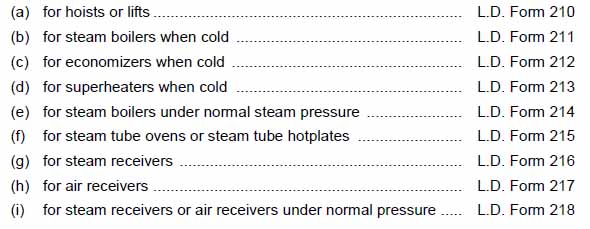
|
EXCEPTIONS UNDER SECTION 30(10)
The class or description of hoist or hoistway specified in the first column hereunder are excepted from the requirements of section 30 of the Act specified in the second column hereunder, subject however to the conditions and limitations set opposite thereto in the third column hereunder; and in these exceptions “hoist” and “hoistway” include “lift” and “liftway” respectively. [L.N.
280/1956, L.N. 12/1958, L.N. 325/1964.]
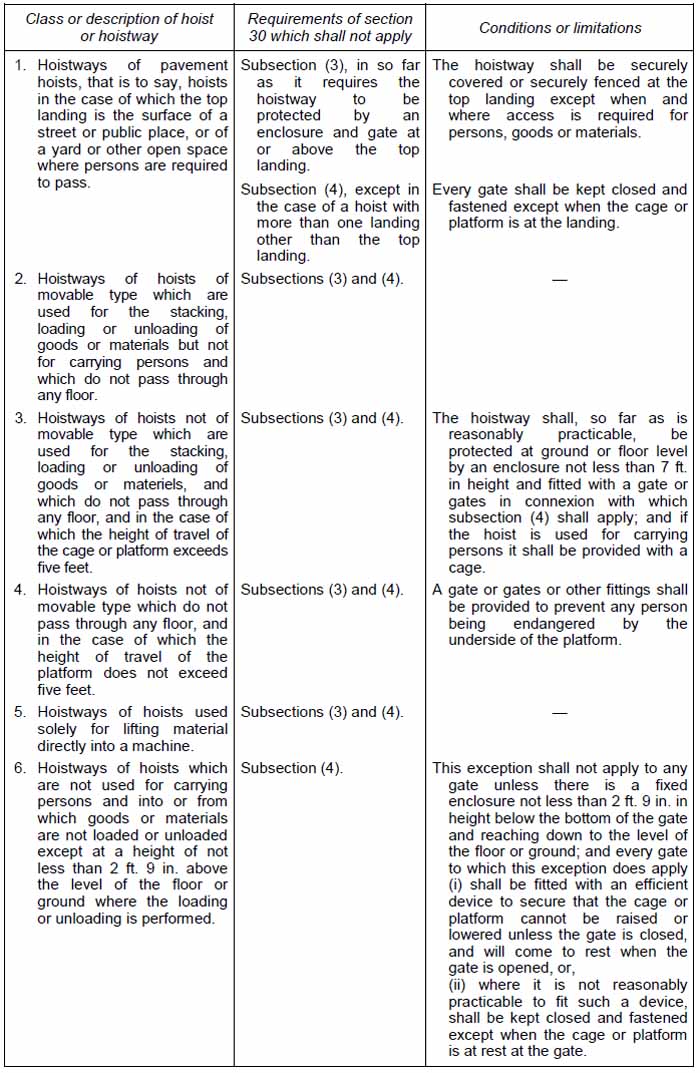
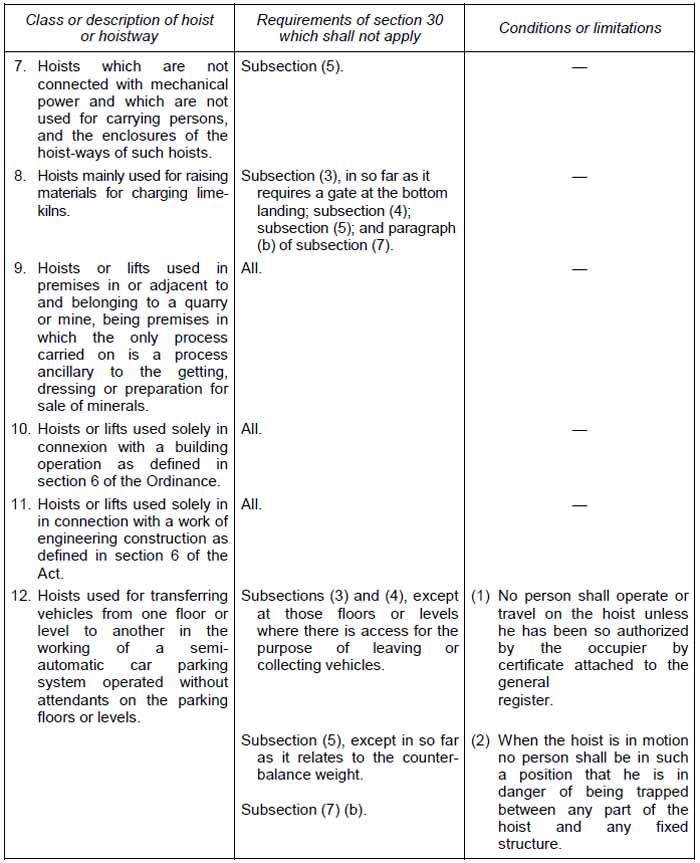
EXCEPTIONS UNDER SECTION 31(1)(F)
The following classes of chain and lifting tackle are exempted from the requirements of section 31(1)(f) as to annealing—
| 1. |
Chains made of malleable cast iron.
|
| 3. |
Chains, rings, hooks, shackles and swivels made of steel or any non-ferrous metal.
|
| 4. |
Pitched chains working on sprocket or pocketed wheels.
|
| 5. |
Rings, hooks, shackles and swivels permanently attached to pitched chains, pulley blocks or weighing machines.
|
| 6. |
Hooks and swivels having screw-threaded parts or ball bearings or other case-hardened parts.
|
| 7. |
Socket shackles secured to wire ropes by white metal capping.
|
| 9. |
Any chain or lifting tackle which has been subjected to the heat treatment known as “normalizing” instead of annealing.
|
EXCEPTIONS UNDER SECTION 40
The types of steam boiler specified in the first column hereunder are excepted from the requirements of section 37 of the Act specified in the second column hereunder, subject however to the conditions and limitations set opposite thereto in the third column hereunder.
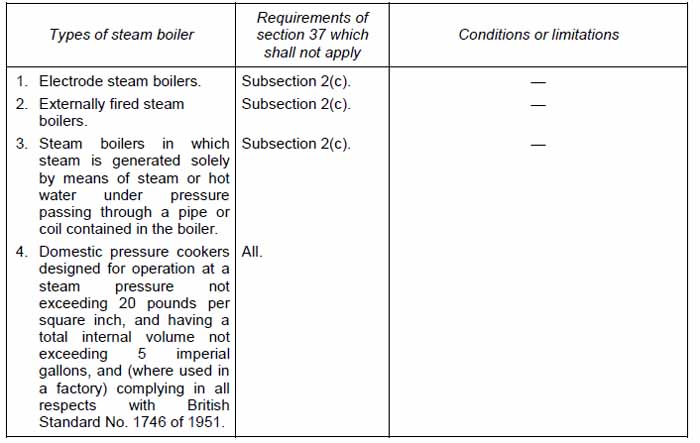
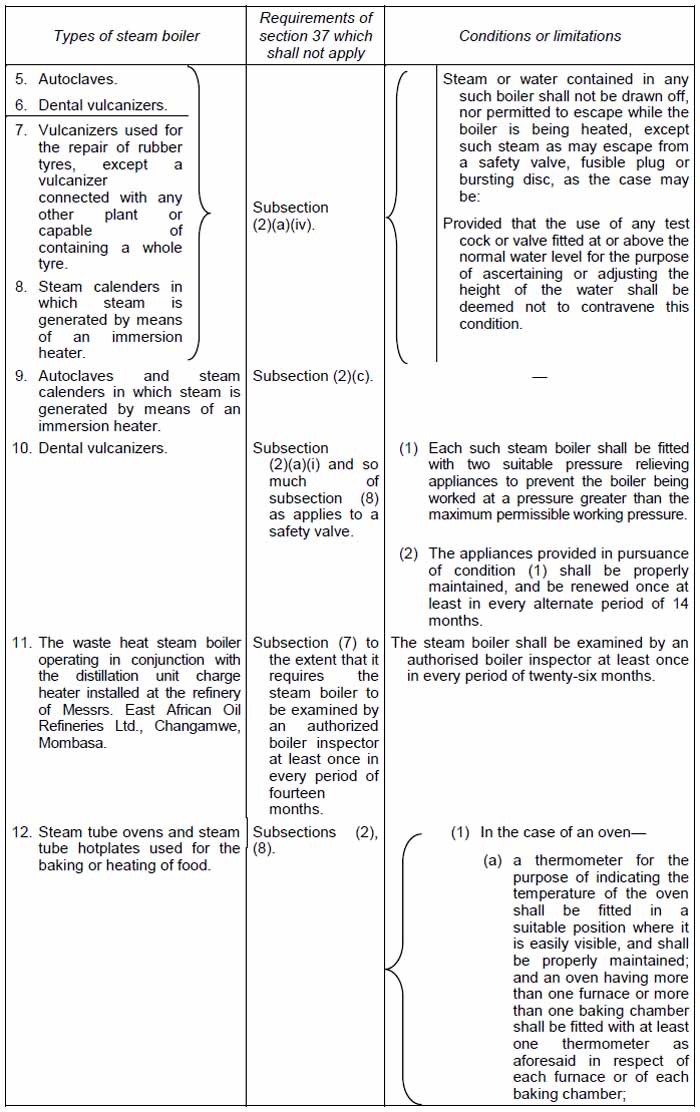
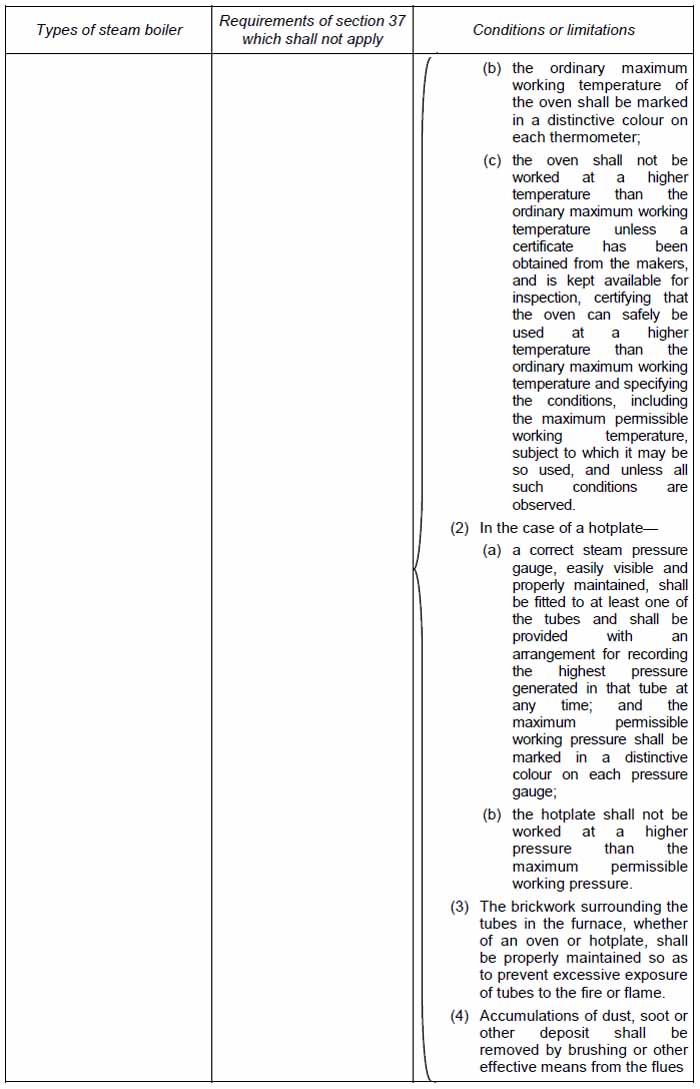
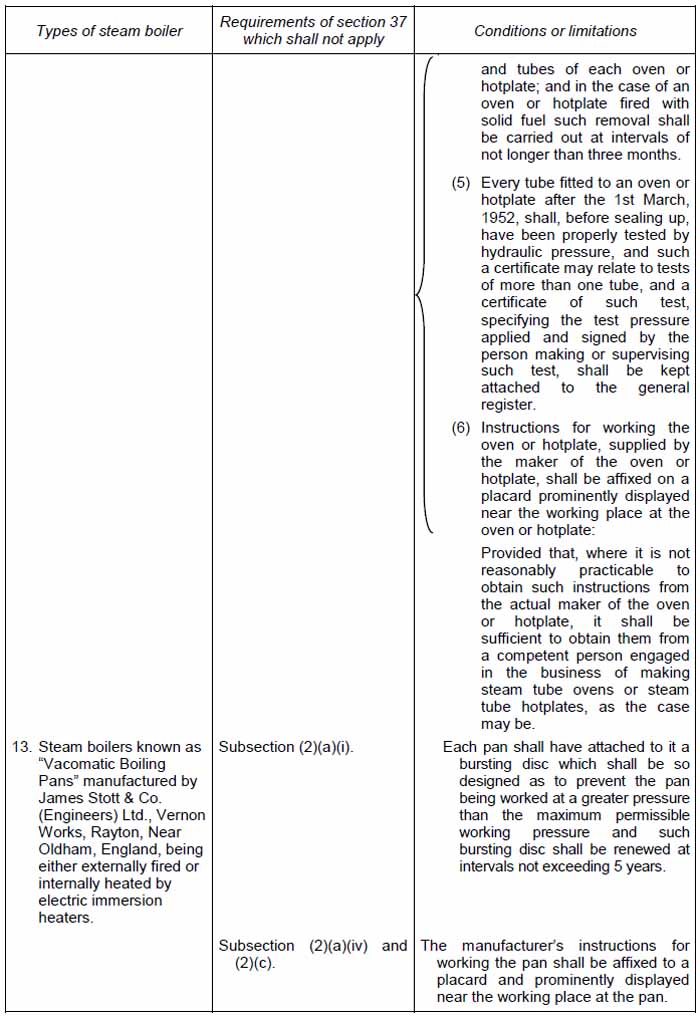
The types of steam receiver specified in the first column here under are excepted from the requirements of section 38 of the Act specified in the second column hereunder, subject however to the conditions and limitations set opposite thereto in the third column hereunder.
PART A
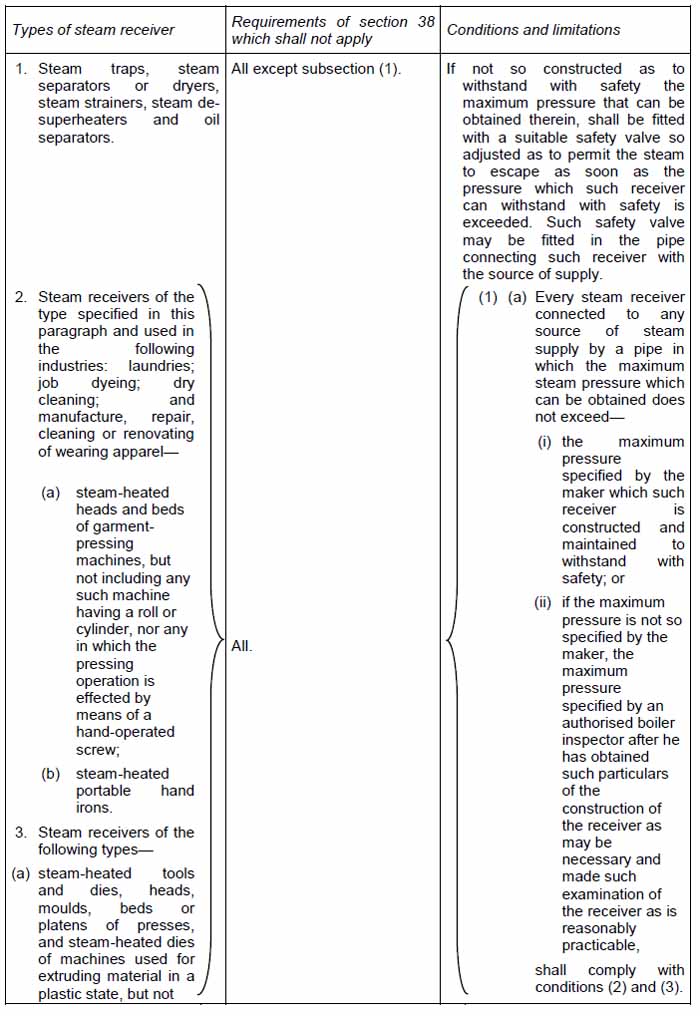
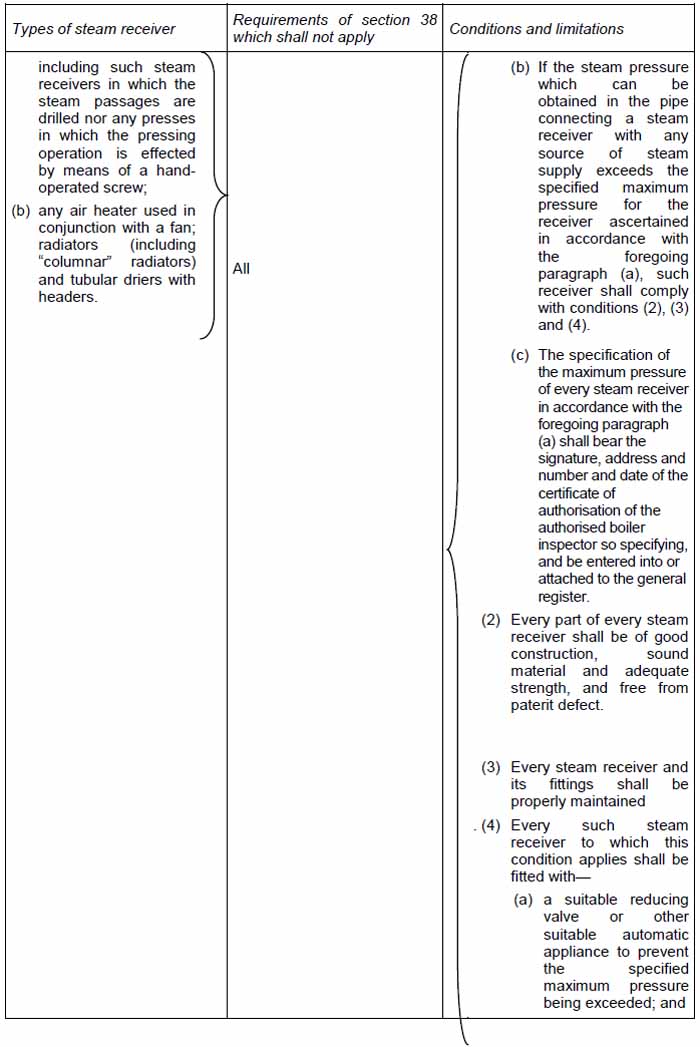
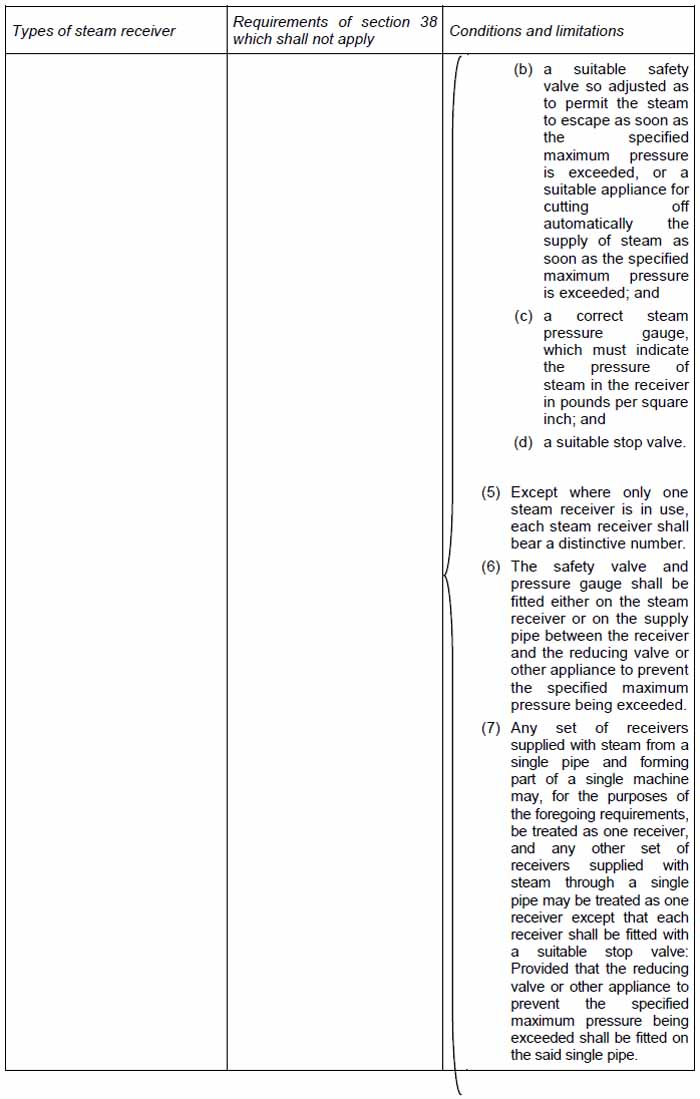
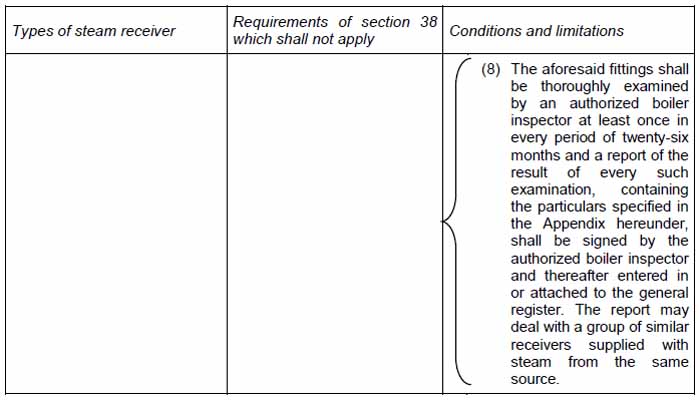
APPENDIX
Particulars of Result of Examination of Fittings of Steam Receivers of the types specified in Part A of the Exceptions from the Requirements of section 38 of the Factories Act.
PART B

The types of air receiver specified in the first column hereunder are excepted from the requirements of section 39 of the Act specified in the second column hereunder, subject however to the conditions and limitations set opposite thereto in the third column hereunder. [L.N. 278/1956, L.N. 279/1956.]

ORDER UNDER
SECTION 50
FACTORIES (FIRST-AID) ORDER
[G.N. 974/1951,
L.N. 666/1963.]
| 1. |
This Order may be cited as the Factories (First-Aid) Order.
|
| 2. |
The first-aid boxes or cupboards required by section 50(1) of the Act to be provided and maintained in factories shall comply with the following standards—
| (a) |
for factories in which the number of persons employed does not exceed ten, each first-aid box or cupboard shall contain at least—
| (i) |
a copy of the first-aid leaflet (L.D. 250/1) issued by the Labour Department; |
| (ii) |
a sufficient number (not less than six) of small sterilized unmedicated dressings for injured fingers; |
| (iii) |
a sufficient number (not less than three) of medium-sized sterilized unmedicated dressings for injured hands or feet; |
| (iv) |
a sufficient number (not less than three) of large sterilized unmedicated dressings for other injured parts; |
| (v) |
a sufficient number (not less than twelve) of adhesive wound dressings of a suitable type and of assorted sizes; |
| (vi) |
a sufficient number (not less than two) of triangular bandages of unbleached calico, the longest side of which measures not less than fifty-one inches and each of the other sides not less than thirty-six inches; |
| (vii) |
a sufficient supply of adhesive plaster; |
| (viii) |
a sufficient supply of absorbent sterilized cotton wool, in half-ounce packets; |
| (ix) |
a sufficient supply of Factory Eye Drops, B.P.C.; |
| (x) |
a sufficient number (not less than two) of sterilized eye-pads in separate sealed packets; |
| (xii) |
a supply of safety pins; |
|
| (b) |
for factories in which the number of persons employed exceeds ten but does not exceed fifty, each first-aid box or cupboard shall contain at least—
| (i) |
a copy of the first-aid leaflet (L.D. 350/1) issued by the Labour Department; |
| (ii) |
a sufficient number (not less than twelve) of small sterilized unmedicated dressings for injured fingers; |
| (iii) |
a sufficient number (not less than six) of medium-sized sterilized unmedicated dressings for injured hands or feet; |
| (iv) |
a sufficient number (not less than six) of large sterilized unmedicated dressings for other injured parts; |
| (v) |
a sufficient number (not less than twenty-four) of adhesive wound dressings of a suitable type and assorted sizes; |
| (vi) |
a sufficient number (not less than four) of triangular bandages of unbleached calico, the longest side of which measures not less than fifty-one inches and each of the other sides not less than thirty-six inches; |
| (vii) |
a sufficient supply of adhesive plaster; |
| (viii) |
a sufficient supply of absorbent sterilized cotton wool, in half-ounce packets; |
| (ix) |
a sufficient supply of Factory Eye Drops, B.P.C.; |
| (x) |
a sufficient number (not less than four) of sterilized eye-pads in separate sealed packets; |
| (xii) |
a supply of safety pins; |
|
| (c) |
for factories employing more than fifty persons, each first-aid box or cupboard shall contain at least—
| (i) |
a copy of the first-aid leaflet (L.D. 250/1) issued by the Labour Department; |
| (ii) |
a sufficient number (not less than twenty-four) of small sterilized unmedicated dressings for injured fingers; |
| (iii) |
a sufficient number (not less than twelve) of medium-sized sterilized unmedicated dressings for injured hands or feet; |
| (iv) |
a sufficient number (not less than twelve) of large sterilized unmedicated dressings for other injured parts; |
| (v) |
a sufficient number (not less than thirty-six) of adhesive wound dressings of a suitable type and assorted sizes; |
| (vi) |
a sufficient number (not less than eight) of triangular bandages of unbleached calico, the longest side of which measures not less than fifty-one inches and each of the other sides not less than thirty-six inches; |
| (vii) |
a sufficient supply of adhesive plaster; |
| (viii) |
a sufficient supply of absorbent sterilized cotton wool, in half-ounce packets; |
| (ix) |
a sufficient supply of Factory Eye Drops, B.P.C.; |
| (x) |
a sufficient number (not less than eight) of sterilized eye-pads in separate sealed packets; |
| (xii) |
a supply of safety pins; |
|
| (d) |
all materials for drugs and dressings contained in first-aid boxes or cupboards shall be those designated in, and of a grade or quality not lower than the standards specified by, the British Pharmaceutical Codex including any supplement thereto;
|
| (e) |
each first-aid box or cupboard shall be plainly marked “FIRST-AID”.
|
|
FACTORIES (CELLULOSE SOLUTIONS) RULES
ARRANGEMENT OF RULES
PART I – PRELIMINARY
PART II – DUTIES OF OCCUPIERS
| 5. |
Notice of use or storage of cellulose solutions.
|
| 6. |
Construction of cellulose cabinets, cellulose spaces and ventilating ducts.
|
| 8. |
Precautions against ignition of cellulose solutions, inflammable liquids and solid residues.
|
| 9. |
Means of escape in case of fire.
|
| 10. |
Disposal of waste materials.
|
| 11. |
Removal of solid residues.
|
| 12. |
Storage of cellulose solutions and inflammable liquids.
|
| 13. |
Cellulose solutions and inflammable liquids in workrooms.
|
PART III – DUTIES OF PERSONS EMPLOYED
| 14. |
Prohibition of smoking, open lights, etc.
|
| 15. |
Disposal of waste materials.
|
FACTORIES (CELLULOSE
SOLUTIONS) RULES
[L.N. 231/1957, L.N. 87/1964, L.N. 514/1990.]
PART I – PRELIMINARY
| 1. |
Citation
These Rules may be cited as the Factories (Cellulose Solutions) Rules.
|
| 2. |
Interpretation
In these Rules—
“cellulose cabinet” means a cabinet, booth or similar structure within which cellulose solutions or inflammable liquids are manipulated or used;
“cellulose solution” means any solution in inflammable liquid of cellulose nitrate, cellulose acetate or other cellulose compound, or of celluloid, or any other substance containing cellulose nitrate, cellulose acetate or other cellulose compound, with or without the admixture of other substances;
“cellulose space” means a room or part of a room within which cellulose solutions or inflammable liquids are manipulated or used otherwise than in a cellulose cabinet;
“cellulose store” means any room, chamber or similar structure in which cellulose solutions or inflammable liquids are stored;
“fire-resisting material” means—
| (a) |
properly constructed brickwork, stone or concrete-block work of not less than four and one-half inches in thickness; or
|
| (b) |
concrete of not less than three inches in thickness; or
|
| (c) |
iron or steel of not less than 16 Imperial Standard Wire Gauge in thickness; or
|
| (d) |
glass of not less than one-quarter of an inch in thickness in the centre of which wire mesh is embedded; or
|
| (e) |
for doors only, oak or teak or other wood of similar hardness of not less than one and three-quarter inches in finished thickness; or
|
| (f) |
except for cellulose stores, wood completely and securely covered on both sides with compressed asbestos of not less than three-sixteenths of an inch in thickness; or
|
any other material approved in writing by the Chief Inspector of Factories;
“inflammable liquid” means any liquid or mixture of liquids used or intended for use in connexion with cellulose solutions which has a flash point of less than one hundred degrees Fahrenheit Abel closed test at an atmospheric pressure of 14.7 pounds per square inch;
“storage tank” means a tank used for storing cellulose solutions or inflammable liquids.
|
| 2. |
Interpretation
In these Rules—
“cellulose cabinet” means a cabinet, booth or similar structure within which cellulose solutions or inflammable liquids are manipulated or used;
“cellulose solution” means any solution in inflammable liquid of cellulose nitrate, cellulose acetate or other cellulose compound, or of celluloid, or any other substance containing cellulose nitrate, cellulose acetate or other cellulose compound, with or without the admixture of other substances;
“cellulose space” means a room or part of a room within which cellulose solutions or inflammable liquids are manipulated or used otherwise than in a cellulose cabinet;
“cellulose store” means any room, chamber or similar structure in which cellulose solutions or inflammable liquids are stored;
“fire-resisting material” means—
| (a) |
properly constructed brickwork, stone or concrete-block work of not less than four and one-half inches in thickness; or
|
| (b) |
concrete of not less than three inches in thickness; or
|
| (c) |
iron or steel of not less than 16 Imperial Standard Wire Gauge in thickness; or
|
| (d) |
glass of not less than one-quarter of an inch in thickness in the centre of which wire mesh is embedded; or
|
| (e) |
for doors only, oak or teak or other wood of similar hardness of not less than one and three-quarter inches in finished thickness; or
|
| (f) |
except for cellulose stores, wood completely and securely covered on both sides with compressed asbestos of not less than three-sixteenths of an inch in thickness; or
|
any other material approved in writing by the Director of Occupational Health and Safety Services;
“inflammable liquid” means any liquid or mixture of liquids used or intended for use in connexion with cellulose solutions which has a flash point of less than one hundred degrees Fahrenheit Abel closed test at an atmospheric pressure of 14.7 pounds per square inch;
“storage tank” means a tank used for storing cellulose solutions or inflammable liquids.
|
| 3. |
Application
| (1) |
These Rules shall, subject to the exceptions hereinafter provided, apply to all factories in which cellulose solutions are used or stored.
|
| (2) |
Nothing in these Rules shall apply to the painting of any building, or to any process in the manufacture of artificial silk, or of explosives within the meaning of the Explosives Act (Cap. 115).
|
| (3) |
Rules 6, 7 and 9 of these Rules shall not apply to any cellulose space in which cellulose solutions or inflammable liquids are not manipulated or used for more than 15 minutes on any one day.
|
| (4) |
If the Chief Inspector of Factories is satisfied in respect of any factory or any class of process that, owing to the special conditions or special methods of work or otherwise, any of the requirements of these Rules can be suspended or relaxed without danger to the persons employed therein, or that the application of these Rules or any part thereof is for any reason impracticable, he may by certificate in writing, (which he may at his discretion revoke) authorize such suspension or relaxation as may be indicated in the certificate for such period and on such conditions as he may think fit.
|
|
| 3. |
Application
| (1) |
These Rules shall, subject to the exceptions hereinafter provided, apply to all factories in which cellulose solutions are used or stored.
|
| (2) |
Nothing in these Rules shall apply to the painting of any building, or to any process in the manufacture of artificial silk, or of explosives within the meaning of the Explosives Act (Cap. 115).
|
| (3) |
Rules 6, 7 and 9 of these Rules shall not apply to any cellulose space in which cellulose solutions or inflammable liquids are not manipulated or used for more than 15 minutes on any one day.
|
| (4) |
If the Director of Occupational Health and Safety Services is satisfied in respect of any factory or any class of process that, owing to the special conditions or special methods of work or otherwise, any of the requirements of these Rules can be suspended or relaxed without danger to the persons employed therein, or that the application of these Rules or any part thereof is for any reason impracticable, he may by certificate in writing, (which he may at his discretion revoke) authorize such suspension or relaxation as may be indicated in the certificate for such period and on such conditions as he may think fit.
|
|
| 4. |
Duties
It shall be the duty of the occupier of any factory to which these Rules apply to observe Part II of these Rules; and it shall be the duty of every person employed in such a factory to observe Part III of these Rules.
|
PART II – DUTIES OF OCCUPIERS
| 5. |
Notice of use or storage of cellulose solutions
The occupier shall not use or store cellulose solutions in any factory in which he did not use or store such solutions before the commencement of these Rules, unless and until he has given to the Chief Inspector of Factories fourteen clear days’ notice in writing of his intention to do so, or such shorter notice as the Director of Occupational Health and Safety Services may agree to accept.
|
| 5. |
Notice of use or storage of cellulose solutions
The occupier shall not use or store cellulose solutions in any factory in which he did not use or store such solutions before the commencement of these Rules, unless and until he has given to the Director of Occupational Health and Safety Services fourteen clear days’ notice in writing of his intention to do so, or such shorter notice as the Director of Occupational Health and Safety Services may agree to accept.
|
| 6. |
Construction of cellulose cabinets, cellulose spaces and
ventilating ducts
| (1) |
Every cellulose cabinet shall be completely closed except in so far as openings are necessary for the purposes of the work or for the operation of the ventilating apparatus required by rule 7 of these Rules.
|
| (2) |
Every cellulose space shall be separated by enclosure from every other part of the building or room except in so far as openings are necessary for the purposes of the work or for the operation of the ventilating apparatus required by rule 7 of these Rules.
|
| (3) |
Every cellulose cabinet, and all walls, partitions, doors, windows, floors, tops and ceilings enclosing or forming part of the enclosure of any cellulose space, shall be constructed of fire-resisting material:
Provided that the provisions of this paragraph shall not apply to any tops or ceilings of single-storey buildings or of top floor rooms, or any outside walls, doors or windows, other than any of the aforesaid parts of a building in respect of which the Minister specially directs that the said provisions shall apply.
|
| (4) |
All ducts, trunks or casings used in connexion with the means of ventilation required by rule 7 of these Rules shall be constructed of fire-resisting material:
Provided that such ducts, trunks or casings made of iron or steel may be of a thickness less than 16 Imperial Standard Wire Gauge.
|
|
| 7. |
Ventilation
| (1) |
Every cellulose cabinet or cellulose space shall be adequately ventilated by mechanical means so as to remove as completely as possible from the building any vapours of cellulose solutions or inflammable liquids, and to prevent their escape into any occupied room or work place; such ventilation shall be kept in full operation for a period of at least five minutes after the cessation of any process in the manipulation or use of cellulose solutions or inflammable liquids.
|
| (2) |
Where cellulose solutions are applied by spraying apparatus, arrangements shall, as far as practicable, be made so as to render it unnecessary for the person operating the spray to be in a position between the ventilating outlet and the article being sprayed.
|
|
| 8. |
Precautions against ignition of cellulose solutions, inflammable
liquids and solid residues
| (1) |
No fire, flame, open light or other agency likely to ignite cellulose solutions or inflammable liquids or the vapours thereof shall be allowed within twenty feet of any cellulose cabinet, cellulose space, cellulose store or storage tank unless effectively separated therefrom by means of intervening fire-resisting material.
|
| (2) |
All heating and electrical apparatus (including lamp fittings and resistances) liable to attain a temperature of 180° Fahrenheit shall be so situated or so protected as to prevent the deposition thereon of any solid residues resulting from the manipulation or use of cellulose solutions.
|
|
| 9. |
Means of escape in case of fire
Adequate means of escape in case of fire, including a sufficient number of safe exits not fewer than two in number, shall be provided and maintained for every room in which a cellulose cabinet is situated and for every cellulose space, and such exits shall be so constructed as to open outwards.
|
| 10. |
Disposal of waste materials
Cotton waste, cleaning rags or similar material liable to spontaneous combustion shall, after use, be deposited without delay in metal containers with covers; all such containers shall be emptied at the end of the day’s work and their contents disposed of in a safe manner.
|
| 11. |
Removal of solid residues
| (1) |
Effective steps shall be taken to remove any solid residues resulting from the manipulation or use of cellulose solutions from all cellulose cabinets and cellulose spaces, and also from all ducts, trunks, casings or fans used in connexion therewith, and such residues shall be disposed of in a safe manner.
|
| (2) |
No such removal shall be effected by scraping with iron or steel implements.
|
|
| 12. |
Storage of cellulose solutions and inflammable liquids
All stocks of cellulose solutions or inflammable liquids shall be kept in—
| (a) |
fixed storage tanks of safe construction and in safe positions, each such tank being separately and effectively earthed; or
|
| (b) |
metal drums, cans or similar vessels situated in cellulose stores, which shall either be constructed of fire-resisting material or be in safe positions not less than thirty feet from any occupied building and to which no unauthorized person shall be allowed to have access.
|
|
| 13. |
Cellulose solutions and inflammable liquids in workrooms
| (1) |
The quantity of cellulose solutions or inflammable liquids in any workroom shall be kept as small as practicable having regard to the work carried on, and shall not, in any case, exceed the estimated requirements for one day’s work; such cellulose solutions or inflammable liquids shall, when not in actual use, be kept in a metal cupboard or other receptacle at least as safe.
|
| (2) |
All drums, cans or similar vessels containing cellulose solutions or inflammable liquids shall be kept securely closed when the contents are not in actual use, and shall, after the contents have been expended, be removed without delay to a store constructed or situated in accordance with rule 12 of these Rules, or to some other place, outside the building, at least as safe.
|
|
PART III – DUTIES OF PERSONS EMPLOYED
| 14. |
Prohibition of smoking, open lights, etc.
| (1) |
No person shall smoke in any room in which a cellulose cabinet is situated, or in any cellulose space, or in any cellulose store, or within twenty feet of any cellulose store or storage tank unless he is effectively separated from the cellulose store or tank by fire-resisting material.
|
| (2) |
All persons employed shall observe the requirements of paragraph (1) of rule 8 of these Rules.
|
|
| 15. |
Disposal of waste materials
Any person using cotton waste, cleaning rags or similar material shall comply with the requirements of rule 10 of these Rules.
|
| 16. |
General
Every person who is engaged in the manipulation or use of cellulose solutions or inflammable liquids shall make full and proper use of the ventilating and other appliances provided for the purposes of these Rules, shall report forthwith to the occupier, manager or other responsible person any defect in the same, and shall observe such directions as may be given to him with a view to carrying out these Rules.
|
FACTORIES (DOCKS) RULES
ARRANGEMENT OF RULES
PART I – PRELIMINARY
| 4. |
Classification of ships.
|
PART II – FACILITIES ON SHORE
| 7. |
Means of approach over dock, wharf or quay.
|
| 9. |
Means of rescue from drowning.
|
| 10. |
First-aid boxes and cupboards.
|
| 12. |
Provision of ambulance.
|
| 14. |
Notices as to first-aid appliances.
|
| 15. |
Sanitary conveniences and washing facilities.
|
PART III – GENERAL PROVISIONS AS TO SAFETY ON BOARD SHIP
| 17. |
Means of access from ship to shore and shore to ship.
|
| 18. |
Means of access from ship to ship.
|
| 19. |
Means of access to holds, etc.
|
| 20. |
Lifting gear for hatch beams.
|
| 21. |
Marking of hatch coverings and hatch beams.
|
| 22. |
Maintenance of hatch beams and hatch coverings.
|
| 23. |
Provision of hand grips, etc., on hatch coverings.
|
| 24. |
Working space around hatches.
|
PART IV – LIFTING MACHINERY, PLANT AND EQUIPMENT
| 30. |
Register of lifting machinery and lifting tackle.
|
| 31. |
Marking of safe working loads on pulley blocks.
|
| 32. |
Marking of safe working loads on slings.
|
| 33. |
Marking of safe working loads on cranes and derricks.
|
| 34. |
Fencing of machinery and plant.
|
| 35. |
Special provisions regarding conveyors.
|
| 36. |
Stability of lifting appliances.
|
| 37. |
Cranes and winches—prevention of accidental descent of load.
|
| 38. |
Access to and fencing of crane platforms.
|
| 39. |
Steam cranes and winches.
|
| 40. |
Precautions with respect to the use of chains and ropes.
|
| 41. |
Pallets and cargo trays.
|
PART V – PROVISIONS AS TO SHIPS OF CLASSES 2 AND 3
| 42. |
Keeping of registers, etc., by Class 2 ships.
|
| 43. |
Requirements on first visits of Class 3 ships.
|
PART VI – GENERAL PRECAUTIONS IN CONDUCTING THE PROCESSES
| 44. |
Disposition of goods on wharf or quay.
|
| 45. |
Use of deck-stages, hand trucks, etc.
|
| 46. |
Fencing or covering of hatches.
|
| 47. |
Securing of hatch beams.
|
| 48. |
Work at intermediate decks.
|
| 49. |
Work on skeleton decks.
|
| 51. |
Means of escape from holds, etc.
|
| 52. |
Restrictions on use of hooks.
|
| 54. |
Overloading of machinery, and use of coupled derricks.
|
| 55. |
Drivers of cranes or winches and signallers.
|
| 57. |
Precautions where dangerous fumes liable to be present.
|
| 58. |
Protection against dust.
|
| 59. |
Provision of protective clothing.
|
| 60. |
Transport to or from ship by water.
|
PART VII – GENERAL DUTIES AS TO USE AND MAINTENANCE OF SAFETY APPLIANCES, ETC.
| 61. |
Prohibition of removal or interference with safety appliances.
|
| 62. |
Prohibition of removal of fencing.
|
| 63. |
Use of means of access.
|
| 64. |
Prohibition as to going on beams.
|
| 65. |
Prohibition as to riding on conveyors.
|
PART VIII – SPECIAL DUTIES
| 66. |
Duty of master as to hold which has been fumigated.
|
| 67. |
Duty of employer as to use of machinery.
|
| 68. |
Duty of employer as to means of access and lighting.
|
SCHEDULES
| FIRST SCHEDULE— |
PORTS AND HARBOURS TO WHICH THE RULES APPLY
|
| SECOND SCHEDULE— |
MANNER OF TEST AND EXAMINATION BEFORE TAKING LIFTING MACHINERY AND GEAR INTO USE
|
| THIRD SCHEDULE— |
MANNER OF HEAT-TREATMENT OF CHAINS, RINGS, HOOKS, SHACKLES AND SWIVELS
|
| FOURTH SCHEDULE— |
STANDARD FOR FIRST-AID BOXES
|
| FIFTH SCHEDULE— |
PRESCRIPTION OF REGISTER AND FORMS
|
FACTORIES (DOCKS) RULES
[L.N. 306/1962,
L.N. 514/1990.]
PART I – PRELIMINARY
| 1. |
Citation
These Rules may be cited as the Factories (Docks) Rules.
|
| 2. |
Application
Save as hereinafter provided, these Rules shall apply to the process of loading, unloading, moving and handling goods in, on or at any dock, wharf or quay in any port or harbour specified in the First Schedule to these Rules, and to the processes of loading and unloading of any ship in any such port or harbour.
|
| 3. |
Interpretation
In these Rules, except where the context otherwise requires—
the expression “coupled derricks” has the same meaning as “married gear” and “Union Purchase”;
“hatch” means an opening in a deck used for the purpose of the processes or for trimming, or for ventilation;
“hatchway” means the whole space within the square of the hatches, from the top deck to the bottom of the hold;
“lifting machinery” means masts and mast stays, cranes, winches, hoists, derrick booms, derrick and mast bands, goose necks and eyebolts and all other permanent attachments to the derricks, masts and decks, used in hoisting or lowering in connexion with the processes;
“person employed” means a person employed in the processes;
“processes” means the processes mentioned in rule 2 of these Rules, or any of them;
“plant” includes any gangway, ladder, cargo stage, deck stage, hatch covering or hatch beam;
“pulley block” means pulley, block, gin and similar gear, other than a crane block especially constructed for use with a crane to which it is permanently attached;
“ship” includes every description of vessel used in navigation not propelled by oars;
“the Docks Regulations” means the Docks Regulations 1934 (S.R. & O. 1934) made under the Factory and Workshop Act 1901 (Act No. 279) of the United Kingdom, as from time to time amended;
“vessel” includes any ship or boat, or any other description of vessel used in navigation.
|
| 4. |
Classification of ships
For the purposes of these Rules, ships shall be divided into three classes as follows—
| Class 1. |
Ships registered in Kenya including such ships plying on Lake Victoria;
|
| Class 2. |
Ships on board of which the lifting machinery and plant complies with—
| (a) |
the Docks Regulations; or
|
| (b) |
in the case of ships registered in a country other than the United Kingdom or Kenya, regulations made by the Government of that country if they are, in the opinion of the Chief Inspector of Factories, substantially equivalent to these Rules; or
|
| (c) |
in the case of ships registered in a country in which no regulations in the matter have been made by the Government thereof, regulations made by any corporation or association for the survey of ships recognized for that purpose by the Government of that country if they are, in the opinion of the Chief Inspector of Factories, substantially equivalent in their requirements to these Rules; and
|
|
|
| 4. |
Classification of ships
For the purposes of these Rules, ships shall be divided into three classes as follows—
| Class 1. |
Ships registered in Kenya including such ships plying on Lake Victoria;
|
| Class 2. |
Ships on board of which the lifting machinery and plant complies with—
| (a) |
the Docks Regulations; or
|
| (b) |
in the case of ships registered in a country other than the United Kingdom or Kenya, regulations made by the Government of that country if they are, in the opinion of the Director of Occupational Health and Safety Services, substantially equivalent to these Rules; or
|
| (c) |
in the case of ships registered in a country in which no regulations in the matter have been made by the Government thereof, regulations made by any corporation or association for the survey of ships recognized for that purpose by the Government of that country if they are, in the opinion of the Director of Occupational Health and Safety Services, substantially equivalent in their requirements to these Rules; and
|
|
|
| 5. |
Exemptions
| (1) |
Nothing in rule 19(2) and (3) and nothing in Part IV of these Rules shall apply to machinery and plant carried on board—
| (b) |
a ship of Class 3 visiting a Kenya port for the first and second time after the commencement of these Rules:
|
Provided that this exemption shall not apply on the occasion of the second visit if the period between the aforesaid visits exceeds six weeks.
|
| (2) |
Nothing in Parts III to VIII inclusive of these Rules shall apply to the unloading of fish from a ship employed in the catching of fish.
|
| (3) |
Nothing in rules 17, 18, 19, 20, 21, 23, 24, 46(1) and 64 of these Rules shall apply to a barge or lighter.
|
| (4) |
Nothing in these Rules shall apply to the loading or unloading of naval ships when such loading or unloading is undertaken solely by members of the armed forces.
|
|
| 6. |
Duties
| (1) |
It shall be the duty of the person having the general management and control of a dock, wharf, or quay to comply with Part II of these Rules:
Provided that—
| (i) |
if any other person has the exclusive right to occupation of any part of the dock, wharf or quay, and has the general management and control of such part, the duty in respect of that part shall devolve upon that other person; and |
| (ii) |
it shall be the duty of the employer of the persons employed to comply with rule 16 of these Rules in so far as they apply to persons employed on board a ship not lying at a wharf or quay. |
|
| (2) |
It shall be the duty of the owner, master, or officer in charge of a ship to comply with Part III of these Rules.
|
| (3) |
In the case of machinery or plant which is—
| (a) |
carried on board a ship of Class 1; or
|
| (b) |
not carried on board a ship,
|
being machinery or plant used in the processes, it shall be the duty of the owner thereof to comply with Part IV of these Rules, and in the case of machinery or plant carried on board a ship of Class 3, it shall also be the duty of the master of such ship to comply with that Part:
Provided that it shall be the duty of the person who by himself, his agents, or workmen carries on the processes to comply with rule 36(3) of these Rules so far as they relate to the stability of any mobile crane used by him and under his control.
|
| (4) |
It shall be the duty of the master or officer in charge of a ship to comply with Part V of these Rules.
|
| (5) |
It shall be the duty of every person who by himself, his agents or workmen carries on the processes, and of all agents, workmen and persons employed by him in the processes, to comply with Part VI of these Rules:
Provided that, where the processes are carried on by a stevedore or other person other than the owner of the ship, it shall be the duty of the owner, master or officer in charge of the ship to comply with rule 46 of these Rules, so far as it concerns—
| (i) |
any hatch not taken over by the said stevedore or other person for the purpose of the processes; |
| (ii) |
any hatch which, after having been taken over by the said stevedore or other person for the purpose of the processes, being a hatch at which the processes have been completed or completed for the time being, has been left by the said stevedore fenced or covered as required by rule 46 of these Rules, or has been taken into use by or on behalf of the owner of the ship; and |
| (iii) |
the covering of any hatch fitted with a mechanically operated cover the control of which is solely within the responsibility of the owner, master or officer in charge of the ship. |
|
| (6) |
It shall be the duty of all persons, whether owners, occupiers or persons employed, to comply with Part VII of these Rules.
|
| (7) |
Part VIII of these Rules shall be complied with by the persons on whom the duty is placed in that Part.
|
|
PART II – FACILITIES ON SHORE
| 7. |
Means of approach over dock, wharf or quay
Every regular approach over a dock, wharf or quay which persons employed have to use for going to or from a working place at which the processes are carried on and every such working place on shore shall be maintained with due regard to the safety of the persons employed; and in particular—
| (a) |
the following parts shall, as far as is practicable having regard to the traffic and working, be securely fenced so that the height of the fence shall in no place be less than three feet, and the fencing shall be maintained in good condition ready for use—
| (i) |
all breaks, dangerous corners, and other dangerous parts or edges of a dock, wharf or quay; and |
| (ii) |
both sides of such footways over bridges, caissons and dock gates as are in general use by persons employed, and each side of the entrance at each end of such footway for a sufficient distance which need not exceed five yards; and |
| (iii) |
the edges of all ditches, pits, dangerous openings and excavations, but no if secure covering is provided and maintained; |
|
| (b) |
the edge or coping of every dock, wharf or quay shall be properly maintained.
|
|
| 8. |
Lighting
All places on shore at which persons employed are employed, and any dangerous parts of the regular road or way over a dock, wharf or quay forming the approach to any such place from the nearest highway, shall be efficiently lighted.
|
| 9. |
Means of rescue from drowning
Provision for the rescue from drowning of persons employed shall be made and maintained, and shall include—
| (a) |
a sufficient number of lifebuoys kept in readiness on the dock, wharf or quay and spaced not more than two hundred feet apart; each such lifebuoy shall be adequately protected from exposure to the weather; and
|
| (b) |
effective means at or near the surface of the water, at reasonable intervals, for enabling a person immersed to support himself, which shall be reasonably adequate having regard to all the circumstances; and
|
| (c) |
suitable vertical ladders extending from the water to the edge or coping of the dock, wharf or quay and spaced not more than one hundred and fifty feet apart (or at such greater intervals as the Chief Inspector of Factories may by certificate in writing approve) to enable a person to escape from the water.
|
|
| 9. |
Means of rescue from drowning
Provision for the rescue from drowning of persons employed shall be made and maintained, and shall include—
| (a) |
a sufficient number of lifebuoys kept in readiness on the dock, wharf or quay and spaced not more than two hundred feet apart; each such lifebuoy shall be adequately protected from exposure to the weather; and
|
| (b) |
effective means at or near the surface of the water, at reasonable intervals, for enabling a person immersed to support himself, which shall be reasonably adequate having regard to all the circumstances; and
|
| (c) |
suitable vertical ladders extending from the water to the edge or coping of the dock, wharf or quay and spaced not more than one hundred and fifty feet apart (or at such greater intervals as the Director of Occupational Health and Safety Services may by certificate in writing approve) to enable a person to escape from the water.
|
|
| 10. |
First-aid boxes and cupboards
| (1) |
A sufficient number of first-aid boxes or cupboards of the standard set out in the Fourth Schedule to these Rules shall be provided at every working place and, if more than one is provided, at reasonable distances from each other.
|
| (2) |
Nothing except appliances or requisites for first-aid shall be kept in a first-aid box or cupboard.
|
| (3) |
A first-aid box or cupboard shall be kept stocked and in good order and shall be placed under the charge of a responsible person, who shall always be readily available during working hours; and such person shall, except at docks, wharves or quays at which the total number of persons employed at any time does not exceed fifty, be a person proficient in first-aid.
|
|
| 11. |
Stretchers
There shall be provided and maintained at every dock, wharf or quay, and so as to be readily accessible, a sufficient number of stretchers so constructed as to enable an injured person to be raised from a hold and further transported in a safe manner.
|
| 12. |
Provision of ambulance
There shall be provided for use at every dock, wharf, or quay at which the total number of persons employed at any time exceeds fifty a suitably constructed ambulance carriage, maintained in good condition, for the purpose of the removal of serious cases of accident or sickness and, if such cases have to be removed by water, a suitably equipped boat propelled by mechanical power, unless arrangements have been made for obtaining such a carriage or boat when required from a hospital or other place situated not more than three miles (or at such greater distance as the Chief Inspector of Factories may by certificate in writing approve) from the dock, wharf or quay and in telephonic communication therewith.
|
| 12. |
Provision of ambulance
There shall be provided for use at every dock, wharf, or quay at which the total number of persons employed at any time exceeds fifty a suitably constructed ambulance carriage, maintained in good condition, for the purpose of the removal of serious cases of accident or sickness and, if such cases have to be removed by water, a suitably equipped boat propelled by mechanical power, unless arrangements have been made for obtaining such a carriage or boat when required from a hospital or other place situated not more than three miles (or at such greater distance as the Director of Occupational Health and Safety Services may by certificate in writing approve) from the dock, wharf or quay and in telephonic communication therewith.
|
| 13. |
Ambulance rooms
| (1) |
A suitable ambulance room shall be provided and maintained at every dock, wharf or quay at which the total number of persons employed at any time exceeds two hundred, which shall be placed under the charge of a person trained in first-aid, who shall always be readily available during working hours.
|
| (2) |
The Chief Inspector of Factories may by certificate in writing exempt such a dock, wharf or quay from the requirements of rule 10 of these Rules relating to first-aid boxes and cupboards to such extent and subject to such conditions as he may specify in the certificate.
|
|
| 13. |
Ambulance rooms
| (1) |
A suitable ambulance room shall be provided and maintained at every dock, wharf or quay at which the total number of persons employed at any time exceeds two hundred, which shall be placed under the charge of a person trained in first-aid, who shall always be readily available during working hours.
|
| (2) |
The Director of Occupational Health and Safety Services may by certificate in writing exempt such a dock, wharf or quay from the requirements of rule 10 of these Rules relating to first-aid boxes and cupboards to such extent and subject to such conditions as he may specify in the certificate.
|
|
| 14. |
Notices as to first-aid appliances
Notices shall be exhibited in prominent positions at every dock, wharf or quay stating—
| (a) |
the position of each first-aid box and the place where the person in charge thereof can be found;
|
| (b) |
the position of each stretcher; and
|
| (c) |
the position of the ambulance carriage and boat or, where such is not provided, the position of the nearest telephone and the name and telephone
number of the hospital or other place from which such carriage or boat may be obtained.
|
|
| 15. |
Sanitary conveniences and washing facilities
There shall be provided, maintained and kept clean at every dock, wharf or quay so as to be readily accessible to the persons employed—
| (a) |
a sufficient number of suitable sanitary conveniences in respect of which effective provision shall, if practicable, be made to provide adequate lighting; and
|
| (b) |
adequate and suitable washing facilities.
|
|
| 16. |
Drinking water
An adequate supply of wholesome drinking water shall be provided and maintained at suitable points conveniently accessible to all persons employed; and a drinking water supply shall, in such cases as an inspector may direct, be clearly indicated by a notice in English and in such other languages as the inspector may require.
|
PART III – GENERAL PROVISIONS AS TO SAFETY ON BOARD SHIP
| 17. |
Means of access from ship to shore and shore to ship
If a ship is lying at a wharf or quay for the purpose of loading or unloading, there shall be safe means of access for the use of persons employed at such times as they have to pass from the ship to the shore or from the shore to the ship as follows—
| (a) |
where reasonably practicable, the ship’s accommodation ladder or a gangway or a similar construction not less than twenty-two inches wide, properly secured, and fenced throughout on each side to a clear height of two feet nine inches by means of upper and lower rails, taut ropes or chains or by other equally safe means;
|
| (b) |
in other cases, a ladder of sound material and adequate length which shall be properly secured to prevent slipping:
Provided that—
| (i) |
nothing in this Rule shall apply to cargo stages or cargo gangways if other proper means of access is provided in conformity with these Rules; and |
| (ii) |
as regards any ship not exceeding 200 tons net registered tonnage, this Rule shall not apply if and while the conditions are such that it is possible without undue risk to pass to and from the ship without the aid of any special appliances. |
|
|
| 18. |
Means of access from ship to ship
| (1) |
If a ship is alongside any other ship, and persons employed have to pass from one to the other, safe means of access shall be provided for their use, unless the conditions are such that it is possible to pass from one to the other without undue risk without the aid of any special appliance.
|
| (2) |
If one of such ships is a ship of relatively low freeboard, the means of access shall be provided by the ship which has the higher freeboard.
|
|
| 19. |
Means of access to holds, etc.
| (1) |
If, the depth from the level of the deck to the bottom of the hold exceeds five feet, there shall be maintained safe means of access from the deck to the hold in which work is being carried on.
|
| (2) |
Save as hereinafter provided, such access shall be afforded by ladder, and by ladder cleats or cups on the coamings, and shall not be deemed to be safe—
| (a) |
unless the ladders between the lower decks are in the same line as the ladder from the top deck, if that is practicable having regard to the position of the lower hatch or hatches;
|
| (b) |
unless the ladders provide a foothold of a depth including any space behind the ladder of not less than 4 ½ inches for a width of 10 inches and a firm handhold;
|
| (c) |
unless the cleats or cups provided on coamings—
| (i) |
provide a foothold of a depth including any space behind the cleats or cups of not less than 4½ inches for a width of 10 inches and a firm handhold; |
| (ii) |
are so constructed as to prevent a man’s foot slipping off the side; |
| (iii) |
are placed vertically one above the other and in the same line as the ladders to which they give access; |
|
| (d) |
unless the cargo is stowed sufficiently far from the ladder to leave at each rung of the ladder foothold of a depth including any space behind the ladder of not less than 4½ inches for a width of 10 inches and a firm handhold;
|
| (e) |
unless there is room to pass between a winch or other obstruction and the coamings at the place where the ladder leaves the deck;
|
| (f) |
if the ladder is recessed under the deck more than is reasonably necessary to keep the ladder clear of the hatchway:
Provided that such access may be afforded—
|
| (i) |
where the provision of a ladder on a bulkhead or in a trunk hatchway can be shown to be reasonably impracticable, by cleats or cups complying with the requirements of subparagraph (c) of this paragraph; |
| (ii) |
by ladders or steps, separate from any hatchway or sloping from deck to deck, of such ladders or steps comply with the requirements of subparagraphs (b), (d) and (e) of this paragraph. |
|
| (3) |
Shaft tunnels shall be equipped with adequate handhold and foothold on each side.
|
| (4) |
In the preceding paragraphs, in the case of any ship of Class 1 which is newly registered in Kenya after the commencement of these Rules, 6 inches shall be substituted for 4½ inches and 12 inches for 10 inches:
Provided that this requirement shall not come into force until such time as the Chief Inspector of Factories, by notice in the Gazette, so directs.
|
|
| 19. |
Means of access to holds, etc.
| (1) |
If, the depth from the level of the deck to the bottom of the hold exceeds five feet, there shall be maintained safe means of access from the deck to the hold in which work is being carried on.
|
| (2) |
Save as hereinafter provided, such access shall be afforded by ladder, and by ladder cleats or cups on the coamings, and shall not be deemed to be safe—
| (a) |
unless the ladders between the lower decks are in the same line as the ladder from the top deck, if that is practicable having regard to the position of the lower hatch or hatches;
|
| (b) |
unless the ladders provide a foothold of a depth including any space behind the ladder of not less than 4 ½ inches for a width of 10 inches and a firm handhold;
|
| (c) |
unless the cleats or cups provided on coamings—
| (i) |
provide a foothold of a depth including any space behind the cleats or cups of not less than 4½ inches for a width of 10 inches and a firm handhold; |
| (ii) |
are so constructed as to prevent a man’s foot slipping off the side; |
| (iii) |
are placed vertically one above the other and in the same line as the ladders to which they give access; |
|
| (d) |
unless the cargo is stowed sufficiently far from the ladder to leave at each rung of the ladder foothold of a depth including any space behind the ladder of not less than 4½ inches for a width of 10 inches and a firm handhold;
|
| (e) |
unless there is room to pass between a winch or other obstruction and the coamings at the place where the ladder leaves the deck;
|
| (f) |
if the ladder is recessed under the deck more than is reasonably necessary to keep the ladder clear of the hatchway:
Provided that such access may be afforded—
| (i) |
where the provision of a ladder on a bulkhead or in a trunk hatchway can be shown to be reasonably impracticable, by cleats or cups complying with the requirements of subparagraph (c) of this paragraph; |
| (ii) |
by ladders or steps, separate from any hatchway or sloping from deck to deck, of such ladders or steps comply with the requirements of subparagraphs (b), (d) and (e) of this paragraph. |
|
|
| (3) |
Shaft tunnels shall be equipped with adequate handhold and foothold on each side.
|
| (4) |
In the preceding paragraphs, in the case of any ship of Class 1 which is newly registered in Kenya after the commencement of these Rules, 6 inches shall be substituted for 4½ inches and 12 inches for 10 inches:
Provided that this requirement shall not come into force until such time as the Director of Occupational Health and Safety Services, by notice in the Gazette, so directs.
|
|
| 20. |
Lifting gear for hatch beams
All hatch beams used for hatch covering shall have suitable gear for lifting them on and off without it being necessary for any person to go upon them to adjust such gear.
|
| 21. |
Marking of hatch coverings and hatch beams
| (1) |
All hatch coverings shall be kept plainly marked to indicate the deck and hatch to which they belong and their position therein:
Provided that this Rule shall not apply in cases where all the hatch coverings of a ship are interchangeable or, in respect of marking of position, where all hatch coverings of a hatch are interchangeable.
|
| (2) |
This Rule shall apply to hatch beams as it applies to hatch coverings.
|
|
| 22. |
Maintenance of hatch beams and hatch coverings
All hatch beams used for hatch coverings and all hatch coverings shall be maintained in good condition.
|
| 23. |
Provision of hand grips, etc., on hatch coverings
All hatch coverings shall be provided with suitable means for lifting them on and off as follows—
| (b) |
if the size, weight or construction of the hatch coverings is such as to render them incapable of being lifted into and out of position by two men, such means shall consist of adequate provision for the attachment of a sling.
|
|
| 24. |
Working space around hatches
Where the working space around a hatch is less than three feet wide, such provision shall be made as will enable persons employed to remove and replace in safety all hatch beams used for hatch covering and all hatch coverings.
|
| 25. |
Lighting of ships
When the processes are being carried on—
| (a) |
the places in the hold and on the deck where work is being carried on;
|
| (b) |
the means of access provided in pursuance of rules 17 and 18 of these Rules; and
|
| (c) |
all parts of the ship to which persons employed may be required to proceed in the course of their employment, shall be efficiently lighted, due regard being had to the safety of the ship and cargo, of all persons employed and of the navigation of other vessels.
|
|
PART IV – LIFTING MACHINERY, PLANT AND EQUIPMENT
| 26. |
Lifting machinery
| (1) |
All lifting machinery shall have been tested and examined by a competent person in the manner set out in the Second Schedule to these Rules before being taken into use.
|
| (2) |
All masts and mast stays, and all derricks and permanent attachment, including bridle chains, to the derrick, mast and deck, used in hoisting or lowering, shall be inspected by a competent person once in every twelve months and be thoroughly examined by a competent person once at least in every four years.
|
| (3) |
All other lifting machinery shall be thoroughly examined by a competent person once at least every twelve months.
|
| (4) |
For the purposes of this Rule, thorough examination means a visual examination, supplemented if necessary by other means such as a hammer test, carried out as carefully as the conditions permit, in order to arrive at a reliable conclusion as to the safety of the parts examined; and, if necessary for the purpose, parts of the machines and gear must be dismantled.
|
|
| 27. |
Lifting tackle
| (1) |
No chain, ring, hook, shackle, swivel or pulley block shall be used in hoisting or lowering unless it has been tested and examined by a competent person in the manner specified in the Second Schedule to these Rules.
|
| (2) |
All chains, other than bridle chains attached to derricks or masts, and all rings, hooks, shackles and swivels, shall be effectually heat-treated under the supervision of a competent person in the manner specified in the Third Schedule to these Rules, and such heat-treatment shall be carried out at the following intervals—
| (a) |
half-inch and smaller chains, rings, hooks, shackles and swivels in general use, once at least in every six months;
|
| (b) |
all other chains, rings, hooks, shackles and swivels in general use, once at least in every twelve months:
Provided that—
|
| (i) |
in the case of such gear used solely on cranes and other hoisting appliances worked by hand, twelve months shall be substituted for six months in subparagraph (a), and two years for twelve months in subparagraph (b), of this paragraph; and |
| (ii) |
where the Chief Inspector of Factories is of the opinion that, owing to the size, design, material or infrequency of use of any such gear or class of such gear, the requirement of this Rule as to heat-treatment is not necessary for the protection of persons employed, he may by notice in the Gazette, exempt such gear or class of gear from such requirement subject to such conditions as may be specified in such certificate. |
|
| (3) |
All chains, other than bridle chains, attached to derricks or masts and all rings, hooks, shackles, swivels, pulley blocks, cargo trays, and similar gear, shall be inspected by a responsible person immediately before each occasion on which they are used in hoisting or lowering, unless they have been inspected within the preceding three months.
|
| (4) |
All chains, rings, hooks, shackles or swivels used in hoisting or lowering which have been lengthened, altered or repaired by welding shall before being again taken into use be adequately tested and re-examined by a competent person.
|
|
| 27. |
Lifting tackle
| (1) |
No chain, ring, hook, shackle, swivel or pulley block shall be used in hoisting or lowering unless it has been tested and examined by a competent person in the manner specified in the Second Schedule to these Rules.
|
| (2) |
All chains, other than bridle chains attached to derricks or masts, and all rings, hooks, shackles and swivels, shall be effectually heat-treated under the supervision of a competent person in the manner specified in the Third Schedule to these Rules, and such heat-treatment shall be carried out at the following intervals—
| (a) |
half-inch and smaller chains, rings, hooks, shackles and swivels in general use, once at least in every six months;
|
| (b) |
all other chains, rings, hooks, shackles and swivels in general use, once at least in every twelve months:
Provided that—
| (i) |
in the case of such gear used solely on cranes and other hoisting appliances worked by hand, twelve months shall be substituted for six months in subparagraph (a), and two years for twelve months in subparagraph (b), of this paragraph; and |
| (ii) |
where the Director of Occupational Health and Safety Services is of the opinion that, owing to the size, design, material or infrequency of use of any such gear or class of such gear, the requirement of this Rule as to heat-treatment is not necessary for the protection of persons employed, he may by notice in the Gazette, exempt such gear or class of gear from such requirement subject to such conditions as may be specified in such certificate. |
|
|
| (3) |
All chains, other than bridle chains, attached to derricks or masts and all rings, hooks, shackles, swivels, pulley blocks, cargo trays, and similar gear, shall be inspected by a responsible person immediately before each occasion on which they are used in hoisting or lowering, unless they have been inspected within the preceding three months.
|
| (4) |
All chains, rings, hooks, shackles or swivels used in hoisting or lowering which have been lengthened, altered or repaired by welding shall before being again taken into use be adequately tested and re-examined by a competent person.
|
|
| 28. |
Ropes
| (1) |
No rope shall be used in hoisting or lowering unless—
| (a) |
it is of suitable quality and free from patent defect; and
|
| (b) |
in the case of wire rope, it has been examined and tested by a competent person in the manner specified in the Second Schedule to these Rules.
|
|
| (2) |
Every wire rope in general use for hoisting or lowering shall be properly maintained and shall be inspected by a responsible person once at least in every three months, and after any wire has broken in such rope it shall be inspected once at least in every month.
|
| (3) |
No wire rope shall be used in hoisting or lowering if in any length of eight diameters the total number of visible broken wires exceeds 10 per cent of the total number of wires, or the rope shows signs of excessive wear, corrosion or other defect which, in the opinion of the person who inspects it, renders it unfit for use.
|
| (4) |
A thimble or loop splice made in any wire rope shall have at least three tucks with a whole strand of the rope and two tucks with one half of the wires cut out of each strand; and strands in all cases shall be tucked against the lay of the rope:
Provided that this Rule shall not prevent the use of another form of splice or fastening which can be shown to be as efficient as that laid down in this Rule.
|
|
| 29. |
Competent persons
For the purposes of rules 26, 27 and 28 of these Rules, a person shall be deemed to be a competent person—
| (a) |
if he is resident in Kenya and has been authorized by the Chief Inspector of Factories by certificate in writing stating the class or classes of lifting machinery, lifting tackle or ropes which he is competent to test, heat-treat or examine; or
|
| (b) |
if he is not resident in Kenya and the Chief Inspector of Factories has not given notice in writing that such person is, in his opinion, not technically qualified to carry out the test, examinations or heat-treatment required by these Rules:
|
Provided that, as regards the examination of any lifting machinery, lifting tackle or ropes carried on board a ship, paragraph (a) of this Rule shall not apply to the master or officers of the ship on board of which such lifting machinery or lifting tackle is carried.
|
| 29. |
Competent persons
For the purposes of rules 26, 27 and 28 of these Rules, a person shall be deemed to be a competent person—
| (a) |
if he is resident in Kenya and has been authorized by the Director of Occupational Health and Safety Services by certificate in writing stating the class or classes of lifting machinery, lifting tackle or ropes which he is competent to test, heat-treat or examine; or
|
| (b) |
if he is not resident in Kenya and the Director of Occupational Health and Safety Services has not given notice in writing that such person is, in his opinion, not technically qualified to carry out the test, examinations or heat-treatment required by these Rules:
|
Provided that, as regards the examination of any lifting machinery, lifting tackle or ropes carried on board a ship, paragraph (a) of this Rule shall not apply to the master or officers of the ship on board of which such lifting machinery or lifting tackle is carried.
|
| 30. |
Register of lifting machinery and lifting tackle
| (1) |
Certificates in the forms in the Fifth Schedule to these Rules, and containing the particulars specified in the said forms with regard to the tests, examinations, inspections or heat-treatment required under rule 26, rule 27(1) and (2) and rule 28(1) of these Rules, shall be obtained, and entered in or attached to the register prescribed by that Schedule before the machinery, chain, rope or other gear to which the certificate refers is subsequently taken into use in connexion with the processes:
Provided that, in the case of any test, examination or heat-treatment not carried out in Kenya, the requirements of this Rule shall be deemed to have been complied with if a certificate prescribed under the Docks Regulations or a certificate conforming to the standard international certificate approved by the International Labour Organization or containing substantially the same particulars is entered in or attached to the register.
|
| (2) |
The prescribed register with the certificates required to be attached to it shall be kept on the premises unless some other place has been approved in writing by the Chief Inspector of Factories.
|
|
| 30. |
Register of lifting machinery and lifting tackle
| (1) |
Certificates in the forms in the Fifth Schedule to these Rules, and containing the particulars specified in the said forms with regard to the tests, examinations, inspections or heat-treatment required under rule 26, rule 27(1) and (2) and rule 28(1) of these Rules, shall be obtained, and entered in or attached to the register prescribed by that Schedule before the machinery, chain, rope or other gear to which the certificate refers is subsequently taken into use in connexion with the processes:
Provided that, in the case of any test, examination or heat-treatment not carried out in Kenya, the requirements of this Rule shall be deemed to have been complied with if a certificate prescribed under the Docks Regulations or a certificate conforming to the standard international certificate approved by the International Labour Organization or containing substantially the same particulars is entered in or attached to the register.
|
| (2) |
The prescribed register with the certificates required to be attached to it shall be kept on the premises unless some other place has been approved in writing by the Director of Occupational Health and Safety Services.
|
|
| 31. |
Marking of safe working loads on pulley blocks
No pulley block shall be used in hoisting or lowering unless the safe working load is clearly stamped upon it.
|
| 32. |
Marking of safe working loads on slings
Means shall be provided to enable any person using a chain or wire rope sling to ascertain the safe working load for such chain or sling under such conditions as it may be used, and as regards—
| (a) |
chain slings, such means shall consist of marking the safe working load in plain figures or letters upon the sling or upon a tablet or ring of durable material attached securely thereto;
|
| (b) |
wire rope slings, such means shall consist of either the means specified in paragraph (a) of this Rule or a notice or notices, so exhibited as to be easily read by any person concerned, stating the safe working loads for the various sizes of wire rope slings used.
|
|
| 33. |
Marking of safe working loads on cranes and derricks
Every crane and derrick shall have the safe working load plainly marked upon it, and every shore crane if so constructed that the safe working load may be varied by the raising or lowering of the jib or otherwise, shall have attached to it an automatic indicator of safe working loads, provided that, in cases where the jib may be raised or lowered, provision on the crane of a table showing the safe working loads at the corresponding inclinations or radii of the jib shall be considered sufficient compliance.
|
| 34. |
Fencing of machinery and plant
| (1) |
All motors, cog-wheels, chain and friction gearing, shifting, live electric conductors and steam pipes shall be securely fenced so far as is practicable without impeding the safe working of the ship.
|
| (2) |
The nips between the belt and the end drums of every belt conveyor shall be securely fenced.
|
| (3) |
All fencing provided in pursuance of paragraphs (1) and (2) of this Rule shall be of substantial construction, and shall be constantly maintained and kept in position while the parts required to be fenced are in motion or in use:
Provided that the requirements of this Rule shall not apply to any parts of machinery if it can be shown that such parts are equally safe to every person employed as they would be if securely fenced.
|
|
| 35. |
Special provisions regarding conveyors
| (1) |
Every conveyor, including roller conveyors and chutes, used in the processes shall be of good construction, sound material and adequate strength, and shall be free from patent defect.
|
| (2) |
Every conveyor driven by mechanical power shall be provided with efficient means for cutting off the power in an emergency; such means shall be provided at loading and unloading points and, where necessary, at a sufficient number of other convenient positions.
|
| (3) |
Where a conveyor passes over any place where persons employed are employed, the sides of the conveyor shall be provided with adequate guards or screens to prevent the fall of goods or material, unless the conveyor is so placed, enclosed or constructed as to make the provision of such guards or screens unnecessary for the protection of the persons employed.
|
|
| 36. |
Stability of lifting appliances
| (1) |
Appropriate measures shall be taken to prevent the foot of a derrick being accidentally lifted out of its socket or support.
|
| (2) |
Every mobile crane shall be adequately counterbalanced in order to reduce to a minimum the risk of overtuning.
|
| (3) |
No mobile crane shall be used on a soft or uneven surface or on a slope in circumstances in which the stability of the appliance is likely to be affected unless adequate precautions are taken to ensure its stability.
|
|
| 37. |
Cranes and winches — prevention of accidental descent of
load
| (1) |
Every crane or winch shall be so constructed, or shall be provided with such means, as to reduce to a minimum the risk of the accidental descent of a load while being raised or lowered; and in particular—
| (a) |
the lever controlling the reversing gear shall be provided with a suitable spring or other locking arrangement, unless the construction of the crane or winch is such as to render the provision of such a device unnecessary; and
|
| (b) |
in the case of a crane or winch driven by an internal combustion engine or by electricity, such crane or winch shall be so constructed as to prevent; in the event of the power failing, the accidental descent of the load.
|
|
| (2) |
Every crane or winch shall be provided with an efficient brake.
|
|
| 38. |
Access to and fencing of crane platforms
The driver’s platform on every crane or tip driven by mechanical power shall be provided with safe means of access and every such platform from which a person is liable to fall a distance of more than four feet shall be securely fenced; and in particular, where access is by ladder—
| (a) |
the sides of the ladder shall extend to a reasonable distance beyond the platform or some other suitable handhold shall be provided; and
|
| (b) |
the landing place on the platform shall be maintained free from obstruction; and
|
| (c) |
in cases where the ladder is vertical and exceeds thirty feet in height, a resting place shall be provided approximately midway between the platform and the foot of the ladder.
|
|
| 39. |
Steam cranes and winches
Adequate measures shall be taken to prevent exhaust steam from, and so far as is practicable live steam to, any crane or winch obscuring any part of the decks, gangways, stages, wharf or quay where any person is employed in the processes.
|
| 40. |
Precautions with respect to the use of chains and ropes
| (1) |
Chains shall not be shortened by tying knots in them.
|
| (2) |
Suitable packing shall be provided to prevent wire ropes, fibre ropes and the links of chains coming into contact with sharp edges of loads of hard material.
|
|
| 41. |
Pallets and cargo trays
Every pallet, cargo tray or similar appliance used in raising or lowering goods shall be of good construction, sound material and adequate strength, shall be suitable for the purpose for which it is used and shall be properly maintained.
|
PART V – PROVISIONS AS TO SHIPS OF CLASSES 2 AND 3
| 42. |
Keeping of registers, etc., by Class 2 ships
In the case of a ship of Class 2—
| (a) |
the following documents shall be kept on board and shall be produced on the application of an inspector—
| (i) |
a copy of the regulations applicable to the lifting machinery and plant used in the processes and carried on board the ship together with, in the case of regulations in any language other than English, an English translation thereof; |
| (ii) |
current certificates of test of such lifting machinery and plant made in conformity with those regulations; and |
| (iii) |
a register of such lifting machinery and plant as required by those regulations or as prescribed; |
|
| (b) |
the register shall be properly kept and the various items of lifting machinery and plant to which it relates shall be readily identifiable therefrom;
|
| (c) |
all lifting machinery and plant used in the processes shall be maintained in accordance with the regulations applicable thereto and shall be available for inspection by an inspector at any time.
|
|
| 43. |
Requirements on first visits of Class 3 ships
In the case of a ship of Class 3, which first visits and subsequently visits a Kenya port within a period of six weeks after the commencement of these Rules, all lifting machinery and plant used in the processes and carried on board the ship shall be of sound construction, free from patent defect, properly maintained and in all respects suitable for the purpose for which it is intended.
|
PART VI – GENERAL PRECAUTIONS IN CONDUCTING THE PROCESSES
| 44. |
Disposition of goods on wharf or quay
Where goods are placed on a wharf or quay—
| (a) |
a clear passage leading to the means of access to the ship required by rule 17 of these Rules shall be maintained on the wharf or quay; and
|
| (b) |
if any space is left along the edge of the wharf or quay, it shall be at least three feet wide and clear of all obstructions other than fixed structures, plant and appliances in regular use.
|
|
| 45. |
Use of deck-stages, hand trucks, etc.
| (1) |
No deck-stage or cargo-stage shall be used in the processes unless it is soundly constructed and adequately supported and, where necessary, securely fastened.
|
| (2) |
No truck shall be used for carrying cargo between ship and shore on a stage so steep as to be unsafe.
|
| (3) |
Any stage which is slippery shall be made safe by the use of sand or otherwise.
|
|
| 46. |
Fencing or covering of hatches
| (1) |
If any hatch of a hold accessible to any person employed and exceeding five feet in depth, measured from the level of the deck in which the hatch is situated to the bottom of the hold, is not in use for the passage of goods or other material, or for trimming, and the coamings are less than two feet six inches in height, such hatch shall either be fenced to a height of three feet or be securely covered:
Provided that this requirement shall not apply—
| (i) |
to ships not exceeding 200 tons net registered tonnage which have only one hatchway; |
| (ii) |
to any ship during meal times or other short interruptions of these Rules. |
|
| (2) |
Hatch coverings shall not be used in the construction of deck or cargo stages, or for any other purpose which may expose them to damage.
|
| (3) |
Hatch coverings shall be replaced on the hatches in the positions indicated by the markings made thereon in pursuance of rule 21 of these Rules.
|
|
| 47. |
Securing of hatch beams
| (1) |
The beams of any hatch in use for the processes shall, if not removed, be adequately secured to prevent their displacement or the displacement of any hatch coverings supported by them.
|
| (2) |
Hatch beams and hatch coverings shall, when they are removed from a hatch, be so stacked or secured as not to cause danger to persons passing along the deck, working in the hold or overside; and in particular, if the construction of the ship so allows, a clear working space at least three feet wide shall be maintained between hatch coverings and hatch beams which have been so removed and the side of the hatch coaming.
|
| (3) |
Roller or hinged hatch covers when stowed in the vertical position shall be adequately secured by lashings or other effective means.
|
|
| 48. |
Work at intermediate decks
No cargo shall be loaded or unloaded by a fall or sling at any intermediate deck unless either the hatch at that deck is securely covered or a secure landing platform of a width not less than that of one section of hatch coverings has been placed across it:
Provided that this rule shall not apply to any process of unloading the whole of which will be completed within a period of half an hour.
|
| 49. |
Work on skeleton decks
When work is proceeding on any skeleton deck, adequate staging shall be provided unless the space beneath the deck is filled with cargo to within a distance of two feet of such deck.
|
| 50. |
Stacking of cargo
Where stacking, unstacking, stowing or unstowing of cargo or handling in connexion therewith cannot be safely carried out unaided, reasonable measures to guard against accident shall be taken by shoring or otherwise.
|
| 51. |
Means of escape from holds, etc.
Precautions shall be taken to facilitate the escape of the workers when employed in a hold or on ‘tween decks in dealing with bulk cargo.
|
| 52. |
Restrictions on use of hooks
| (1) |
When the working space in a hold is confined to the square of the hatch, hooks shall not be made fast in the bands of fastenings of bales of cotton, jute, sisal, gunny bags or other similar goods, nor shall can hooks be used for raising or lowering a barrel when, owing to the construction or condition of the barrel or of the hooks, their use is likely to be unsafe.
|
| (2) |
Nothing in this Rule shall apply to breaking out or making up slings.
|
|
| 53. |
Use of signallers
When cargo is being loaded or unloaded by a fall at a hatchway, a signaller shall be employed, and where more than one fall is being worked at a hatchway a separate signaller shall be employed to attend to each fall:
Provided that this Rule shall not apply in cases where a ship is being loaded or unloaded if the driver of the crane or winch working the fall has a clear and unrestricted view of those parts of the hold where work is being carried on.
|
| 54. |
Overloading of machinery, and use of coupled derricks
| (1) |
No lifting machinery, chains or other lifting appliance shall be loaded beyond the safe working load, except that a crane may be loaded beyond the safe working load in exceptional cases to such extent and subject to such conditions as may be approved by the engineer in charge or other responsible person, if on each occasion—
| (a) |
the written permission of the owner or his responsible agent has been obtained; and
|
| (b) |
a record of the overload is kept:
|
Provided that, where the load upon a single sheave pulley block is attached to the pulley block instead of to the chain or rope passing round the sheave, the load on the pulley block shall be deemed for the purposes of this Rule to be half the actual load.
|
| (2) |
No load shall be left suspended from a crane, winch or other machine unless there is a responsible person actually in charge of the machine while the load is so left.
|
| (3) |
Where two derricks are used as coupled derricks for the purpose of hoisting or lowering goods—
| (a) |
the load shall not exceed one half of the safe working load of the derrick having the lower lifting capacity; and
|
| (b) |
there shall be used, in addition to the outer guy of each of the two derricks so coupled and as nearly parallel to such outer guy as possible, a wire rope preventer guy which shall be of adequate strength and securely attached to the head of the derrick and to a suitable deck fastening.
|
|
|
| 55. |
Drivers of cranes or winches and signallers
No person who is not sufficiently competent and reliable shall be employed to drive a crane or winch, whether driven by mechanical power or otherwise, or to give signals to a driver or to attend to cargo falls on winchends or winch-bodies.
|
| 56. |
Ventilation
In every hold or compartment in which cargo is being worked, effective and suitable provision shall, if necessary, be made for securing and maintaining by the circulation of fresh air the adequate ventilation of the hold or compartment.
|
| 57. |
Precautions where dangerous fumes liable to be present
Where work has to be done in any hold or compartment in which dangerous fumes are liable to be present or in which there is reasonable cause to believe that the atmosphere may be deficient in oxygen to such extent as to endanger life—
| (a) |
no person employed shall enter the hold or compartment for any purpose unless the following requirements are complied with—
| (i) |
all practicable steps shall be taken to remove any fumes which may be present or, as the case may be, by ventilation or otherwise, to render the atmosphere safe and, unless it has been ascertained by a suitable test that the hold or compartment is free from dangerous fumes or is safe to enter, the person entering shall wear a belt to which there is securely attached a rope of which the free end is held by a person outside; or |
| (ii) |
the person entering shall wear a suitable respirator of breathing apparatus and shall, in addition, wear a belt to which there is securely attached a rope of which the free end is held a person outside; and |
|
| (b) |
suitable breathing apparatus and a suitable reviving apparatus and suitable belts and ropes shall be provided and maintained so as to be readily accessible; and
|
| (c) |
a sufficient number of persons employed shall be trained and practised in the use of such apparatus and in the method of restoring respiration.
|
|
| 58. |
Protection against dust
Where the processes give rise to any substantial quantity of dust of any kind or to dust of such a character and to such extent as to be likely to be injurious to the persons employed, all practicable measures shall be taken to protect the persons employed against the inhalation of such dust, and, if necessary, suitable masks or respirators shall be provided and maintained for the use of persons employed who are exposed to such dust.
|
| 59. |
Provision of protective clothing
Suitable protective clothing and appliances, including, where necessary, suitable gloves, footwear, goggles and head coverings, shall be provided and maintained for the use of persons employed—
| (a) |
when engaged in handling any injurious or offensive substance; and
|
| (b) |
when working in a refrigerated space.
|
|
| 60. |
Transport to or from ship by water
When any person employed has to proceed to or from a ship by water for the purpose of carrying on the processes, proper measures shall be taken to provide for his safe transport; and vessels used for this purpose shall be in charge of a competent person, shall not be overcrowded and shall be properly equipped for safe navigation and maintained in good condition.
|
PART VII – GENERAL DUTIES AS TO USE AND MAINTENANCE OF SAFETY
APPLIANCES, ETC.
| 61. |
Prohibition of removal or interference with safety appliances
| (1) |
No person shall, unless duly authorized or in case of necessity, remove or interfere with any fencing, gangway, gear, ladder, hatch covering, life-saving means or appliances, lights, marks, stages or other things whatsoever required by these Rules to be provided.
|
| (2) |
If removed, such things shall be restored at the end of the period during which their removal was necessary by the persons last engaged in the work that necessitated such removal.
|
|
| 62. |
Prohibition of removal of fencing
| (1) |
The fencing required by rule 7 of these Rules shall not be removed except to the extent and for the period reasonably necessary for carrying on the work of the dock or ship, or for repairing any fencing.
|
| (2) |
If removed, the fencing shall be restored forthwith at the end of that period by the person engaged in the work that necessitated its removal.
|
|
| 63. |
Use of means of access
Every person employed shall use the means of access provided in accordance with rules 17, 18 and 19 of these Rules, and no person shall authorize or order another to use means of access other than those provided in accordance therewith.
|
| 64. |
Prohibition as to going on beams
No person shall go upon the fore and aft beams or thwart-ship beams for the purpose of adjusting gear for lifting them on and off or for any other purpose in connexion with the processes, nor shall any person authorize or order another to do so.
|
| 65. |
Prohibition as to riding on conveyors
No person shall ride upon any conveyor nor shall any person authorize or order another to do so.
|
PART VIII – SPECIAL DUTIES
| 66. |
Duty of master as to hold which has been fumigated
The master or officer in charge of a ship shall not allow any hold or compartment to be taken into use for the purpose of the processes for the first time subsequent to such hold or compartment having been fumigated, unless a certificate, signed by a qualified person, and stating that such hold or compartment is free from dangerous fumes and is safe to enter, has been obtained and is kept available for inspection.
|
| 67. |
Duty of employer as to use of machinery
No employer of persons in the processes shall allow machinery or gear to be used by such persons if he knows or has reason to believe that such machinery or gear does not comply with Part IV or Part V of these Rules, as the case may be.
|
| 68. |
Duty of employer as to means of access and lighting
If the persons whose duty it is to comply with rules 17, 18 and 25 of these Rules fail to do so, then it shall also be the duty of the employers of the persons employed for whose use the means of access and the lights are required to comply with the said rules within the shortest time reasonably practicable after such failure.
|
| 69. |
Prescribed register
The prescribed register shall, on the application of an inspector, be produced by the person in charge thereof; if it relates to the lifting machinery and other gear of a ship and is kept on the ship, it shall be produced, together with the certificate of the ship’s register, by the person for the time being in charge of the ship.
|
FIRST SCHEDULE [Rule 2, L.N. 33/1953.]
PORTS AND HARBOURS
TO WHICH THE RULES APPLY
| (1) |
Mombasa Harbour as defined by the East African Harbour Limits and Compulsory Pilotage Order 1953, E.A.H.C of the High Commission.
|
SECOND SCHEDULE [Rules 26(1), 27(1) and 28(1)(b), L.N. 514/1990.]
MANNER OF TEST AND EXAMINATION BEFORE TAKING LIFTING MACHINERY
AND GEAR INTO USE
| 1. |
Every winch with the whole of the gear accessory thereto (including masts, and mast stays, derricks, goose necks, eye-plates, eye-bolts or other attachments) shall be tested with a proof load which shall exceed the safe working load as follows—
|
Sale Working Load
|
Proof Load
|
|
Up to 20 tons
|
25 per cent in excess
|
|
20-50 tons
|
5 tons in excess
|
|
Over 50 tons
|
10 per cent in excess
|
The proof load shall be applied (i) by hoisting movable weights or (ii) by means of a spring or hydraulic balance or similar appliance, with the derrick at an angle which shall not exceed 15 degrees to the horizontal, or, where this is impracticable, at the lowest practicable angle: the angle at which the test was made shall be stated in the certificate of test. In the former case, after the movable weights have been hoisted, the derrick shall be swung as far as possible in both directions. In the latter case, the proof load shall be applied with the derrick swung as far as practicable first in one direction and then in the other. So far as possible every such test shall be carried out by means of movable weights, and no exception shall be allowed in the case of gear on new ships. In the case of replacements or renewals, however, a spring or hydraulic balance or similar appliance may be used where movable weights are not available where a spring or hydraulic balance or similar appliance is used it shall be accurate, and the test shall not be regarded as satisfactory unless the indicator remains constant for a period of at least five minutes.
|
| 2. |
Every crane and other lifting machine with its accessory gear shall be tested with a proof load which shall exceed the safe working load as follows—
|
Sale Working Load
|
Proof Load
|
|
Up to 20 tons
|
25 per cent in excess.
|
|
20-50 tons
|
5 tons in excess.
|
|
Over 50 tons
|
10 per cent in excess.
|
The said proof load shall be hoisted and swung as far as possible in both directions. In the case of a jib-crane, if the jib has a variable radius, it shall be tested with a proof load as defined above at the maximum and minimum radii of the jib. In the case of hydraulic cranes or hoists, where, owing to the limitation of pressure, it is impossible to hoist a load 25 per cent in excess of the safe working load, it shall be sufficient to hoist the greatest possible load.
|
| 3. |
Every article of loose gear (whether it is accessory to a machine or not) shall be tested with a proof load at least equal to that shown against the article in the following table—

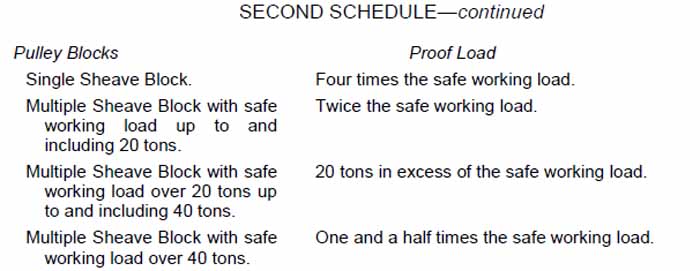
Provided that, where the Chief Inspector of Factories is of the opinion that, owing to the size, design, construction, material or use of any such loose gear or class of such gear, any of the above requirements are not necessary for the protection of persons employed, he may by notice in the Gazette exempt such gear or class of gear from such requirement, subject to such conditions as may be stated in the certificate.
|
| 3. |
Every article of loose gear (whether it is accessory to a machine or not) shall be tested with a proof load at least equal to that shown against the article in the following table—
|
Article of Gear
|
Proof Load
|
|
Chain
|
|
|
Ring
|
|
|
Hook
|
|
|
Shackle
|
|
|
Swivel
|
|
|
..
Twice the safe working load.
|
|
Pulley Blocks
|
Proof Load
|
|
Single Sheave Block.
|
Four times the safe working load.
|
|
Multiple Sheave Block with safe working load up to and including 20 tons.
|
Twice the safe working load
|
|
Multiple Sheave Block with safe working load over 20 tons up to and including 40 tons.
|
20 tons in excess of the safe working load.
|
|
Multiple Sheave Block with safe working load over 40 tons.
|
One and a half times the safe working load.
|
Provided that, where the Chief Inspector of Factories is of the opinion that, owing to the size, design, construction, material or use of any such loose gear or class of such gear, any of the above requirements are not necessary for the protection of persons employed, he may by notice in the Gazette exempt such gear or class of gear from such requirement, subject to such conditions as may be stated in the certificate.
|
| 4. |
After being tested as aforesaid, all machines with the whole of the gear accessory thereto and all loose gear shall be examined, the sheaves and the pins of the pulley blocks being removed for the purpose, to see that no part is injured or permanently deformed by the test.
|
| 5. |
In the case of wire ropes, a sample shall be tested to destruction and the safe working load shall not exceed one-fifth of the breaking load of the sample tested.
|
THIRD
SCHEDULE [Rule 27(2).]
MANNER OF
HEAT-TREATMENT OF CHAINS, RINGS, HOOKS, SHACKLES AND SWIVELS
Chains, rings, hooks, shackles and swivels shall, if made of wrought iron, be annealed by being placed in a suitably constructed furnace and heated uniformly until the whole of the metal has attained a temperature between 1,100 degrees Fahrenheit (600 degrees Centigrade) and 1,200 degrees Fahrenheit (650 degrees Centigrade) and, after being so heated, allowed to cool uniformly:
Provided that if the past history of any such gear is not known, the gear shall be normalized by being placed in a suitably constructed furnace and heated until the whole of the metal has attained a temperature between 1,750 degrees Fahrenheit (950 degrees Centigrade) and 1,830 degrees Fahrenheit (1,000 degrees Centigrade) and, after being so heated, allowed to cool uniformly.
After heat-treatment the gear shall be carefully inspected by a competent person, and details of any defects found shall be entered in the prescribed form.
FOURTH SCHEDULE [Rule 10(1).]
STANDARD FOR FIRST-AID BOXES
First-aid boxes or cupboards shall comply with the following standard—
A. each first-aid box or cupboard shall contain at least—
| (i) |
a copy of the first-aid leaflet (L.D. 250/1) issued by the Labour Department;
|
| (ii) |
a sufficient number (not less than 24) of small sterilized unmedicated dressings for injured fingers;
|
| (iii) |
a sufficient number (not less than 12) of medium-sized sterilized unmedicated dressings for injured hands or feet;
|
| (iv) |
a sufficient number (not less than 12) of large sterilized unmedicated dressings for other injured parts;
|
| (v) |
a sufficient number (not less than 36) of adhesive wound dressings of a suitable type and of assorted sizes;
|
| (vi) |
a sufficient number (not less than 8) of triangular bandages of unbleached calico, the longest side of which measures not less than fifty-one inches and each of the other sides not less than thirty-six inches;
|
| (vii) |
a sufficient supply of adhesive plaster;
|
| (viii |
a sufficient supply of absorbent sterilised cotton wool in half ounce packets;
|
| (ix) |
a sufficient supply of Factory Eye Drops, B.P.C.;
|
| (x) |
a sufficient number (not less than 8) of sterilized eye-pads in separate sealed packets;
|
| (xii) |
a supply of safety pins;
|
B. all materials for drugs and dressings contained in first-aid boxes or cupboards shall be those designated in, and of a grade or quality not lower than the standards specified by, the British Pharmaceutical Codex including any supplement thereto;
C. each first-aid box or cupboard shall be plainly marked “FIRST-AID”
FIFTH SCHEDULE [Rule 30(1).]
PRESCRIPTION OF REGISTER AND FORMS
| 1. |
The register shall be in the form of the register printed and published by the Government Printer-entitled “Register of Machinery, Chains, etc., and Wire Ropes” and bearing the reference “L.D.290”.
|
| 2. |
The certificate of every test, examination or heat-treatment shall be in the form of, and contain the particulars specified in, forms printed and published by the Government Printer, being forms bearing the reference “L.D.” followed by the numbers respectively set out hereunder in relation thereto, that is to say—
| (a) |
for the test and examination of masts and mast stays, winches, derricks and accessory gear, before being taken into use ..................................... L.D. 291
|
| (b) |
for the test and examination of cranes or hoists, and their accessory gear, before being taken into use ....................................................................... L.D. 292
|
| (c) |
for the test and examination of chains, rings, hooks, shackles, swivels and pulley blocks, before being taken into use ................................................. L.D. 293
|
| (d) |
for the test and examination of wire rope, before being taken into use ..... L.D. 294
|
| (e) |
for the heat-treatment of chains, rings, hooks, shackles and swivels which require such treatment ............................................................................... L.D. 295
|
Classes of gear exempted from the requirements of rule 27 as to heat-treatment, under rule 27(2), proviso (ii), of the Factories (Docks) Rules—
| (a) |
chains made of malleable cast iron;
|
| (c) |
chains, rings, hooks, shackles and swivels made of steel;
|
| (e) |
rings, hooks, shackles and swivels permanently attached to pitched chains, pulley blocks or weighing machines;
|
| (f) |
hooks and swivels having screw-threaded parts or ball bearing or other casehardened parts;
|
| (g) |
bordeaux connections,
|
subject to the condition that such gear shall be thoroughly examined by a competent person once at least in every twelve months, and that certificates in the form printed and published by the Government Printer bearing the reference “L.D. 296” and containing the particulars specified in the said form with regard to such examinations shall be obtained and entered in or attached to the prescribed register before the gear to which the certificate refers is subsequently taken into use in connexion with the processes.
For the purposes of this exemption, thorough examination means a visual examination, supplemented if necessary by other means, carried out as carefully as the conditions permit, in order to arrive at a reliable conclusion as to the safety of the parts examined; and if necessary for the purpose, parts of the gear must be dismantled.
|
|
Classes of gear exempted from the requirements of paragraph 3 of the Second Schedule, under paragraph 3 of the Second Schedule to the Factories (Docks) Rules—
| (a) |
pitched chains used with hand-operated pulley blocks and rings, hooks, shackles or swivels permanently attached thereto;
|
| (b) |
hand-operated pulley blocks used with pitched chains and rings, hooks, shackles or swivels permanently attached thereto,
|
subject to the condition that such gear shall have been tested by a competent person with a proof load at least equal to one and a half times the safe working load.
|
Order under section 60
FACTORIES (EXTENSION
OF APPLICATION) ORDER
[L.N. 405/1957,
L.N. 514/1990.]
| 1. |
This Order may be cited as the Factories (Extension of Application) Order.
|
| 2. |
The provisions of the Act hereafter in this Order mentioned shall apply to any premises (not being premises forming part of a factory or premises to which the application of the Act is extended by section 57 or section 58 of the Act) in which a hoist or lift is used, as if the premises were a factory and as if the person having the actual use or occupation of the premises were the occupier of a factory, that is to say—
| (c) |
the provisions of Part V with respect to hoists and lifts and steam boilers, steam receivers and steam containers (including the provisions as to exceptions as to hoists, lifts, steam boilers, steam receivers and steam containers), so, however, that the owner of the hoist, lift, steam boiler, steam receiver or steam container shall, instead of the person deemed to be the occupier, be responsible for any contravention of the said provisions in so far as they relate to matters within his control;
|
| (d) |
the provisions of Part V with respect to the power of a court to make orders as to dangerous conditions and practices;
|
| (e) |
the provisions of Part VII with respect to rules for health, safety and welfare;
|
| (f) |
the provisions of Part IX with respect to general registers (so far as applicable) and preservation of registers and records, subject to such modifications as may be made by rules made by the Minister, and the provisions of the said Part with respect to duties of persons employed;
|
| (g) |
the provisions of Part X with respect to powers and duties of inspectors, and to rules and orders made under the Act;
|
Provided that, where the premises are in the use or occupation of more than one person, the aforementioned provisions of the Act in so far as they relate to hoists and lifts shall apply to the premises as if the owner of the premises, instead of any other person having the actual use or occupation thereof, were the occupier.
|
| 3. |
If a hoist or lift is newly taken into use in any premises (not being premises forming part of a factory or premises to which the application of the Act is extended by section 57 or section 58 of the Act), the person who is for the purposes of this Order the occupier of such premises shall, not later than one month after the date upon which the hoist or lift is first used, send to the Chief Inspector of Factories a written notice of the address at which the hoist or lift is used.
|
| 3. |
If a hoist or lift is newly taken into use in any premises (not being premises forming part of a factory or premises to which the application of the Act is extended by section 57 or section 58 of the Act), the person who is for the purposes of this Order the occupier of such premises shall, not later than one month after the date upon which the hoist or lift is first used, send to the Director of Occupational Health and Safety Services a written notice of the address at which the hoist or lift is used.
|
Order under section 61(1)
FACTORIES (FORM
OF ABSTRACT) ORDER
[L.N. 547/1956, L.N. 514/1990.]
| 1. |
This Order may be cited as the Factories (Form of Abstract) Order.
|
| 2. |
The abstract of the Act required to be kept posted in a prominent position in every factory shall be in the form set out in the Schedule to this Order.
|
SCHEDULE [Paragraph 2, L.N. 514/1990.]
FACTORIES ACT
ABSTRACT OF THE ACT IN FORM PRESCRIBED BY THE MINISTER
To be kept posted in factories at principal entrances or in such parts as an Inspector may direct
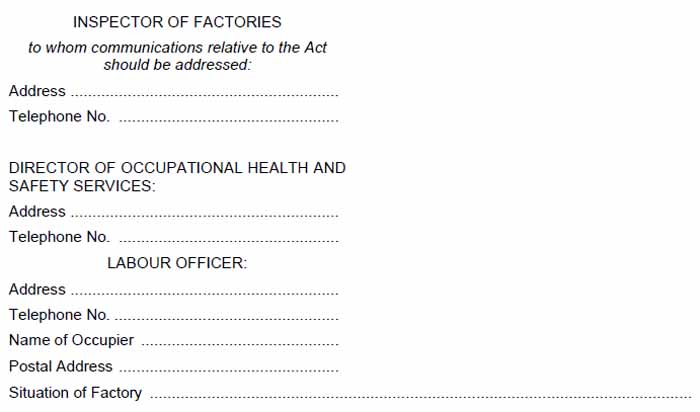
ABSTRACT
HEALTH
| 1. |
Cleanliness.— Every factory must be kept clean. In particular, accumulations of dirt and refuse must be removed daily from floors and benches; the floor of every workroom must be cleaned at least once a week; and all inside walls, partitions and ceilings must (a) if they have a smooth impervious surface, be washed with hot water and soap or cleaned by other approved method every 12 months, or (b) if kept painted with oil paint or varnished, be repainted or revarnished every five years and washed with hot water, etc., every 12 months or (c) in other cases, be whitewashed or colour washed every 12 months. The prescribed particulars must be entered in the general register.
|
| 2. |
Overcrowding.—A factory must not be overcrowded. There must be in each workroom at least 350 cubic feet of space for every person employed, not counting space more than 14 feet from the floor.
|
| 3. |
Every workroom (subject to any exceptions allowed) must be not less than nine feet in height, measured from the floor to the lowest point of the ceiling or, where there is no ceiling, to the lowest point of the roofing material.
|
| 4. |
Ventilation.—Adequate ventilation of workrooms must be secured by the circulation of fresh air.
|
| 5. |
Lighting.—There must be sufficient and suitable lighting in every part of the factory in which persons are working or passing.
|
| 6. |
Drainage of Floors.—Where wet processes are carried on, adequate means for draining the floor must be provided.
|
| 7. |
Sanitary Accommodation.—Sufficient and suitable sanitary conveniences, separate for each sex, must be provided subject to conformity with any standards prescribed by rules.
|
| 8. |
Removal of Dust or Fumes.—Where, in connexion with any process, dust or fume likely to be injurious or offensive, or any substantial quantity of dust of any kind, is given off, all practicable measures must be taken to protect the workers against inhaling it, and where practicable localized exhaust ventilation must be provided and maintained.
|
| 9. |
Meals in Certain Dangerous Trades.—A person must not partake of food or drink in workrooms where any poisonous substance is so used as to give rise to dust or fume.
|
| 10. |
Protective Clothing and Appliances.—Suitable protective clothing and appliances, including, where necessary, suitable gloves, footwear, goggles and head coverings, must be provided and maintained for the use of workers employed in any process involving exposure to wet or to any injurious or offensive substance.
SAFETY
|
| 11. |
Fencing.—Every part of the transmission machinery and every dangerous part of other machinery, and all parts of electric generators, motors and rotary convertors, and flywheels directly connected to them, must be securely fenced unless in such a position or of such construction as to be as safe to every person employed or working on the premises as if securely fenced; and any part of a stock-bar which projects beyond the head-stock of a lathe must be securely fenced unless it is in such a position as to be as safe to every such person as if securely fenced.
|
| 12. |
Moving parts of other prime movers, and flywheels directly connected to them, and the head and tail race of a water wheel or water turbine, must be securely fenced irrespective of their position.
|
| 13. |
Fixed vessels, pits, etc., containing scalding, corrosive or poisonous liquids must, unless the edge is three feet above the adjoining ground or platform, be securely fenced to at least that height or be securely covered; where this is impracticable, other precautions, so far as practicable, must be taken. Fixed vessels, pits, etc., must have a warning notice displayed, in a form readily understood by the persons employed, indicating the nature of the danger.
|
| 14. |
All fencing must be of substantial construction and be maintained in an efficient state.
|
| 15. |
Further Requirements in Connection with Transmission Machinery.—Devices or appliances for promptly cutting off the power from the transmission machinery must be provided in every room or place where work is carried on. Every power-driven machine must be provided with an efficient starting and stopping appliance, the control of which must be readily accessible to the person operating the machine. Efficient mechanical appliances must be provided to move driving-belts to and from fast and loose pulleys. Driving-belts must not rest or ride on revolving shafts when the belt is not in use.
|
| 16. |
New Machines.—New power-driven machines must not be sold, let on hire or used unless certain parts are effectively guarded.
|
| 17. |
Training and Supervision of Inexperienced Workers.—A person must not work at any dangerous machine or in any dangerous process unless—
| (i) |
he has been fully instructed as to the dangers and precautions, and |
| (ii) |
he has received sufficient training in the work or is under adequate supervision. |
|
| 18. |
Protection of Eyes.—Goggles or effective screens must be provided in certain specified processes.
|
| 19. |
Hoists or Lifts.—
Every hoist or lift must be of good mechanical construction, sound material and adequate strength, and be properly maintained. It must be thoroughly examined every six months by a person approved by the Chief Inspector of Factories. A report of the examination must be entered in or attached to the general register.
|
| 19. |
Hoists or Lifts.—Every hoist or lift must be of good mechanical construction, sound material and adequate strength, and be properly maintained. It must be thoroughly examined every six months by a person approved by the Director of Occupational Health and Safety Services. A report of the examination must be entered in or attached to the general register.
|
| 20. |
Every hoistway must be efficiently protected by a substantial enclosure and landing gates with efficient interlocking or other devices. The safe working load must be marked conspicuously on each hoist. Additional safeguards (eg. interlocking gates for cages) must be provided on hoists used for carrying persons, whether with goods or otherwise. The requirements are somewhat less stringent in the case of hoists not connected with mechanical power.
|
| 21. |
Chains and Ropes and Lifting Tackle.—
No chain, rope or lifting tackle used for raising or lowering persons or goods may be used unless it is of good construction, sound material and adequate strength, and free from patent defect. Tables of safe working loads must be prominently displayed on the premises, but need not cover any lifting tackle the safe working load of which is marked on the tackle itself. Chains, ropes and lifting tackle in use must be thoroughly examined by a person approved by the Chief Inspector of Factories every six months, and must not (excepting fibre ropes and fibre rope slings) be taken into use for the first time in the factory unless they have been tested and certified.
|
| 21. |
Chains and Ropes and Lifting Tackle.—No chain, rope or lifting tackle used for raising or lowering persons or goods may be used unless it is of good construction, sound material and adequate strength, and free from patent defect. Tables of safe working loads must be prominently displayed on the premises, but need not cover any lifting tackle the safe working load of which is marked on the tackle itself. Chains, ropes and lifting tackle in use must be thoroughly examined by a person approved by the Director of Occupational Health and Safety Services every six months, and must not (excepting fibre ropes and fibre rope slings) be taken into use for the first time in the factory unless they have been tested and certified.
|
| 22. |
Periodic annealing is required, except in the case of ropes and rope slings and other tackle exempted by the Chief Inspector of Factories.
|
| 22. |
Periodic annealing is required, except in the case of ropes and rope slings and other tackle exempted by the Director of Occupational Health and Safety Services.
|
| 23. |
A register of all chains, etc., and also the certificates of tests, must be kept.
|
| 24. |
Cranes, etc.—
All parts and working gear (including anchoring appliances) of cranes and other lifting machines must be of good construction, sound material and adequate strength, and must be properly maintained. A thorough examination of all such parts by a person approved by the Chief Inspector of Factories must be made every fourteen months. A lifting machine must not be taken into use for the first time in the factory unless it has been tested and certified. A register of examinations and tests must be kept. The safe working load or loads must be shown on every lifting machine; in the case of cranes with a derricking jib, an automatic indicator or a table of safe working loads must be attached to the crane.
|
| 24. |
Cranes, etc.—All parts and working gear (including anchoring appliances) of cranes and other lifting machines must be of good construction, sound material and adequate strength, and must be properly maintained. A thorough examination of all such parts by a person approved by the Director of Occupational Health and Safety Services must be made every fourteen months. A lifting machine must not be taken into use for the first time in the factory unless it has been tested and certified. A register of examinations and tests must be kept. The safe working load or loads must be shown on every lifting machine; in the case of cranes with a derricking jib, an automatic indicator or a table of safe working loads must be attached to the crane.
|
| 25. |
Rails and tracks of travelling cranes and transporters must be of proper size and construction. If any person is working near the wheel-track of an overhead travelling crane, steps must be taken to ensure that the crane does not approach within 20 feet.
|
| 26. |
Construction of Floors, Precautions Against Falls, etc.—Floors, passages, gangways, steps, stairs and ladders must be soundly constructed and properly maintained, and handrails must be provided for stairs.
|
| 27. |
So far as is reasonably practicable, there must be provided—
| (i) |
safe means of access to every place at which any person has at any time to work; and |
| (ii) |
fencing or other means for ensuring the safety of any person who is to work at a place from which he would be liable to fall more than ten feet and which does not afford secure foot-hold and, where necessary, secure hand-hold. |
|
| 28. |
Every teagle opening or similar doorway used for hoisting or lowering goods must be fenced (except when the hoisting or lowering is going on at that opening), and be provided with a hand-hold on each side of the opening.
|
| 29. |
Precautions Against Gassing.—Special precautions are laid down for work in confined spaces where men are liable to be overcome by dangerous fumes.
|
| 30. |
Explosions of Inflammable Dust or Gas.—Precautions against explosions are laid down for certain processes and for welding or soldering on containers which have held any explosive or inflammable substance.
|
| 31. |
Steam Boilers, Steam Receivers, etc.—Every part of every steam boiler and steam receiver must be of good construction, sound material and adequate strength, and free from patent defect. Detailed requirements are laid down as to the valves and other fittings. The outlet of every steam container must at all times be kept open and free from obstruction.
|
| 32. |
Steam boilers and steam receivers and their fittings must be properly maintained, and must be thoroughly examined by an authorised boiler inspector, in the case of boilers every fourteen months and also after extensive repairs, and in the case of steam receivers every twenty-six months. A report of each examination must be attached to the general register. New or second-hand boilers must be examined before being taken into use.
|
| 33. |
Air Receivers.—Every air receiver and its fittings must be of sound construction and properly maintained. Detailed requirements are laid down as to the fittings.
|
| 34. |
Air receivers must be thoroughly cleaned, and must be examined or tested every twenty-six months by a person approved by the Chief Inspector of Services, and a report entered in or attached to the general register. In some cases a longer period is allowed.
|
| 34. |
Air receivers must be thoroughly cleaned, and must be examined or tested every twenty-six months by a person approved by the Director of Occupational Health and Safety Services, and a report entered in or attached to the general register. In some cases a longer period is allowed.
|
| 35. |
Fire.—Adequate and suitable means for extinguishing fire must be provided in every factory.
|
| 36. |
Adequate means of escape in case of fire must be provided. While any person is in the factory for the purpose of employment or meals, doors must not be so locked or fastened that they cannot be easily and immediately opened from the inside. In the case of newly constructed or converted factories, all doors affording a means of exit from the factory must be sliding doors or open outwards. Fire exits must be marked by a notice printed in red letters of adequate size. Effective steps must be taken to ensure that the workers are familiar with the means of escape and the routine to be followed in case of fire.
WELFARE
|
| 37. |
Drinking Water.—An adequate supply of wholesome drinking water must be provided.
|
| 38. |
Washing Facilities.—Adequate and suitable washing facilities must be provided and maintained.
|
| 39. |
Accommodation for Clothing.—Adequate and suitable accommodation for clothing not worn during working hours must be provided.
|
| 40. |
Facilities for Sitting.—Suitable facilities for sitting must be provided for all female workers whose work is done standing, sufficient to enable them to take advantage of any opportunities for resting.
|
| 41. |
First-aid.—In every factory there must be provided a first-aid box or cupboard of the prescribed standard, containing nothing except first-aid requisites, and in charge of a responsible person who must be always readily available during working hours. In every workroom a notice must be affixed stating the name of the person in charge of the box or cupboard provided in respect of that room. Where more than 150 persons are employed at one time, an additional box or cupboard for every additional 150 persons or fractions of that number is required.
GENERAL
|
| 42. |
Duties of Persons Employed.—A person employed must not wilfully interfere with or misuse any means, appliance, convenience or other thing provided in pursuance of the Act for securing health, safety or welfare, and he must use any means or appliance for securing health or safety provided for his use under the Act. He must not wilfully and without reasonable cause do anything likely to endanger himself or others.
|
| 43. |
Registration.—
Before any premises are occupied or used as a factory, a certificate of registration must be obtained from the Chief Inspector of Factories.
|
| 43. |
Registration.—Before any premises are occupied or used as a factory, a certificate of registration must be obtained from the Director of Occupational Health and Safety Services.
|
| 44. |
General Register.—The occupier must keep a general register in the prescribed form.
|
| 45. |
Rules for Health, Safety and Welfare.—Rules made for particular industries, processes, plant, etc., must be observed, and printed copies or prescribed abstracts of all such rules in force in any factory must be kept posted in the factory.
|
| 46. |
Inspection.—Inspectors of factories have power to inspect every part of a factory by day or by night. They may require the production of registers, certificates and other papers. They may examine any person found in the factory, either alone or in the presence of any other person as they think fit, and may require him to sign a declaration of the truth of the matter about which he is examined. They may also exercise such other powers as may be necessary for carrying the Act into effect, including certain powers of taking samples for analysis. Every person obstructing an inspector is liable to a penalty.
|
Order under
section 62(1)
FACTORIES (GENERAL
REGISTER) ORDER
[G.N. 973/1951.]
| 1. |
This Order may be cited as the Factories (General Register) Order.
|
| 2. |
The general register required to be kept in every factory in pursuance of subsection (1) of section 62 of the Act shall be in the form of the register printed and published by the Government Printer and bearing the reference “L.D. Form 206”. [Rule 30(1).]
|
FACTORIES AND OTHER PLACES OF WORK (SAFETY AND HEALTH COMMITTEES) RULES
ARRANGEMENT OF RULES
| 4. |
Formation of Committees.
|
| 5. |
Organization of the Committee.
|
| 6. |
Functions and duties of the Committees.
|
| 7. |
Meetings and minutes of the Committee.
|
| 8. |
Rules in the Committee.
|
| 9. |
Duties of the occupier.
|
| 10. |
Approval of advisers.
|
| 11. |
Duties of a registered safety and health adviser.
|
| 12. |
Training of the Committee.
|
| 13. |
Health and safety audit.
|
| 14. |
Offence in relation to audit.
|
FACTORIES AND
OTHER PLACES OF WORK (SAFETY AND HEALTH COMMITTEES) RULES, 2004
[L.N. 31/2004.]
| 1. |
Citation
These Rules may be cited as the Factories and Other Places of Work (Safety and Health Committees) Rules, 2004.
|
| 2. |
Interpretation
In these Rules, except where the context otherwise requires—
“audit” means periodic evaluation of working environment and organizational management systems in a factory or workplace for prevention of accidents, occupational diseases, ill-health or damage to property;
“chairman” means the chairman referred to in rule 5(5);
“Committee” means a Safety and Health Committee established pursuant to section 65A of the Act;
“competent person”, in relation to any duty or function, means a person who has had adequate training, relevant qualifications and experience to enable him to perform that duty or function;
“director” means the Director of Occupational Health and Safety Services appointed under the Act;
“management” means the occupier and the administrative staff of a factory;
“occupational and health and safety officer” means an officer appointed under section 68 of the Act;
“occupier” means the person or persons in actual occupation of a factory, whether as the owner or not;
“regular employee” means a person employed on permanent, temporary, or contract terms, including contractors or suppliers, and “regularly employ” shall be construed accordingly;
“workplace” includes any land, premises, location, vessel or thing at, in, upon, or near which a worker performs his duty in accordance with his contract of employees.
|
| 3. |
Application
These Rules shall apply to all factories and other workplaces which regularly employ twenty or more employees.
|
| 4. |
Formation of Committees
| (1) |
The occupier of every factory or other workplace to which these Rules apply shall establish a Safety and Health Committee in the manner provided in these Rules.
|
| (2) |
A Safety and Health Committee shall consist of safety representatives from the management and the workers in the following proportions—
| (a) |
in the case of factories or other workplaces with between twenty and one hundred regular employees, not less than three safety representatives each from the management and the workers;
|
| (b) |
in the case of factories or other workplaces with between one hundred and one thousand regular employees, not less than five safety representatives each from the management and the workers and;
|
| (c) |
in the case of factories or other workplaces with one thousand or more regular employees, not less than seven safety representatives each from the management and the workers.
|
|
| (3) |
The occupier shall, not later than six months after the coming into operation or these Rules, appoint a competent person, being a member of the management staff, to be responsible for safety, health and welfare in the factory or workplace.
|
| (4) |
The person appointed under subrule (3) shall be the Secretary to the Committee.
|
|
| 5. |
Organization of the Committee
| (1) |
The safety representatives from—
| (a) |
the management, shall include the occupier or his duly authorized representative, and other persons appointed for the purpose of these Rules by the occupier; and
|
| (b) |
the workers, shall be elected in accordance with subrule (2).
|
|
| (2) |
The occupier shall organize and oversee the election of the representatives of the workers on the Committee, following a procedure agreed upon between the occupier and the workers.
|
| (3) |
The occupier shall, in overseeing elections under subrule (2), ensure, as far as possible—
| (a) |
equitable representation of departments or units which are detached from the main office; and
|
|
| (4) |
Safety representatives shall serve on the Committee for a term of three years and shall be eligible for re-election or re-appointment for one further term.
|
| (5) |
The occupier, or the occupier’s duly authorized representative, shall be the chairman of the Committee.
|
|
| 6. |
Functions and duties of the Committees
The functions of the Committee shall be to—
| (a) |
establish a schedule of inspection of the workplace for each calendar year;
|
| (b) |
conduct safety and health inspections at lease once in every three months;
|
| (c) |
inspect, investigate and make recommendations to the occupier immediately any accident or dangerous occurrence takes place;
|
| (d) |
identify occupational hazards and cases of ill-health among workers at the workplace and make appropriate recommendations to the occupier;
|
| (e) |
compile statistics of accidents, dangerous occurrences and cases of ill-health as primary data for providing remedial measures, planning and allocation of resources;
|
| (f) |
investigate complaints relating to workers’ health, safety and welfare at the workplace and make representations to the occupier on their findings;
|
| (g) |
advise on the adequacy or otherwise of safety and health measures for particular hazardous work or activities;
|
| (h) |
establish effective communication channels on matters of health and safety between the management and the workers;
|
| (i) |
organize such contest or activities necessary for achieving the fulfilment of the mandate of the Committee;
|
| (j) |
conduct seminars and workers’ education programmes and provide information for safety, health and welfare at the workplace; and
|
| (k) |
carry out any other functions necessary for the promotion of a safe and healthy working environment.
|
|
| 7. |
Meetings and minutes of the Committee
| (1) |
The Committee shall meet not less than four times in every year, and not more than three months shall elapse between the date of one meeting and the date of the next meeting.
|
| (2) |
(a) Notwithstanding subrule (1), the chairman shall convene a meeting of
|
the Committee within twenty-four hours following any accident or other dangerous occurrence, or the outbreak of an unusual illness, at the workplace.
|
| (b) |
The minutes of a meeting convened under subparagraph (a) shall be forwarded to the director within seven days from the date of the meeting.
|
|
| (3) |
Without prejudice to the foregoing, the chairman of a Committee may, at any time of his own motion, convene a meeting of the Committee, and shall on the application of at least six members, convene a special meeting of the Committee.
|
| (4) |
(a) The quorum of a meeting of the Committee shall be not less than two
|
thirds of the members representing employees and one third of those representing the management.
|
| (b) |
The director or his representative may, on his own initiative or upon invitation by the chairman, attend a meeting of the Committee.
|
|
| (5) |
At least seven days’ written notice of every meeting of the Committee shall be given to every member of the Committee.
|
| (6) |
The Committee may invite on an ad hoc basis to its meetings, or interview, any person it believes to have information in relation to any matter which is being considered by the Committee.
|
| (7) |
The Committee may co-opt into its membership one or more persons by reason of their particular knowledge or experience in health and safety matters as an advisory member of the Committee, but such co-opted member shall not be entitled to vote.
|
| (8) |
The Secretary of the Committee shall in the course of exercising his functions as such, cause a summary of the minutes of every meeting, giving the final decisions and plans of actions arrived at during the meetings, to be posted at a prominent place so as to be easily accessible to the workers.
|
| (9) |
The director may require the occupier to furnish his office with a schedule of the meetings of the Committee for each year or part thereof, and the proceedings of the same.
|
|
| 8. |
Rules in the Committee
| (a) |
The chairman of the Committee shall—
| (i) |
preside over all Committee meetings at which he is present; |
| (ii) |
keep the members informed of the safety and health policy of the factory or workplace; |
| (iii) |
assist the Committee in setting its objectives and its scope of activities; and |
| (iv) |
assign responsibilities to members. |
|
| (b) |
The Secretary to the Committee shall—
| (i) |
arrange and co-ordinate Committee meetings in consultation with the chairman; |
| (ii) |
take minutes at Committee meetings; |
| (iii) |
maintain an up to date record of the activities of the Committee; |
| (iv) |
obtain and analyse statistics for Committee meetings; |
| (v) |
co-ordinate and monitor occupational safety and health programmes; |
| (vi) |
disseminate safety and health information to members; |
| (vii) |
draw up safety and health information to members; |
| (viii) |
ensure that all reports arising from the functions of the Committee, from the Director, or persons approved under these Rules or under the Act, are availed to the Committee. |
|
| (c) |
The members of the Committee shall—
| (i) |
attend all Committee meetings; |
| (ii) |
provide feedback to their departments or units on safety, health and welfare issues raised in the meetings; |
| (iii) |
set good examples of safe and healthy work practises; |
| (iv) |
monitor compliance with safety and health rules in their respective departments or units; |
| (v) |
participate in the training of workers in matters related to health and safety; |
| (vi) |
carry out any other activities necessary for the promotion of occupational safety, health and welfare in the workplace; and |
| (vii) |
provide written recommendations to the occupier on areas and issues requiring action following inspections carried out under these Rules. |
|
|
| 9. |
Duties of the occupier
| (a) |
provide, at no cost to the Committee, a suitable venue and other facilities for holding Committee meetings;
|
| (b) |
allow members to attend the meetings and other functions of the Committee without loss of earnings, opportunities for promotion or advancement;
|
| (c) |
ensure that all safety representatives undertake training courses organized for purposes of these Rules;
|
| (d) |
provide the Committee with—
| (i) |
any information or report on any accidents, dangerous occurrences or incidents or occupational diseases immediately it comes to his knowledge; |
| (ii) |
statistics of accidents, dangerous occurrences, and incidents of occupational diseases; |
| (iii) |
all the necessary or relevant information on hazardous substances; |
| (iv) |
safety and health reference materials and facilities; |
|
| (e) |
cause the monitoring and evaluation of hazards and risks identified by the Committee to be carried out by a competent person;
|
| (f) |
develop a clearly defined safety and health policy and bring it to the notice of all employees at the workplace, and send a copy of the policy to the director;
|
| (g) |
facilitate the implementation and review of the organization’s safety and health policy;
|
| (h) |
make available to the Committee legislation on occupational safety and health;
|
| (i) |
make a report to the director on all accidents as required under the Act;
|
| (j) |
chair meetings, and, in his absence, delegate the function to a senior member of the management;
|
| (k) |
cause further specialized evaluation as necessitated by the audit report in regard to medical examination of the workers, testing and examination of plant and equipment, monitoring of the work environment or other scope whenever he is required to do so in writing by the Director;
|
| (l) |
cause to be maintained a record of the proceedings of Committee meetings and reports of the audit referred to in these Rules; and
|
| (m) |
ensure that all matters set out in these Rules are complied with.
|
|
| 10. |
Approval of advisers
| (1) |
The Director may invite applications by competent persons, for approval to serve as safety and health advisers.
|
| (2) |
A person shall be qualified to be a safety and health adviser if such person holds a minimum qualification of a certificate in occupational safety and health from a recognised institution and has proven practical experience in this field for a period of five years.
|
| (3) |
The Director shall consider all applications received and approve suitable persons to serve as health and safety advisers for purposes of these Rules.
|
| (4) |
The Director shall, by notice in the Gazette, notify the appointments made under subrule (3), and maintain a register of all persons appointed thereunder.
|
| (5) |
Every adviser shall be issued with a certificate by the director, upon payment of the prescribed fee.
|
| (6) |
The certificate issued under subrule (4) shall be renewable annually.
|
|
| 11. |
Duties of a registered safety and health adviser
| (1) |
The safety and health adviser shall—
| (a) |
carry out safety and health audits of the factory or workplace at the request of the occupier;
|
| (b) |
advise the occupier and the members of the Committee on matters relating to occupational health and safety arising from the audit report;
|
| (c) |
submit a copy of the audit report to the director.
|
|
|
| 12. |
Training of the Committee
| (1) |
Every member of the Committee shall undertake a prescribed basic training course in occupational health and safety within a period of six months from the date of appointment or election, as the case may be, and thereafter further training from time to time.
|
| (2) |
The training course referred to in subrule (1) shall be in such form and in such institutions as may be approved by the director.
|
| (3) |
The director may, on application, exempt any person from undertaking the training courses referred to in subrule (1) where the director is satisfied that the applicant is suitably qualified for the purposes of these Rules.
|
| (4) |
The Director shall, once every year, publish in the Gazette a list of the institutions approved for purposes of subrule (2).
|
|
| 13. |
Health and safety audit
| (1) |
The occupier of every factory or workplace shall cause a health and safety audit of the workplace to be carried out at least once in every period of twelve months by a registered health and safety adviser at such fee as may be agreed upon with such adviser.
|
| (2) |
The report of the audit shall be kept by the occupier for purposes of these Rules and a copy of the same shall be sent to the director by the adviser within a period of thirty days following the audit.
|
|
| 14. |
Offence in relation to audit
| (1) |
Any person authorised to carry out an audit under these Rules who—
| (a) |
fails to make a report as required by these Rules;
|
| (b) |
makes a report which is false or deficient in its technical content; or
|
| (c) |
fails to send to the director a copy of any report as required,
|
shall be guilty of an offence and liable to a fine not exceeding fifty thousand shillings or to imprisonment for a term not exceeding three months, or to both such fine and imprisonment.
|
|
| 15. |
Other offences
Any occupier, or any other person who contravenes any of these Rules, shall be guilty of an offence and liable to a fine not exceeding fifty thousand shillings.
|
FACTORIES AND OTHER PLACES OF WORK (MEDICAL EXAMINATION) RULES, 2005
ARRANGEMENT OF RULES
| 4. |
Occupations requiring medical examination.
|
| 5. |
Duties of employer and employees as to medical examination.
|
| 6. |
Reports on examination.
|
| 7. |
Certificate of redeployment.
|
| 8. |
Certificate of fitness.
|
| 10. |
Offences and penalties.
|
SCHEDULES
| FIRST SCHEDULE — |
OCCUPATIONS REQUIRING MEDICAL EXAMINATION(S)
|
| SECOND SCHEDULE — |
SUMMARY REPORT FORM
|
| THIRD SCHEDULE — |
CERTIFICATE OF RE-DEPLOYMENT
|
| FOURTH SCHEDULE — |
CERTIFICATE OF FITNESS
|
| FIFTH SCHEDULE — |
NOTIFICATION FORM
|
FACTORIES AND
OTHER PLACES OF WORK (MEDICAL EXAMINATION) RULES, 2005
[L.N. 24/2005.]
| 1. |
Citation
These Rules may be cited as the Factories and Other Places of Work (Medical Examination) Rules, 2005.
|
| 2. |
Interpretation
In these Rules except where the context otherwise requires—
“designated” health practitioner” means any medical practitioner whether a public officer or not who is authorized by the director, by certificate in writing, to carry out examination of workers in accordance with, and for the purposes of these Rules;
“directorate” means the directorate of occupational health and safety services;
“employee” means a person who has entered into or works under a contract of service or of apprenticeship or learnership, with an employer whether the contract is express or implied, oral or in writing and whether the remuneration is calculated by time or by work done or is in cash or in kind;
“employer” includes owner and/or occupier;
“medical examination” means examination of workers exposed to specified occupational hazards indicated in the First Schedule to these Rules for the purpose of prevention and control of occupational diseases;
“occupational diseases” means any departure from health occasioned by exposure to any factor or hazard in the workplace;
“workplace” includes any land, premises, location, vessel or thing at, in, upon or near where an employee is, in the course of employment.
|
| 3. |
Application
These Rules shall apply to medical examination of all those employees in employment or have been in employment in every workplace, to which the provisions of the Act apply.
|
| 4. |
Occupations requiring medical examination
| (1) |
It shall be the duty of the employer to ensure that all persons employed in any of the occupations outlined in the Eighth Schedule to the Act undergo both pre-employment and periodic medical examinations by the designated health practitioner as outlined in the First Schedule.
|
| (2) |
The fees to be charged by the designated health practitioner shall be as prescribed by the director.
|
| (3) |
The Minister may, in the Gazette, publish any other work involving risk to the health of the employees.
|
| (4) |
Any employer who does not comply with paragraph (1) shall commit an offence.
|
|
| 5. |
Duties of employer and employees as to medical examination
| (1) |
The employer shall ensure that the examination takes place without any loss of earnings for the employees and if possible within normal working hours during their employment.
|
| (2) |
The costs in connection with such examination shall be paid by the employer.
|
| (3) |
The employees and former employees shall be under an obligation to undergo examination in accordance with these Rules.
|
| (4) |
Any person who contravenes this provision shall commit an offence.
|
|
| 6. |
Reports on examination
| (1) |
Results of the examination shall be entered into each individual’s medical record by the designated health practitioner and shall be updated with each examination whenever repeat tests are carried out.
|
| (2) |
Summary report forms as outlined in the Second Schedule shall be completed after medical examination for each hazard and shall be submitted within twenty-one days to the director and a copy sent to the employer.
|
| (3) |
If there is more than one hazard in the same workplace, separate summary report forms shall be used for each hazard.
|
|
| 7. |
Certificate of redeployment
| (1) |
If it is desirable that an employee be removed from further exposure to a particular hazard, the certificate of redeployment as outlined in the Third Schedule shall be filled and completed in triplicate by the designated health practitioner and a copy sent to the employer, employee and the director within seven days from the date of the examination.
|
| (2) |
In these Rules, unless where it is otherwise indicated, all abnormal examination results shall be repeated within two weeks to ensure consistency.
|
|
| 8. |
Certificate of fitness
| (1) |
Examination results for persons entering employment or those returning from sick leave occasioned by occupational diseases shall be entered into the certificate of fitness as outlined in the Fourth Schedule, which shall be kept by the designated health practitioner, and a copy thereof given to the employee.
|
| (2) |
If an employee is exposed to more than one of the specified hazards, a separate certificate of fitness shall be completed for each hazard.
|
|
| 9. |
Notification
| (1) |
The provisions of section 45 regarding the notification of occupational diseases shall apply mutatis mutandis for all abnormal results as if they were set out therein.
|
| (2) |
Notification shall contain particulars as outlined in the notification form in the Fifth Schedule.
|
|
| 10. |
Offences and penalties
Any person who contravenes these Rules shall commit an offence and the provisions of the Act on offences and penalties shall mutatis mutandis apply.
|
FIRST SCHEDULE [Rule 4).]
OCCUPATIONS REQUIRING MEDICAL EXAMINATION(S)
SECOND SCHEDULE [Rule (6)(2).]
SUMMARY REPORT FORM
This form should be completed by the designated health practitioner and submitted to the director within twenty one days and a copy sent to the employer.
Name of workplace: ...............................................................................................
Workplace registration No. ....................................................................................
Location: .................................................................................................................
Tel: .................................................... Fax: .............................................................
Address: .................................................................................................................
Email: ......................................................................................................................
Type of risk to health: .............................................................................................
Number of workers exposed: ................................................................................
RESULTS OF EXAMINATIONS
Number of employees examined: ...........................................................................
Number of employees with abnormal results: .........................................................
(a) Occupational diseases: ...................................................................................
(b) Non-occupational disease(s): ..........................................................................
Number of employees recommended for re-deployment ....................................................
I certify that the information given above is correct. Particulars of all workers with abnormal results including those recommended for re-deployment are attached.
Name of Designated Health Practitioner: .......................................................................
Approved Registration No: ............................................................................................
Address: .............................................................................................................................
Physical address of office: ...............................................................................................
Tel. ........................................................... Fax: ............................................................
E-mail: .................................................................................................................
Signature: ..............................................................................................................
Date: .....................................................................................................................
THIRD SCHEDULE [Rule (7).]
CERTIFICATE OF RE-DEPLOYMENT
This form should be filled in triplicate by the designated health practitioner and a copy sent within seven days to the employer, employee and the director.
| 1. |
Name of employee (as per identity card) .............................................................
|
| 2. |
Employment number .............................................................................................
|
| 3. |
ID/passport No. ......................................................................................................
|
| 4. |
Date of birth .............................................. Sex .......................................................
|
| 5. |
Name and Address of workplace ..............................................................................
|
| 6. |
Type of risk to health present .........................................................................
|
| 7. |
Duration of exposure ...................................................................................
|
I Certify that the above named person examined by me on this ............ day of ......................... should not continue to work as .................................for ......................... months, subject to a review on this ....................... day of ..............................
In the meantime, the employee should be given alternative work in another area which does not expose him/her to the above mentioned health risk. The reasons for my recommendations are as follows:
...............................................................................................................................................................................................................................................................................
Date: ..................................... Signature: ................................................
Name of Designated health practitioner: ....................................................
Approved registration no. ..........................................................................
Address: .....................................................................................................
Physical address of office ....................... Tel ......................................................
Fax ..................................... E-mail ........................................................
FOURTH SCHEDULE [Rule (8).]
CERTIFICATE OF FITNESS
This form should be filled by the designated health practitioner for all those entering employment or returning from sick leave occasioned by an occupational disease as applicable.
| 1. |
Name of employee examined .................................................................
|
| 2. |
ID/Passport No. ...................................................................................................
|
| 3. |
Employment No. ...............................................................................................
|
| 4. |
Date of Birth ............................................. Sex .........................................................
|
| 5. |
Name and Address of employer ................................................................................
|
| 6. |
Examinations/Test done ............................................................................................
.............................................................................................................................
.............................................................................................................................
.............................................................................................................................
|
I hereby certify I have examined the above employee on ............ this day of .................... and that he/she is fit/not fit
Remarks: ........................................................................................................
....................................................................................................................
....................................................................................................................
Signature ......................................... Date ....................................................
Name and Address of Designated Health Practitioner ....................................
.....................................................................................................................
Approved Registration No. ......................................................................
Address: ..................................................................................................
Physical Location of office ...........................................................................
Tel. ................................................................................................
Fax ................................................................................................
E-mail ........................................................................................................
FIFTH SCHEDULE [Rule 9.]
NOTIFICATION FORM
This form shall be completed and forwarded to the director by a designated health practitioner or any medical practitioner attending to or called in to visit a patient whom he believes to be suffering from an occupational disease.
| 1. |
Name of patient .............................................................................................
|
| 2. |
ID/Passport No. ............................................................................................
|
| 3. |
Employment No. ...........................................................................................
|
| 4. |
Date of Birth ............................................ Sex ...............................................
|
| 5. |
Residential address ..................................................................................
|
| 6. |
Name and Address of employer .......................................................................
|
| 7. |
Present occupation .............................................................................................
|
| 8. |
Number of years worked in present occupation ......................................................
|
| 9. |
Diagnosis ..............................................................................................................
|
| 10. |
If patient was previously seen by occupational Health Practitioner, state date of last attendance ...................................................................................................
|
| 11. |
Name of designated health practitioner/Medical practitioner ..................................................................................................................................................
|
| 12. |
Approved registration number where applicable .......................................................
|
| 13. |
Name and address of Hospital/Clinic ........................................................................................
Tel. No. ........................................................ E-mail ............................................
Fax ......................................................................................................................
|
| 14. |
Medical practitioner’s reference file No. for patient ...............................................
|
Signature .............................................. Date ....................................................
FACTORIES AND OTHER PLACES OF WORK (NOISE
PREVENTION AND CONTROL) RULES, 2005
ARRANGEMENT OF RULES
| 4. |
Permissible noise level.
|
| 5. |
Noise prevention programme.
|
| 6. |
Noise measurements and records.
|
| 7. |
Information and training of workers.
|
| 10. |
Installation and maintenance of machinery or plant.
|
| 11. |
Means of communication.
|
| 14. |
Workers responsibility in noise hazard areas.
|
| 16. |
Medical examination and hearing tests.
|
| 17. |
Compensation and notification of occupational hearing impairment.
|
| 19. |
Offences and penalties.
|
FACTORIES AND
OTHER PLACES OF WORK (NOISE PREVENTION AND CONTROL) RULES, 2005
[L.N. 25/2005.]
| 1. |
Citation
These Rules shall be cited as Factories and Other-Places of Work (Noise Prevention and Control) Rules, 2005.
|
| 2. |
Interpretation
In these Rules except where the context otherwise requires—
“A-weighted filter” means an electronic circuit whose sensitivity to sound pressure levels varies in the same way as the human ear;
“daily exposure” means the amount of noise stated in dB(A) to which a person is exposed during work day;
“dB(A)” means decibels of noise, measured with an A-weighted filter;
“director” means the Director of Occupational Safety and Health Services;
“directorate” means the directorate of occupational health and safety services;
“machinery” includes machines tools and other technical devices used at the place of work;
“noise” means all sound energy which can result in hearing impairment or be harmful to health or otherwise dangerous;
“peak sound level” means the maximum instantaneous sound level in dB(A);
“worker” includes a person who has entered into or works under a contract of service or apprenticeship, written or oral, express or implied, whether by way of manual labour or otherwise;
“workplace” includes any land, premises, location, vessel or thing at, in, upon or near which a worker performs his duty in accordance with his contract of employment.
|
| 3. |
Application
| (1) |
These Rules shall apply to every factory, premises, place, process and operations to which the provisions of the Act apply.
|
| (2) |
Every occupier shall comply with these Rules and every agent, worker and any other person in the workplace shall conduct his work in accordance with these Rules.
|
|
| 4. |
Permissible noise level
| (1) |
No worker shall be exposed to a noise level in excess of—
| (a) |
the continuous equivalent of ninety dB(A) in eight hours within any twenty four hours duration; and
|
| (b) |
one hundred and forty dB(A) peak sound level at any given time.
|
|
| (3) |
Where noise is intermittent, noise exposure shall not exceed the sum of the partial noise exposure equivalent continuous sound level of ninety dB(A) in eight hour duration within any twenty four hours duration.
|
| (4) |
(a) It shall be the duty of the occupier to ensure that noise that gets transmitted
|
outside the workplace shall not exceed fifty five dB(A) during the day and forty-five dB(A) during the night; and
|
| (b) |
any person who does not comply with this provision shall commit an offence.
|
|
|
| 5. |
Noise prevention programme
| (1) |
Where noise in a workplace exceeds the continuous equivalent of eighty five dB(A) the occupier must develop and implement an effective noise control and hearing conservation programme.
|
| (2) |
The programme must be in writing and should address—
| (c) |
engineering noise control;
|
| (e) |
posting of notices in noisy areas;
|
|
| (3) |
The occupier shall maintain in a manner acceptable to the director a record of the hearing tests for each worker which must be—
| (a) |
kept as long as the worker is employed by the employer and not less than two years; and
|
| (b) |
treated as confidential and not released to anyone without the written permission of the worker.
|
|
|
| 6. |
Noise measurements and records
| (1) |
(i) It shall be the duty of the occupier to carry out measurements of noise at
|
least once in every period of twelve months in order to determine the prevailing noise conditions. |
| (ii) |
Whenever any facility, equipment, working process or working method has been changed, noise measurements shall be carried out. |
|
| (2) |
Noise exposure measurement results shall be recorded and specify—
| (a) |
the date and time of the noise measurement;
|
| (b) |
the names and numbers of workers exposed;
|
| (c) |
types of occupations evaluated;
|
| (g) |
recommended remedial measures taken; and
|
| (h) |
name of person taking the measurements.
|
|
| (3) |
The results of the measurements carried out as required under paragraph (2) shall be kept by the occupier for a period of two years or such other period as may be prescribed by the director and shall be communicated to the workers if requested.
|
| (4) |
The director may issue guidelines on how monitoring of noise shall be carried out.
|
|
| 7. |
Information and training of workers
| (1) |
The occupier shall inform in writing all the workers in any process where noise level is below ninety dB(A) on—
| (a) |
the results of any noise exposure measurements;
|
| (b) |
the significance of those results to the risk of hearing loss; and
|
| (c) |
at the request of the worker, the purpose of hearing protection and testing.
|
|
| (2) |
The occupier shall inform in writing all workers exposed to noise above ninety dB(A) on the—
| (a) |
results of any noise exposure measurements;
|
| (b) |
effects of noise on hearing;
|
| (c) |
proper use and maintenance of hearing protection; and
|
|
| (3) |
The occupier shall ensure that all workers exposed to noise are fully trained on the hazards involved, and instructed in the measures available for the prevention, control and protection against noise exposure.
|
|
| 8. |
Equipment
It shall be the responsibility of the occupier to ensure that all noise measuring equipment are regularly calibrated, maintained, inspected and operated according to manufacturer’s instructions.
|
| 9. |
Engineering controls
| (a) |
take suitable engineering noise reduction measures at the source of the noise to reduce it and limit its spreading;
|
| (b) |
adopt methods of work, which shall reduce noise exposure of workers to the recommended noise levels; and
|
| (c) |
as far as practicable, walls and ceilings of workplaces shall be lined with suitable sound absorbing material to prevent reflection of noise.
|
|
| 10. |
Installation and maintenance of machinery or plant
| (1) |
Machinery or plant in the workplace shall be installed in such a way that the lowest possible noise is emitted when the machine is in operation.
|
| (2) |
It shall be the duty of the occupier to carry out regular inspection and maintenance of machines and installations to ensure that noise emission is prevented or controlled.
|
| (3) |
Where noise levels exceed ninety dB(A), the process or machinery shall be segregated or be enclosed by suitable structures capable of suppressing noise.
|
| (4) |
Where it is not practicable to segregate or enclose noisy machinery or process as required rule (3), there shall be provided a suitable sound reducing enclosure or cabin for use by employees exposed.
|
|
| 11. |
Means of communication
The occupier shall install, where noise gives rise to difficulties in verbal or sound communication, a visual warning system or any other means of communication.
|
| 12. |
Hearing protection
Where noise cannot be controlled by engineering measures and exceeds ninety dB(A), the employer shall—
| (a) |
provide and maintain suitable hearing protection to the affected workers; and
|
| (b) |
ensure that the hearing protection is always worn correctly.
|
|
| 13. |
Noise hazard areas
Where the noise level is above ninety dB(A), the employer shall—
| (a) |
post a sign at the entrance to and in every room or conspicuous place, clearly and prominently marked “DANGER, HEARING PROTECTION MUST BE WORN” in English, Kiswahili and one local language commonly used where the workplace is situated;
|
| (b) |
supply hearing protection to all persons required to enter such an area; and
|
| (c) |
ensure that all workers and any other person entering this area wear hearing protection.
|
|
| 14. |
Workers responsibility in noise hazard areas
All workers shall wear hearing protection in all places designated as noise hazard areas, and in accordance with instructions provided by the employer.
|
| 15. |
Duties of occupier
| (1) |
It shall be the duty of the occupier to ensure that the machines installed in the workplace are appropriately designed or have built-in noise reduction devices, which ensure the lowest possible emission and in any case not exceeding ninety dB(A).
|
| (2) |
The occupier shall request the supplier of the machine referred to in paragraph (1) to provide information on the noise characteristics of the machine.
|
|
| 16. |
Medical examination and hearing tests
| (1) |
The occupier shall provide medical examinations and heating tests tor workers exposed to noise above eighty five dB(A) limit as follows—
| (a) |
an initial test upon employment;
|
| (b) |
annual tests thereafter or at such an interval as may be required by the director.
|
|
| (2) |
Every occupier who provides medical examination and hearing tests for his workers shall within twenty days submit reports in such form as may be prescribed by the director.
|
| (3) |
Where medical examination reveals that a worker is unfit to continue with assignments involving exposure to noise the employer shall find an alternative employment.
|
| (4) |
A worker transferred to alternative employment in compliance with paragraph (3) shall not suffer loss of remuneration or any other benefit due to him.
|
|
| 17. |
Compensation and notification of occupational hearing impairment
| (1) |
Every medical practitioner shall give to the director, after diagnosing occupational hearing impairment, a full report including the name of the patient, the name of factory or workplace in which the employee was last employed.
|
| (2) |
Occupational hearing impairment shall be compensated as an occupational disease.
|
|
| 18. |
Programme review
| (1) |
The occupier shall review the noise control and hearing conservation programme annually to ensure its effectiveness.
|
| (2) |
| (a) |
the adequacy of noise control measures;
|
| (b) |
the selection and use of hearing protection; and
|
| (c) |
hearing test, and information on the rate and extent of occupational hearing impairment.
|
|
|
| 19. |
Offences and penalties
Where any offence is committed under these Rules, the provisions of Part XI of the Principle Act as to offences, penalties (including the amounts thereof) and the proceedings shall apply, mutatis mutandis, as if they were set out there in.
|
| 20. |
Revocation
The Noise Rules (L.N. 296/1996) is revoked.
|
FACTORIES AND OTHER PLACES OF WORK (FIRE RISK REDUCTION) RULES, 2007
ARRANGEMENT OF RULES
| 4. |
Location of large installations for highly flammable substances.
|
| 5. |
Construction material.
|
| 6. |
Storage of highly flammable substances.
|
| 7. |
Marking and labelling.
|
| 8. |
Handling of flammable substances.
|
| 10. |
Monitoring of flammable substances.
|
| 12. |
Hot processes or operations.
|
| 14. |
Removal of products and waste.
|
| 16. |
Electrical equipment.
|
| 18. |
Control of spread of smoke.
|
| 20. |
Formation of fire-fighting teams.
|
| 21. |
Training in fire safety.
|
| 22. |
Functions of fire-fighting team.
|
| 26. |
Means of communication.
|
| 28. |
Fire detection system.
|
| 29. |
Fire-fighting appliances.
|
| 30. |
Maintenance, inspection and testing of cylinders.
|
| 31. |
Selection and distribution of fire extinguishers.
|
| 32. |
Colour coding of pipes.
|
| 35. |
Notification of fire occurrence.
|
| 37. |
Approval of fire safety auditors.
|
| 38. |
Duties of fire safety auditors.
|
FACTORIES AND
OTHER PLACES OF WORK (FIRE RISK REDUCTION) RULES
[L.N. 59/2007.]
| 1. |
Citation
These Rules may be cited as the Factories and Other Places of Work (Fire Risk Reduction) Rules, 2007.
|
| 2. |
Interpretation
In these Rules unless the context otherwise requires—
“Class A fire” means a fire involving ordinary combustible material such as paper, wood cloth, rubber or plastic material;
“Class B fire” means a fire involving flammable or combustible liquid, flammable gases, greases or similar material, rubber or plastic material;
“Class C fire” means a fire involving energised electrical equipment where safety to the worker requires the use of electrically non-conductive extinguishing media;
“Class D fire” means a fire involving combustible metal such as magnesium, zirconium, sodium, lithium or potassium;
“competent person” in relation to a duty or function, means a person who has had adequate training, relevant qualifications and experience to enable him to perform that duty or function;
“designated area” means an area designated or zoned by Local Authority for use;
“Director” means the Director of Occupational Health and Safety Services;
“emergency exit” means a window, door or other exit affording means of escape or giving access to other than the means of exit in ordinary use, in case of a fire;
“fire audit” includes fire risk assessment and fire risk management;
“fire detection” includes any action to check or sense fire by use of a fan instrument or by human action;
“fire drill” means an exercise carried out to prepare people on precautions to be taken in event of a real fire breaking out;
“fire extinguishers” means a portable container of pressurised or gas cartridge propelled extinguishers that can be discharged in a jet or spray to put out the fire;
“fire-fighting” means the process of extinguishing fire;
“fire-fighting team” means a team appointed in accordance with rule 20;
“fire-hose” means a high pressure tube attached to either a fire engine or a fire hydrant, used for extinguishing a fire;
“fire safety auditor” means a competent person authorised by the Director in writing to undertake a fire safety audit in accordance with these Rules;
“flammable” means the capability of a substance to be set on fire or support combustion easily;
“hazard area” means any area associated with any biological, chemical or physical risk to a worker, consumer or other individual or environment;
“highly flammable substance” means a liquid, liquid solution, emulsion, suspension or gas that gives of a flammable vapour at a temperature of less than 32°C;
“risk assessment” means a systematic examination conducted to determine and evaluate the degree of risk involved in terms of severity, frequency and cost of the potential claim in the case of fire;
“risk management” means measures undertaken or put in place to control a risk.
|
| 3. |
Application
These Rules shall apply to every workplace, process and operations to which the provisions of the Act apply.
|
| 4. |
Location of large installations for highly flammable substances
A person wishing to set up or operate a facility for the use on or storage of highly flammable substance shall ensure that such facility is located in the designated area.
|
| 5. |
Construction material
| (1) |
Every owner and occupier of a workplace shall ensure that every workroom where flammable substances are used, manufactured or manipulated, is constructed with fire resistant material.
|
| (2) |
Fire resistant material shall include—
| (a) |
concrete block, brick work or stone of not less than 115 mm thickness;
|
| (b) |
concrete slab of not less than 76 mm thickness;
|
| (c) |
iron or steel of not less than 16 Imperial Standard Gauge;
|
| (d) |
glass of not less that 64 mm thickness in the centre of which a wire mesh shall be embedded on;
|
| (e) |
teak or oak or other wood for doors of not less than 45 mm thickness; and
|
| (f) |
any other material as the Director may approve.
|
|
| (3) |
A person who contravenes the provisions of this Rule commits an offence.
|
|
| 6. |
Storage of highly flammable substances
| (1) |
Every occupier shall ensure that highly flammable substances are stored—
| (a) |
in suitable fixed storage tanks in safe positions; or
|
| (b) |
in suitable closed vessels kept in a safe positions in the open air, and where necessary, protected against direct sunlight; or
|
| (c) |
in a suitable closed vessel kept in a storeroom which is either in a safe position or in a fire resisting structure; or
|
| (d) |
in the case of a workroom where the aggregate quantity of highly flammable substances does not exceed 50 litres, in suitable closed vessels kept in a suitably placed cupboard or bin which is a fire resisting structure:
|
Provided that no such store shall be so situated as to endanger the means of escape from a work place or any part thereof in the event of a fire occurring in the store.
|
| (2) |
Nothing in this Rule shall apply to—
| (a) |
highly flammable substances in the fuel tanks of vehicles or engines for the purpose of operating the vehicle or engines; or
|
| (b) |
any suitable, small closed vessel containing not more than 500 c.c. of flammable substances.
|
|
| (3) |
Where the highly flammable substance is stored in a storeroom, every occupier shall ensure that a gap of at least 80 cm is maintained from the nearest fixed wall, ceiling or roof of such room.
|
| (4) |
Every occupier shall ensure that any highly flammable substance capable of reacting and producing heat when mixed is identified and kept in separate storerooms or compartments.
|
| (5) |
Every occupier shall ensure that any highly flammable substance that is self-combustible, is kept in separate stores away from other substances or material.
|
| (6) |
A person who contravenes the provisions of this Rule commits an offence.
|
|
| 7. |
Marking and labelling
| (1) |
Every occupier shall ensure that every store room, cupboard, bin, tank or container used for storing highly flammable substances is clearly and boldly marked “Highly Flammable” in English or Kiswahili or otherwise with an appropriate indication of flammability.
|
| (2) |
Where it is impracticable to mark any storeroom, cupboard, bin, tank or container, the words ‘Highly Flammable’ in English or Kiswahili shall be clearly and boldly displayed as near to it as possible.
|
| (3) |
Every occupier shall ensure that every container holding the highly flammable substance is labelled with the contents of the container and the type of fire extinguisher to be used in the event of a fire.
|
| (4) |
In labelling a container, every occupier shall refer to the material safety data sheet.
|
| (5) |
Nothing in this Rule shall apply to—
| (a) |
any fuel tanks of vehicles or engines which contain highly flammable substances for the purpose of operating the vehicle or engines; or
|
| (b) |
any suitable small closed vessel containing not more than 500 c.c. of highly flammable substance.
|
|
| (6) |
A person who contravenes the provisions of this Rule commits an offence.
|
|
| 8. |
Handling of flammable substances
| (1) |
Every occupier shall ensure that the quantity of any highly flammable substance present at any one time in a workplace, shall be as small as is reasonably practical, having regard to the processes or operations being carried on.
|
| (2) |
Every occupier shall ensure that where highly flammable substances are to be conveyed within a workplace, the substances shall be conveyed through a totally enclosed system incorporating pipelines and pumps of similar appliances, but where conveyance of the substances within a work place through a totally enclosed system is not reasonably practical, the substance shall be conveyed in vessels that are so designed and constructed as to avoid spilling of the substance.
|
| (3) |
Every occupier shall ensure that where in the process or operation, any highly flammable substance liable to be spilled or leaked all reasonable practical steps have been taken to ensure that the substance is contained or immediately drained off to a suitable container or to a safe place or otherwise treated to make it safe.
|
| (4) |
A person who contravenes the provisions of this Rule commits an offence.
|
|
| 9. |
Flammable vapours
| (1) |
Every occupier shall ensure that no means likely to ignite vapour from any highly flammable substances, are present where a dangerous concentration of vapour from flammable substances may reasonably be expected to be present.
|
| (2) |
Every occupier shall ensure that where in any workplace, a dangerous concentration of vapour from highly flammable substances may reasonably be expected to be present, any cotton or other textile waste or other material in that place—
| (a) |
which has been used in such a manner as to render the cotton waste or other material liable to spontaneous combustion; or
|
| (b) |
which is contaminated with any highly flammable substance,
|
shall be deposited without delay in a metal container with a suitable cover or be removed without delay to a safe place, and separate self-closing receptacles shall be provided in workrooms for oil-soaked waste, rags or other material, subject to spontaneous combustion.
|
| (3) |
A person who contravenes the provisions of this Rule commits an offence.
|
|
| 10. |
Monitoring of flammable substances
| (1) |
Every occupier shall continuously monitor the workplace with a view to making an assessment of any possible fire risks and mitigate against them.
|
| (2) |
A person who contravenes the provisions of this Rule commits an offence.
|
|
| 11. |
Ventilation
| (1) |
Every occupier shall provide in every workroom, facilities for free flow of fresh air, including windows, doors, vents, louvers or any other suitable ventilation facility to ensure that flammable fumes, vapour, gases or dust do not accumulate in the workroom.
|
| (2) |
In the case of an enclosed room, every occupier shall ensure that local exhaust ventilation systems or mechanical ventilation facilities are provided.
|
| (3) |
A person who contravenes the provisions of this Rule commits an offence.
|
|
| 12. |
Hot processes or operations
| (1) |
Every occupier shall ensure that all necessary steps are taken to remove flammable gases or vapours in a workplace or render the gases or vapours non-flammable where the operations or processes involve the application of heat.
|
| (2) |
A person who contravenes the provisions of this Rule commits an offence.
|
|
| 13. |
Housekeeping
| (1) |
Every occupier shall ensure that a workplace is kept in a clean state and that—
| (a) |
dirt and refuse shall be removed at least once a day;
|
| (b) |
the dirt and refuse removed are kept in a receptacle;
|
| (c) |
every store shall have a marked gangway of at least one metre wide for the movement of persons; and
|
| (d) |
where mobile equipment for transportation of material is in a store, a marked gangway shall be provided to accommodate the size of the equipment and for the use of persons working therein.
|
|
| (2) |
A person who contravenes the provisions of this Rule commits an offence.
|
|
| 14. |
Removal of products and waste
| (1) |
Every occupier shall ensure that finished products, by-products and any waste products are removed immediately they are produced so as to avoid accumulation of products or waste products.
|
| (2) |
A person who contravenes the provisions of this Rule commits an offence.
|
|
| 15. |
Machinery layout
| (1) |
Every occupier shall ensure that a distance of at least one metre between any two machines or from any machine and a fixed structure is provided, so as to ensure easy movement and access of persons.
|
| (2) |
A person who contravenes the provisions of this Rule commits an offence.
|
|
| 16. |
Electrical equipment
| (1) |
Every occupier shall ensure that all electrical machines, equipment and hand tools in a workplace are properly earthed or double insulated.
|
| (2) |
Every occupier shall ensure that all electrical motors, fittings, attachments and switches shall be spark proof in workplaces where flammable liquids, vapours, dusts and gases are likely to be present.
|
| (3) |
Every occupier shall ensure that all electrical equipment and the related attachments are inspected in every period of six months by a competent person and a record of the inspection kept.
|
| (4) |
Every occupier shall take adequate measures to ensure that electrostatic charges do not build up where flammable substances are present.
|
| (5) |
A person who contravenes the provisions of this Rule commits an offence.
|
|
| 17. |
Fire escape exits
| (1) |
Every occupier shall ensure that every workroom is fitted with an emergency exit of at least 90 cm wide, situated as far away as possible from the ordinary exit, and located in a manner that the exit will not lead any person to a trap in the work place in the event of a fire breaking out.
|
| (2) |
Every occupier shall ensure that an external staircase or ramp affording a means of escape in case of a fire is adequately aerated, well lit and of at least one metre width, provided that a spiral staircase shall not be considered as a suitable emergency exit.
|
| (3) |
Every occupier shall ensure that the fire exit door, gangway and exit staircases are free of obstruction.
|
| (4) |
Every occupier shall ensure that every emergency exit is distinctively and conspicuously marked in green letters of at least 15 cm in height.
|
| (5) |
Every occupier shall ensure that every emergency exit route is clearly marked in writing or by signs indicating the direction of exit and that a drawing or map showing evacuation routes shall be posted in prominent positions in the work place.
|
| (6) |
A person who contravenes the provisions of this Rule commits an offence.
|
|
| 18. |
Control of spread of smoke
| (1) |
Every occupier shall ensure that any door of any store where flammable substances are stored are constructed in a manner that the door shall be self-closing, opening outwards or sliding and capable of containing smoke from within the workroom, in event of a fire.
|
| (2) |
A person who contravenes the provisions of this Rule commits an offence.
|
|
| 19. |
Means of evacuation
| (1) |
Where a workplace is a storeyed building, every occupier shall ensure that a workplace is constructed in such a manner as to enable workers to have access to other suitable outlets or exits for evacuation other than the emergency exits.
|
| (2) |
A person who contravenes the provisions of this Rule commits an offence.
|
|
| 20. |
Formation of fire-fighting teams
| (1) |
Every occupier shall establish a fire-fighting team that shall consist of—
| (a) |
at least two persons, where the number of workers is not more than ten;
|
| (b) |
at least three persons, where the number of workers is between eleven and twenty-five;
|
| (c) |
at least five persons, where the number of workers is more than twenty-five.
|
|
| (2) |
A person who contravenes the provisions of this Rule commits an offence.
|
|
| 21. |
Training in fire safety
| (1) |
Every occupier shall ensure that all workers are instructed in the safe use of fire-fighting appliances.
|
| (2) |
The Minister may, on the advice of the Director, prescribe a basic training course on fire safety to be undertaken by every member of the fire-fighting team.
|
| (3) |
The Minister may, on the advice of the Director, publish once every year, in the Gazette, a list of approved institutions for the training of the fire-fighting team.
|
| (4) |
Every occupier shall ensure that every member of the fire-fighting team undertakes the basic fire safety training course within three months from the date of appointment into the fire-fighting team.
|
| (5) |
Every occupier shall cause every member of the fire-fighting team to undergo a fire-fighting refresher course at least once in every two years.
|
|
| 22. |
Functions of fire-fighting team
A fire-fighting team shall carry out the following functions—
| (a) |
ensure that all fire-fighting appliances, fire detection systems, fire alarm and any other facility for fire safety are in place and are regularly serviced;
|
| (b) |
conduct fire drills at the workplace;
|
| (c) |
investigate fire incidences at the workplace and recommend corrective measures;
|
| (d) |
regularly inspect the workplace for purposes of identifying potential fire risks and recommend remedial measures;
|
| (e) |
train other workers in the safe use of fire fighting appliances;
|
| (f) |
co-ordinate the evacuation of other workers in the event of a fire; and
|
| (g) |
undertake any other functions as may be directed by the occupier.
|
|
| 23. |
Fire drills
| (1) |
Every occupier shall ensure that fire drills are conducted at least once in every period of twelve months and a record of such drills kept available for inspection.
|
| (2) |
A person who contravenes the provisions of this Rule commits an offence.
|
|
| 24. |
Assembly point
| (1) |
Every occupier shall identify a location in the workplace where every worker shall assemble in the event of a fire.
|
| (2) |
A person who contravenes the provisions of this Rule commits an offence.
|
|
| 25. |
First aid
| (1) |
Every occupier shall make necessary arrangements to provide first aid to any person injured in a fire and in addition, arrange for the transportation of the injured person to the nearest health facility.
|
| (2) |
A person who contravenes the provisions of this Rule commits an offence.
|
|
| 26. |
Means of communication
| (1) |
Every occupier shall provide suitable means of alerting persons in the workplace, in the event of a fire, and such means shall be made known to all workers.
|
| (2) |
A person who contravenes the provisions of this Rule commits an offence.
|
|
| 27. |
Notices
| (1) |
No person shall smoke, light or carry matches, lighters or other flame producing articles or smoking materials, in any place where highly flammable or highly combustible substances are manufactured, used, handled or stored.
|
| (2) |
A person who contravenes the provisions of this Rule commits an offence.
|
| (3) |
Every occupier shall take all practicable steps to ensure compliance with the provisions of subsection (1) including such steps as—
| (a) |
displaying at or as near as possible to every workplace, a clear and bold notice indicating that smoking is prohibited in that place; and
|
| (b) |
except in places where smoking is permitted, displaying throughout the workplace at every entrance of the workplace, a clear and bold notice indicating that smoking is prohibited.
|
|
| (4) |
A person who contravenes the provisions of this Rule commits an offence.
|
|
| 28. |
Fire detection system
| (1) |
Every occupier shall provide and maintain fire detection appliances.
|
| (2) |
Every occupier shall ensure that fire detection appliances are located in the appropriate places for immediate activation of an alarm or automatic fire extinguishing systems.
|
| (3) |
Every occupier shall ensure that—
| (a) |
fire detection appliances are connected to audible and visual flashing devices to provide a warning to the workers for emergency response; and
|
| (b) |
fire detection appliances are regularly maintained and that they are inspected at least once every twelve months by a competent person.
|
|
| (4) |
A person who contravenes the provisions of this Rule commits an offence.
|
|
| 29. |
Fire-fighting appliances
| (1) |
Every occupier shall provide means of extinguishing fire at the workplace.
|
| (2) |
Every occupier shall ensure that the position of the means in subsection (1) shall be distinctively and conspicuously marked.
|
| (3) |
Every occupier shall ensure that any portable fire extinguisher is mounted at an easily accessible height of not less than 60 centimetres from the floor.
|
| (4) |
Where fire hose reels are provided, every occupier shall ensure that there is at least one fire hose reel within a radius of 30 metres.
|
| (5) |
A person who contravenes the provisions of this Rule commits an offence.
|
|
| 30. |
Maintenance, inspection and testing of cylinders
| (1) |
Every occupier shall ensure that all means of extinguishing fire are properly maintained.
|
| (2) |
| (a) |
cause inspection and testing of all fire-fighting appliances in the workplace to be carried out by a competent person at least once every twelve months;
|
| (b) |
keep a record indicating the date of inspection and tests including the name of persons carrying out the inspection and test; and
|
| (c) |
ensure that all cylinders for fire-fighting appliances are examined and tested at least once every five years and such tests shall include a hydraulic pressure test.
|
|
| (3) |
Every occupier shall ensure that any portable fire extinguisher is examined and tested whenever there is—
| (a) |
evidence of corrosion or mechanical damage;
|
| (b) |
repairs on a cylinder by soldering, welding, brazing or use of patching compounds;
|
| (c) |
change of cylinder or shell threads; or
|
| (d) |
corrosion that has caused pitting or corrosion under removable name plate assemblies.
|
|
|
| 31. |
Selection and distribution of fire extinguishers
| (1) |
Every occupier shall ensure that, in selecting and distributing fire extinguishers in the workplace, the distribution and selection is based on the classes of fire anticipated and the size and degree of hazard caused by a fire.
|
| (2) |
Where a fire extinguisher is for the use of extinguishing Class A fires, every occupier shall ensure that the fire extinguisher is located as near as possible and not more than 10 metres from the hazard area.
|
| (3) |
Where a fire extinguisher is for the use of extinguishing Class B fires, every occupier shall ensure that the extinguisher is located as near as possible and not more than 5 metres from the hazard area.
|
| (4) |
Where a fire extinguisher is for the use of extinguishing Class C fires, every occupier shall ensure that the extinguisher is located as near as possible to all electrically energised equipment and not more than 10 metres from the hazard area.
|
| (5) |
Where a fire extinguisher is for the use of extinguishing Class D fires, every occupier shall ensure that the extinguisher is located as near as possible and not more than 10 metres from the hazard area.
|
| (6) |
A person who contravenes the provisions of this Rule commits an offence.
|
|
| 32. |
Colour coding of pipes
| (1) |
Every occupier shall ensure that all pipes conveying various substances shall be colour-coded for the purpose of identification.
|
| (2) |
Every occupier shall ensure that pipes carrying water for fire-fighting shall be painted in red.
|
| (3) |
Every occupier shall ensure that fire-fighting appliances are coded in the following manner—
|
Extinguishing agent
|
Extinguisher body colour
|
|
Water
|
Red
|
|
Foam
|
Cream
|
|
Powder (all types)
|
Blue
|
|
Carbon dioxide
|
Black
|
|
| (4) |
A person who contravenes the provisions of this Rule commits an offence.
|
|
| 33. |
Water storage
| (1) |
Every occupier shall ensure that—
| (a) |
the workplace has access to water and water storage facility capable of storing at least 10,000 litres of water;
|
| (b) |
the water storage facility is kept full at all times, for use in event of fire;
|
| (c) |
the water pressure in the fire-fighting system is capable of raising water to the highest point of the workplace in the event of a fire;
|
| (d) |
where hose reels are used and the storage water reservoir is at ground level or underground, an isolated water pump shall be provided.
|
|
| (2) |
A person who contravenes the provisions of this Rule commits an offence.
|
|
| 34. |
Fire safety policy
| (1) |
Every occupier shall establish and implement a written fire safety policy, outlining the organisation and arrangements for carrying out the policy.
|
| (2) |
Every occupier shall ensure that all workers are informed on the contents of the policy which shall include—
| (b) |
provision for maintenance and inspection of fire-fighting appliances and fire detection systems;
|
| (c) |
training of workers on fire extinguishing techniques;
|
| (d) |
assignment of responsibility to individual persons within the organisation for fire prevention and control;
|
| (e) |
planning and organisation of fire drills; and
|
| (f) |
identification of assembly points.
|
|
| (3) |
A person who contravenes the provisions of this Rule commits an offence.
|
|
| 35. |
Notification of fire occurrence
| (1) |
Every occupier shall notify any fire occurring in the workplace to the nearest occupational safety and health area office within 24 hours of its occurrence and send a written report in the prescribed form within 7 days to the director.
|
| (2) |
A person who contravenes the provisions of this Rule commits an offence.
|
|
| 36. |
Fire safety audit
| (1) |
Every occupier shall cause a fire safety audit of the work place to be taken at least once every twelve months by an approved fire safety auditor.
|
| (2) |
The cost in connection with such audits shall be paid by the occupier.
|
| (3) |
The occupier shall keep the report of the fire safety audit for the purposes of these Rules and the fire safety auditor shall submit a copy of the same to the Director within fourteen days from the date of the audit.
|
| (4) |
A person who contravenes the provisions of this Rule commits an offence.
|
|
| 37. |
Approval of fire safety auditors
| (1) |
The Director may invite applications by competent persons for approval to serve as fire safety auditors.
|
| (2) |
The Director shall consider all applications received and approve suitable persons to serve as fire safety auditors for the purpose of these Rules.
|
| (3) |
The Director may develop written criteria for approval of fire safety auditors.
|
| (4) |
The Minister may, on the advice of the Director, by a notice in the Gazette notify appointment made under subrule (2) and maintain a register of all persons appointed thereunder.
|
| (5) |
Every fire safety auditor shall be issued with a certificate by the Director, upon payment of the prescribed fee.
|
| (6) |
The certificate issued under subrule (5) shall be renewable annually.
|
|
| 38. |
Duties of fire safety auditors
The fire safety auditor shall—
| (a) |
carry out a fire safety audit of the workplace at the request of the occupier;
|
| (b) |
advise the occupier and the members of the safety and health committees on fire matters arising from the audit report;
|
| (c) |
submit a copy of the audit report to the Director within 14 days from the date of the audit.
|
|
| 39. |
Offences
An occupier or owner who contravenes any of the provisions of these Rules commits an offence and is liable, on conviction to penalties provided under the Act.
|
FACTORIES AND OTHER PLACES OF WORK (HAZARDOUS SUBSTANCES) RULES
ARRANGEMENT OF RULES
| 4. |
Shared responsibilities by employers.
|
| 6. |
Amendment of Schedules.
|
| 8. |
Personal protective equipment.
|
| 9. |
Maintenance and testing of engineering controls.
|
| 10. |
Submission of report.
|
| 11. |
Protection against radioactive and carcinogenic substances.
|
| 12. |
Material safety data sheet.
|
| 13. |
Disposal of hazardous substances.
|
| 14. |
Labelling of containers.
|
| 15. |
Training and information.
|
| 16. |
Air monitoring and measurement.
|
| 17. |
Duty of competent persons.
|
| 18. |
Guidelines on hazardous substances.
|
| 20. |
Offences and penalties.
|
SCHEDULES
| SCHEDULE I — |
OCCUPATIONAL EXPOSURE LIMITS – CONTROL LIMITS FOR HAZARDOUS CHEMICAL SUBSTANCES .OCCUPATIONAL EXPOSURE LIMITS – RECOMMENDED
LIMIT FOR HAZARDOUS CHEMICAL SUBSTANCES.BIOLOGICAL EXPOSURE
INDICES (BEI)
|
| SCHEDULE II — |
APPLYING OCCUPATIONAL EXPOSURE LIMITS
|
| SCHEDULE III — |
MATERIAL SAFETY DATA SHEET
|
FACTORIES AND
OTHER PLACES OF WORK (HAZARDOUS SUBSTANCES) RULES, 2007
[L.N. 60/2007.]
| 1. |
Citation
These Rules may be cited as the Factories and Other Places of Work (Hazardous Substances) Rules, 2007.
|
| 2. |
Interpretation
In these Rules, except where the context otherwise requires—
“air quality monitor” means any competent person who is authorised by the director, by a certificate in writing, to carry out monitoring and measurements of the substances in the air;
“biological monitoring” means a technique for measuring the presence of a chemical or its metabolites in tissues or exerted or for measuring pathological effects of toxin on the person;
“competent person” in relation to any duty or function, means a person who has adequate training, relevant qualifications and experience to enable him to perform that duty or function;
“designated sites” means a site designated or zoned by Local Authority for use of that purpose;
“Director” means the Director of Occupational Safety and Health Services;
“employer” includes owner and/or occupier;
“Engineering Controls Examiner” means any competent person who is authorised by the Director in writing, to carry out thorough examination and test of engineering control measures for the purposes of these Rules;
“guidelines” means the guidelines describing the methodology for implementation of health and safety under these Rules;
“harmful substance” means any substance whether liquid, solid or gaseous which is hazardous or potentially hazardous to humans or the environment and includes objectionable odours, radioactivity, noise and temperature;
“hazardous substances” means any chemical, waste, gas, medicine, drug, plant, animal or micro organism which are likely to be injurious to human health or the environment;
“measurement” means periodic evaluation of workplaces and organisational management systems in a factory or workplace for prevention of accidents, occupational diseases, ill-health or damage to property;
“occupational exposure limit” (OEL) means the levels of exposure or discharge or emissions as set out in the First Schedule to these Rules;
“substance” includes any solid, liquid, vapour, gas or aerosol, or combination thereof;
“worker” includes a person who has entered into or works under a contract of service or apprenticeship, written or oral, express or implied, whether by way of manual labour or otherwise;
“workplace” includes any land, premises, location, vessel or landing at, in, upon or near where an employee is, in the course of employment.
|
| 3. |
Application
These Rules shall apply to—
| (1) |
every factory, premises, places, process, operation, or work to which the provisions of the Factories and Other Places of Work Act apply;
|
| (2) |
every employer, occupier or owner, agent, self-employed person or employee.
|
|
| 4. |
Shared responsibilities by employers
Whenever two or more employers, self-employed persons or their agents undertake activities simultaneously at one workplace, they shall have the duty to collaborate in order to comply with the prescribed measures without prejudice to the responsibility of each employer for the health and safety of his employees.
|
| 5. |
Exposure limits
| (1) |
Every employer shall ensure that exposure of hazardous substance does not exceed the exposure limits set out in the First Schedule to these Rules.
|
| (2) |
A person who contravenes this Rule commits an offence.
|
| (3) |
Where the exposure limit of a hazardous substance is not provided for in the First Schedule to these Rules, it shall be the responsibility of a supplier or manufacturer of such substance to provide a provisional exposure limit.
|
| (4) |
When two or more hazardous substances are present simultaneously in the working atmosphere and their combined effects have to be considered, the Second Schedule to these Rules shall apply.
|
| (5) |
The Government Chemist or any other laboratory approved by the director shall carry sample analysis of hazardous substances and biological samples to determine exposure levels and biological exposure indices respectively.
|
|
| 6. |
Amendment of Schedules
The Minister may, on the advice of the Director, by notice in the Gazette, amend the Schedules to—
| (b) |
prohibit the use of a hazardous substance that may contaminate the working environment;
|
| (c) |
specify particular measures of prevention or protection from the effects of a hazardous substance; or
|
| (d) |
prescribe any other exposure limit of a hazardous substance.
|
|
| 7. |
Control measures
| (1) |
It shall be the duty of every employer to prevent his employees form being exposed to hazardous substance.
|
| (2) |
Where it is not reasonably practical to prevent the exposure, it shall be the duty of every employer to control the exposure of employees from hazardous substances by—
| (a) |
limiting the amount of hazardous substances used which may contaminate the working environment;
|
| (b) |
limiting the number of employees who will be exposed or may be exposed;
|
| (c) |
using a substitute for the hazardous substance;
|
| (d) |
limiting the period during which an employee will be exposed or may be exposed;
|
| (e) |
introducing engineering control measures for the control of exposure, which may include the following—
| (i) |
process separation, automation or enclosure; |
| (ii) |
installation of local extraction ventilation systems to processes, equipment and tools for the control of emission of an air borne hazardous substances; |
| (iii) |
use of wet methods; |
| (iv) |
separate workplaces for different processes; |
|
| (f) |
introducing appropriate work procedures which an employee must follow where materials are used or processes are carried out which could give rise to exposure of an employee and that procedures shall include written instructions to ensure—
| (i) |
that a hazardous substance is safely handled, used and disposed of; |
| (ii) |
that process machinery, installations, equipment, tools and local extraction and general ventilation systems are safely used and maintained; |
| (iii) |
that machinery and workplaces are kept clean; and |
| (iv) |
that early procedures are in place for corrective action. |
|
|
| (3) |
A person who contravenes this Rule commits an offence.
|
|
| 8. |
Personal protective equipment
| (1) |
Where it is not reasonably practical to ensure that the exposure of an employee is adequately controlled as contemplated in rule 7, the employer shall—
| (a) |
in the case of an air bone hazardous substances, provide the employee with suitable respiratory protective equipment and protective clothing; and
|
| (b) |
in case of hazardous substances which can be absorbed through the skin, provide the employee with suitable impermeable protective equipment.
|
|
| (2) |
Where respiratory protective equipment is provided, the employer shall ensure—
| (a) |
that the relevant equipment is capable of controlling the exposure to below the occupational exposure limit for the relevant hazardous substances;
|
| (b) |
that the relevant equipment is correctly selected and properly used;
|
| (c) |
that information, instructions, training and supervision which is necessary with regard to the use of the equipment is known to the employees; and
|
| (d) |
that the equipment is kept in good condition and efficient working order.
|
|
| (3) |
| (a) |
issue unused personal protective equipment to an employee, unless the relevant protective equipment is decontaminated and sterlised;
|
| (b) |
provide separate containers or storage facility for personal protective equipment; and
|
| (c) |
ensure that all personal protective equipment not in use is stored only in the place provided.
|
|
| (4) |
Every employer shall ensure that all contaminated personal protective equipment is cleaned and handled in accordance with the following procedures—
| (a) |
where the equipment is cleaned on the premises of the employer, care shall be taken to prevent contamination during handling, transportation and cleaning;
|
| (b) |
where the equipment is sent out the premises to a contractor for cleaning purposes—
| (i) |
the equipment shall be packed in impermeable containers; |
| (ii) |
the containers shall be tightly sealed and have clear indication thereon that the contents thereof are contaminated; and |
| (iii) |
the relevant contractor shall be fully informed of the requirements of these Rules and the precautions to be taken for the handling of the contaminated equipment. |
|
|
| (5) |
Subject to the provisions of subrule (4) (b), an employer shall ensure that no person removes dirty or contaminated personal protective equipment from the premises:
Provided that where contaminated personal protective equipment has to be disposed of, it shall be treated as waste.
|
| (6) |
Every employer shall, provide employees using personal protective equipment with—
| (a) |
adequate washing facilities which are readily accessible and located in an area where the facilities will not become contaminated, in order to enable the employees to meet a standard of hygiene consistent with the adequate control of exposure, and to avoid the spread of hazardous substances;
|
| (b) |
two separate lockers separately labeled “protective clothing” and “personal clothing”, and ensure that the clothing is kept separately in the appropriate locker; and
|
| (c) |
separate “clean” and “dirty” changing rooms if the employer uses or processes hazardous substances to the extent that the hazardous substances could endanger the health of employees.
|
|
| (7) |
A person who contravenes this Rule commits an offence.
|
|
| 9. |
Maintenance and testing of engineering controls
Every employer shall ensure—
| (1) |
that all control equipment and facilities provided are maintained in good working order; and
|
| (2) |
that thorough examinations and tests of engineering control measures are carried out at intervals not exceeding 24 months by an engineering controls examiner and a report issued;
|
| (3) |
a person who contravenes this rule commits an offence.
|
|
| 10. |
Submission of report
An engineering controls examiner shall submit a signed report to the Director within thirty days following such examination and test.
|
| 11. |
Protection against radioactive and carcinogenic substances
| (1) |
Every employer shall ensure that any processes involving a significant risk of exposure to carcinogenic, radioactive, mutagenic or teratogenic substances shall be performed within an enclosed system so as to prevent any exposure of the workers to the substance.
|
| (2) |
Where any of the processes may involve use of carcinogenic, radioactive, mutagenic or teratogenic substances, every employer shall ensure that such processes are automated or are conducted by use of remote controlled systems.
|
| (3) |
Every employer shall issue a permit to work certificate to any person carrying out maintenance and service of an enclosed system.
|
| (4) |
A person who contravenes this Rule commits an offence.
|
|
| 12. |
Material safety data sheet
| (1) |
Every manufacturer or agent of hazardous substances shall supply information on the characteristics of such substances as regards to the health effects of the substances, on human health.
|
| (2) |
Every person who manufactures, imports, sells or supplies any hazardous substance for use at work shall ensure that the substance is accompanied by a material safety data sheet containing all the information set out in the Third Schedule to these Rules.
|
| (3) |
Every employer who uses any hazardous substance at work shall be in possession of a copy of material safety data sheet for each type of substance in use at his premises.
|
| (4) |
Every employer shall make the material safety data sheet available for inspection at the request of any person interested or affected.
|
| (5) |
Every employer shall provide full information on the composition and properties of a product to the Director, when called upon to do so.
|
| (6) |
A person who contravenes this rule commits an offence.
|
|
| 13. |
Disposal of hazardous substances
| (1) |
Every employer shall ensure that the quantity of waste from hazardous substances in his use are kept at reasonable minimum levels and that such waste is disposed of in a manner less harmful to humans and the environment including—
| (a) |
recycling the waste material where applicable;
|
| (b) |
depositing of hazardous waste substances into containers that will prevent the likelihood of exposure during handling;
|
| (c) |
ensuring that all vehicles, re-usable containers and covers which have been in contact with hazardous waste substances are cleaned and decontaminated after use in such a way that the vehicle, containers or covers do not cause a hazard to humans and environment;
|
| (d) |
ensuring that all employees employed in the collection, transportation and disposal of harmful waste substances are not exposed to the harmful waste and are provided with suitable personal protective equipment;
|
| (e) |
ensuring that all hazardous waste substances is disposed of only on specifically designated sites for this purpose.
|
|
| (2) |
A person who contravenes this rule commits an offence.
|
|
| 14. |
Labelling of containers
| (1) |
Every manufacturer or supplier of hazardous substances shall ensure that the hazardous substance is marked or labelled in a distinctive manner indicating the nature of their contents, health hazards and instructions for safe handling of the substance.
|
| (2) |
Every manufacturer or supplier of a hazardous substance shall ensure that the chemical or common name used to identify the chemical on the label shall be the same as that used on the material safety data sheet.
|
| (3) |
A person who contravenes this rule commits an offence.
|
|
| 15. |
Training and Information
| (1) |
It shall be the duty of every employer to inform the workers of the hazards associated with exposure to chemicals used at the workplace and every employer shall facilitate the training of his worker on safety by—
| (a) |
instructing the workers how to obtain and use the information provided on labels and chemical safety data sheets;
|
| (b) |
using the chemical safety data sheets, along with information specific to the workplace, as a basis for the preparation of instructions to workers, which should be written if appropriate.
|
|
| (2) |
Every employer shall ensure that workers are trained and certified by a competent person, on continuing basis in the practices and procedures to be followed for safety in the use of chemicals at work.
|
| (3) |
Every employer shall, before any employee is exposed, ensure that the employee is adequately and comprehensively informed and trained, and is thereafter informed and trained at intervals as may be recommended by the health and safety committee or by the Director, with regard to—
| (a) |
the contents and scope of these Rules;
|
| (b) |
the potential source of exposure;
|
| (c) |
the potential risks to health caused by exposure;
|
| (d) |
the potential detrimental effects of exposure on his or her reproductive ability;
|
| (e) |
the measure to be taken by the employers to protect an employee against any risk from exposure;
|
| (f) |
the precaution to be taken by an employee to protect himself against the health risks associated with the exposure, including the wearing and use of protective clothing and respiratory protective equipment;
|
| (g) |
the necessary, correct use, maintenance and potential of safety equipment, facilities and engineering control measures provided;
|
| (h) |
the necessity of personal air sampling and medical surveillance;
|
| (i) |
the importance of good housekeeping at the workplace and personal hygiene;
|
| (j) |
the safe working procedures regarding the use, handling, storage and labeling of the chemical and other hazardous substance at the workplace; and
|
| (k) |
procedures to be followed in the event of spillages, leakages or any similar emergency situation which could take place by accident.
|
|
| (4) |
Every employer shall give written instructions to the drivers of vehicles carrying the hazardous substances, the procedures to be followed in the event of spillages, leakages or any similar emergency situation which could take place by accident.
|
|
| 16. |
Air monitoring and measurement
| (1) |
In every workplace where hazardous substances are used the employer shall ensure that measurements of the substances in the air are carried out at least once every twelve months by a certified air quality monitor, in order to determine the prevailing occupational exposure levels.
|
| (2) |
The costs in connection with such measurements shall be met by the employer.
|
| (3) |
The results of measurement of the substances in the air shall be recorded and shall specify—
| (a) |
date, time and period of sampling;
|
| (b) |
nature of work/process evaluated;
|
| (c) |
number of the workers exposed;
|
| (d) |
measuring methods including analytical methods;
|
| (e) |
type of measurements (e.g. dust, fumes, vapour);
|
| (g) |
recommendations for remedial measures to be taken; and
|
| (h) |
name of the person taking the measurements.
|
|
| (4) |
Every employer shall keep a copy of the report of the results of measurements carried out for a period of two years.
|
| (5) |
An Air Quality Monitor shall submit a signed copy of the report of the results of measurements to the director within a period of thirty days from the date of carrying out the measurements.
|
| (6) |
Where the Air Quality Monitor is of the opinion that occupational exposure levels pose imminent danger to workers’ health he shall immediately and not later than 48 hours, inform the Occupational Safety and Health officer of the area.
|
|
| 17. |
Duty of competent persons
| (1) |
Every Air Quality Monitor shall regularly inspect, calibrate and maintain equipment for measuring air contaminants.
|
| (2) |
It shall be the duty of a competent person to carry out biological monitoring with the consent of the employee.
|
| (3) |
A competent person shall inform employees on the scope of biological monitoring and on the significance of the results.
|
|
| 18. |
Guidelines on hazardous substances
The director may review and issue guidelines, on how the monitoring of air contaminants shall be carried out.
|
| 19. |
Duty of employees
It shall be the duty of every employee—
| (a) |
not to interfere with or misuse any means, appliance, convenience or any other thing provided for securing the health, safety or welfare of him or others at the workplace;
|
| (b) |
to make use of any means, appliance, convenience or any other thing provided for securing the health, safety or welfare of himself or others at the workplace;
|
| (c) |
not to, without reasonable cause do anything likely to endanger himself or any other person at the workplace;
|
| (d) |
to report forthwith to the supervisor or any other person having authority over him, any situation which he has reason to believe would present a hazard; and
|
| (e) |
to report to his supervisor any accident or injury that arises in the course of or in connection with his work.
|
|
| 19. |
Medical examination
In every workplace where hazardous substances are in use, the employer shall ensure that the worker undergoes medical examination in accordance with the requirements of the Factories and Other Places of Work (Medical Examination) Rules, 2005.
|
| 20. |
Offences and penalties
Any person who contravenes or fails to comply with any provision of these Rules shall commit an offence and the provisions of the Act on offences and penalties shall mutatis mutandis apply.
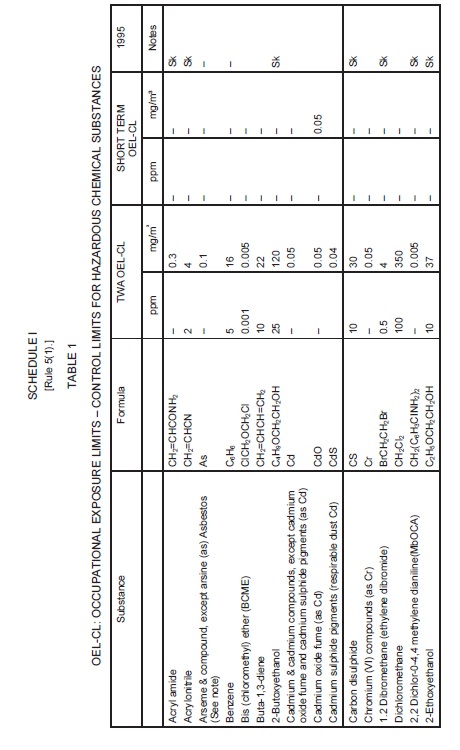
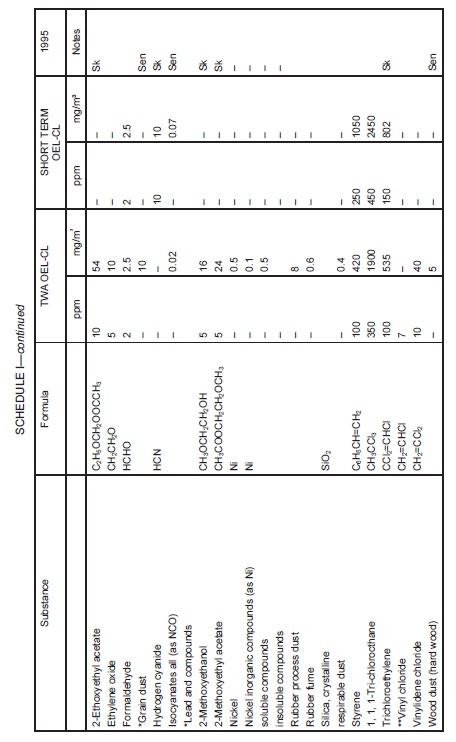
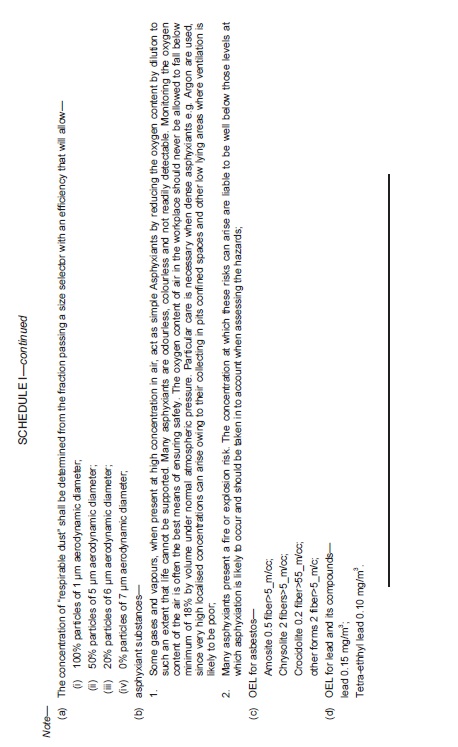
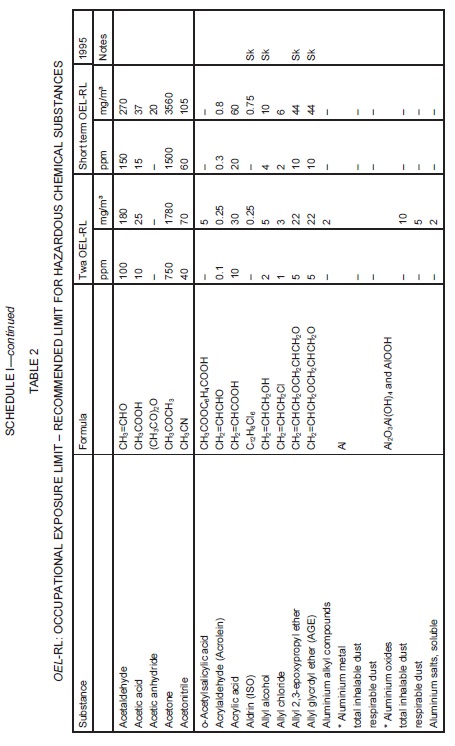
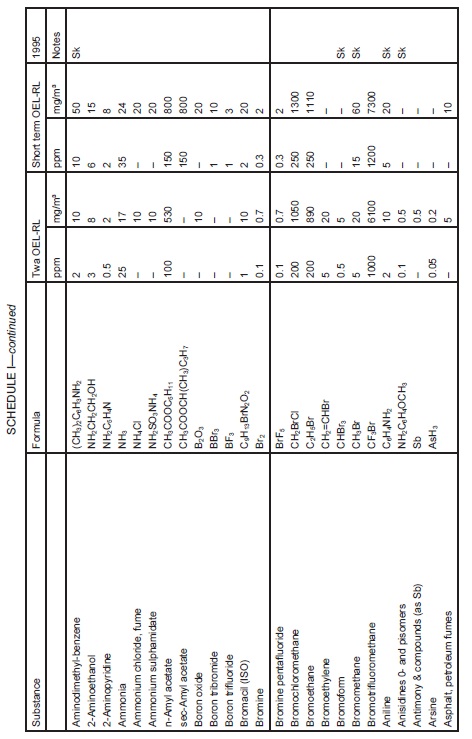
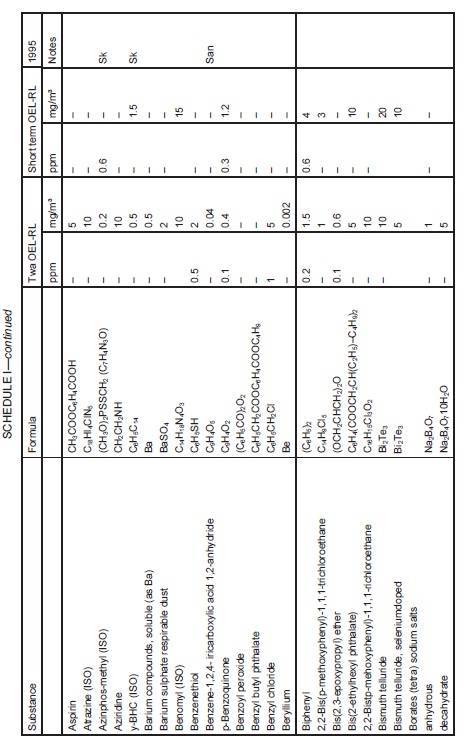
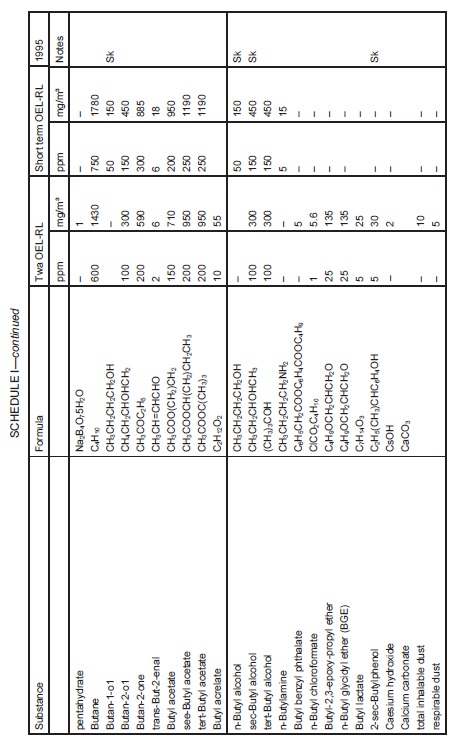
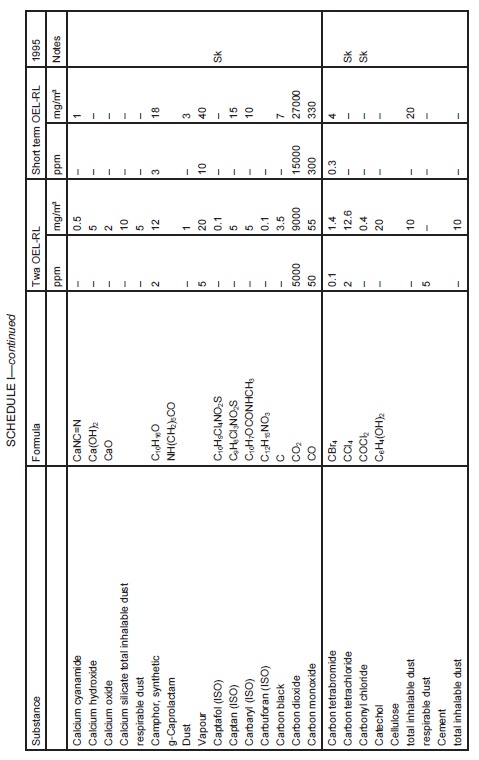
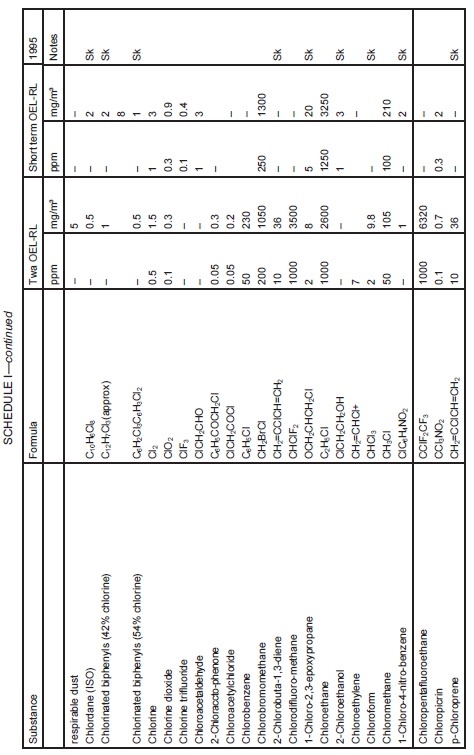
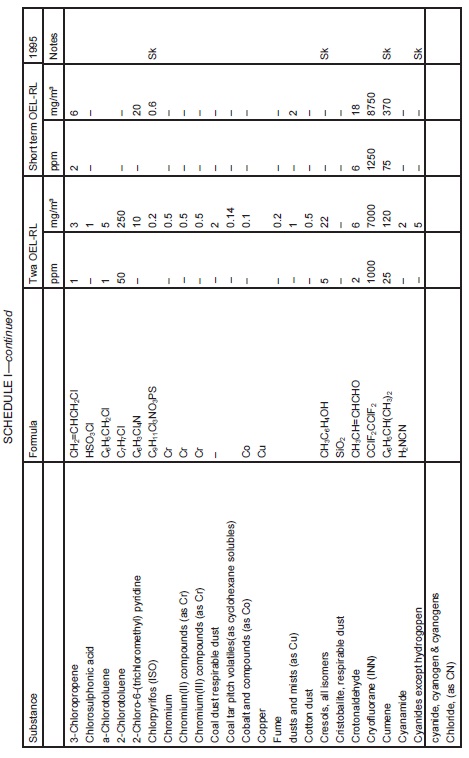
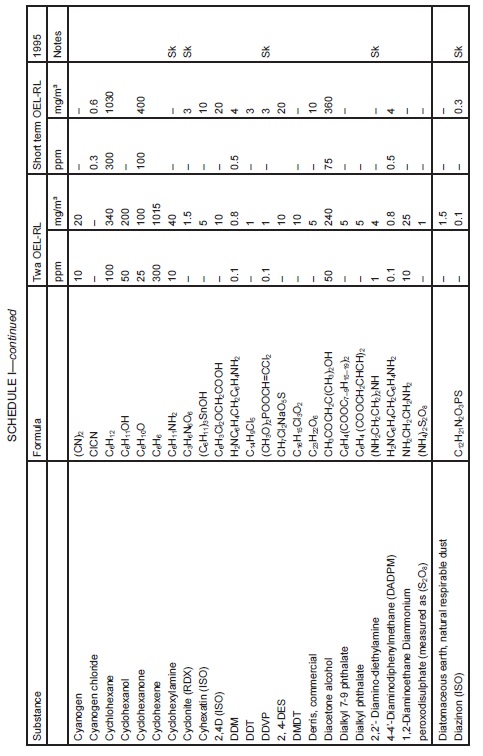
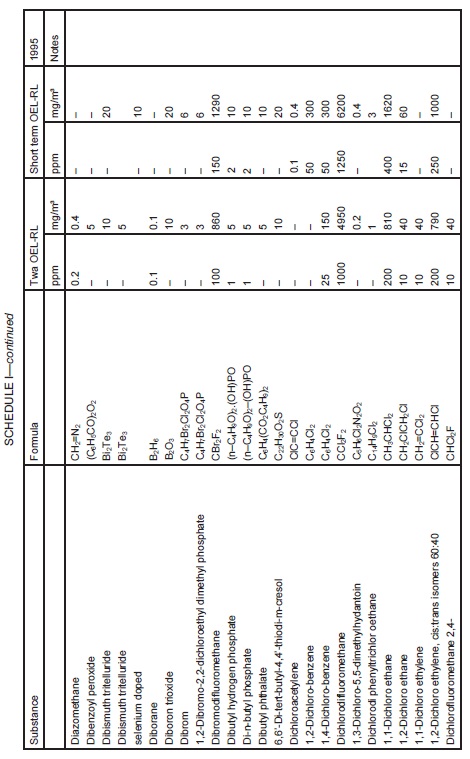
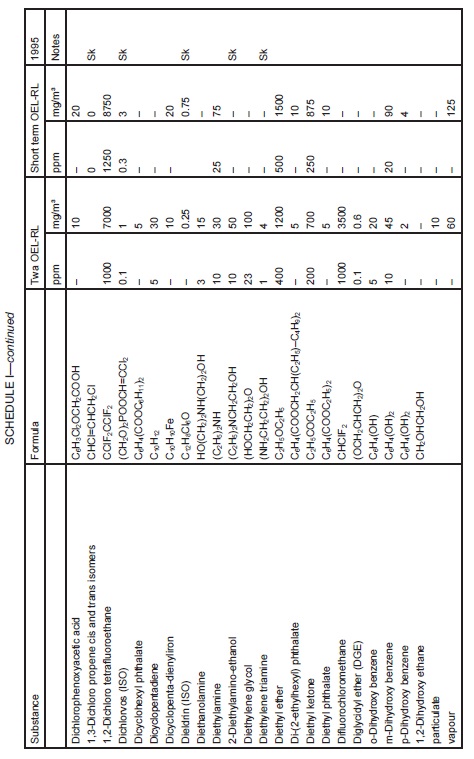
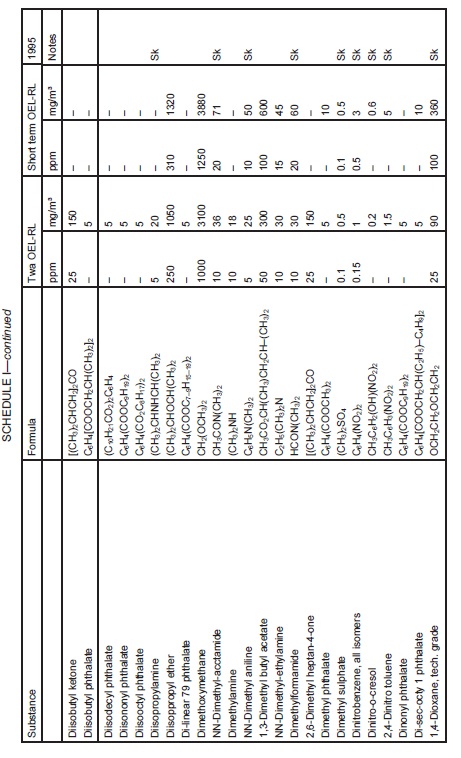
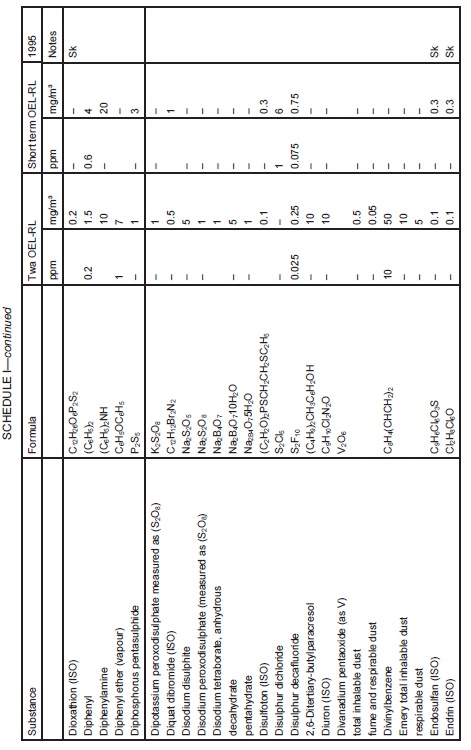
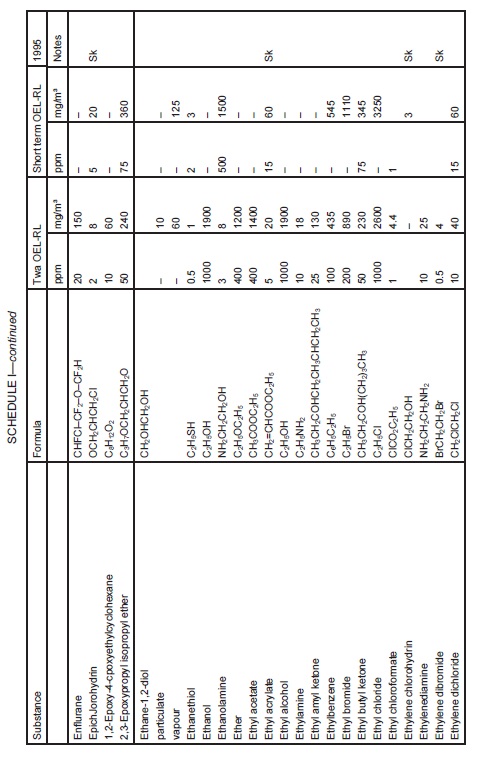
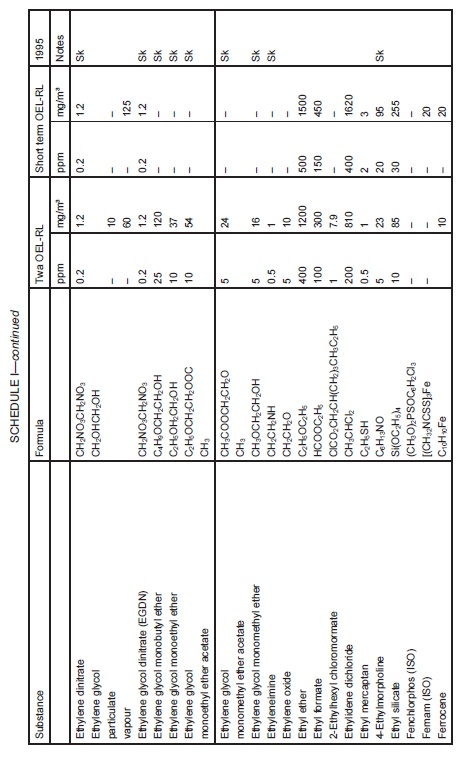
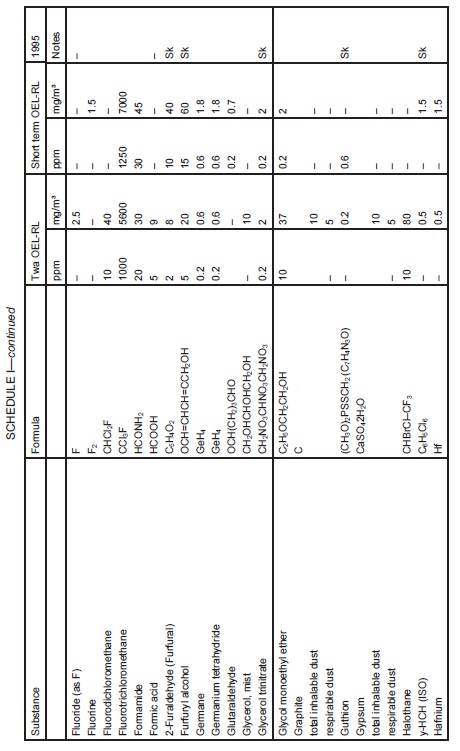
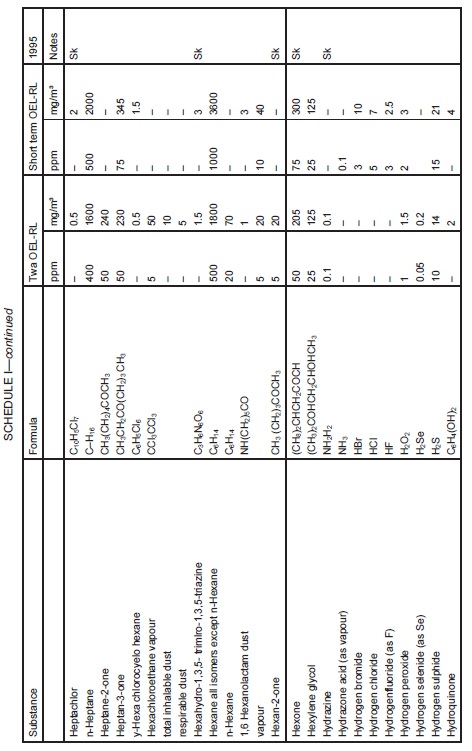
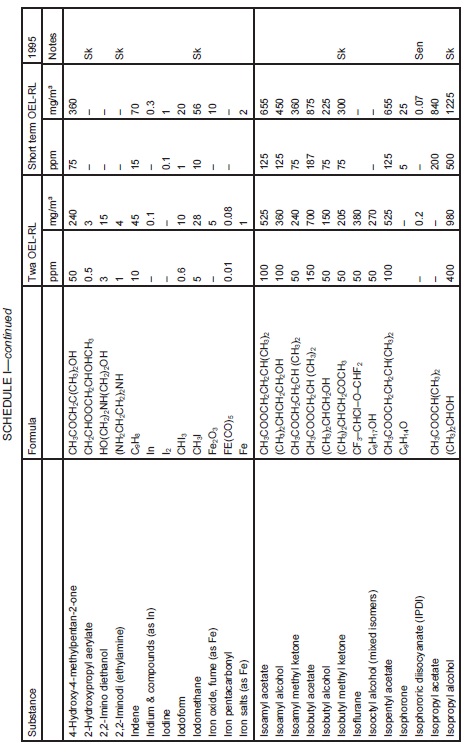
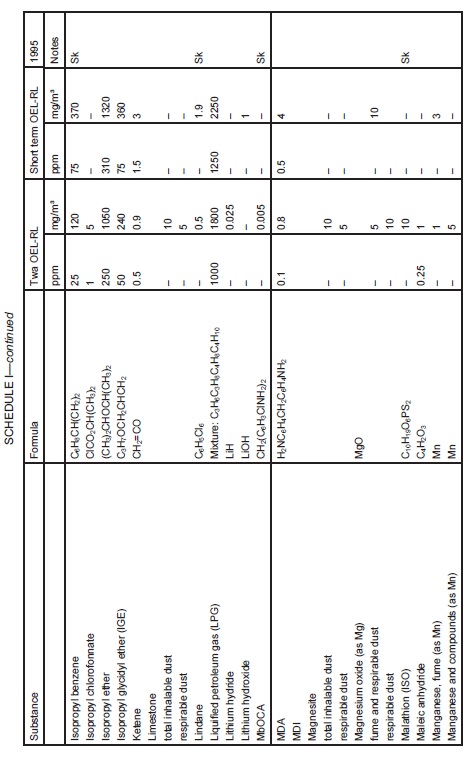
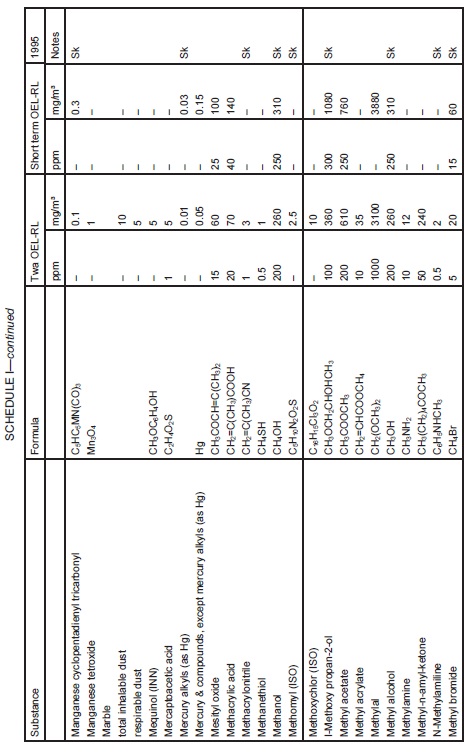
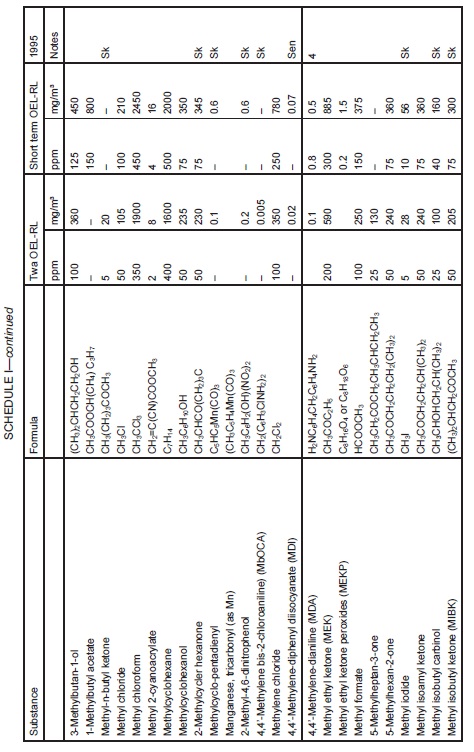
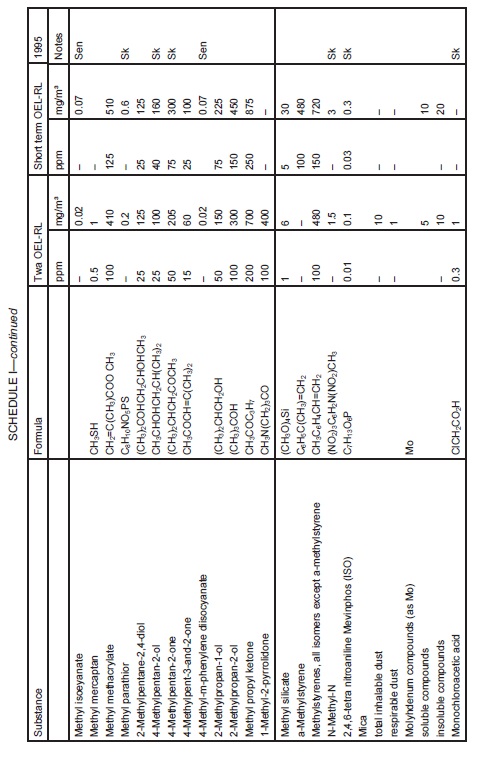
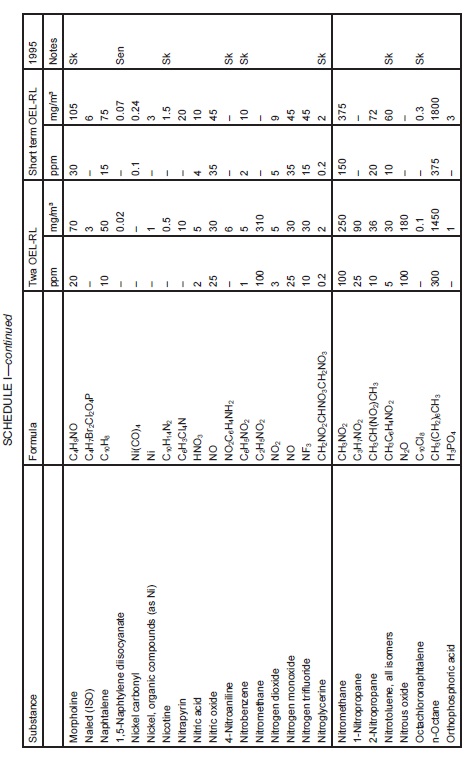
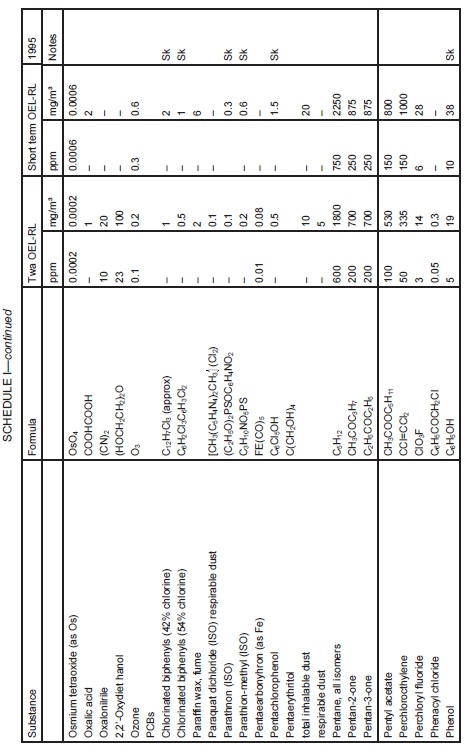
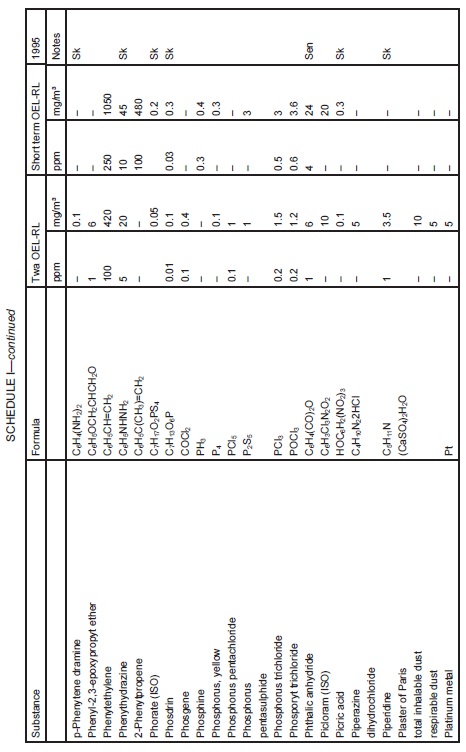
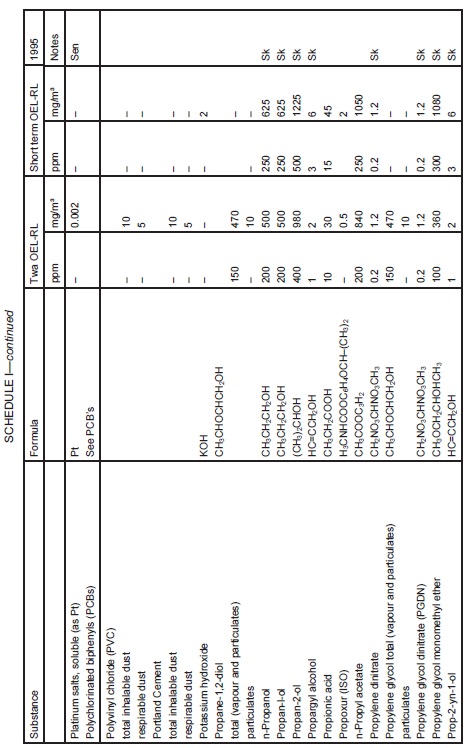
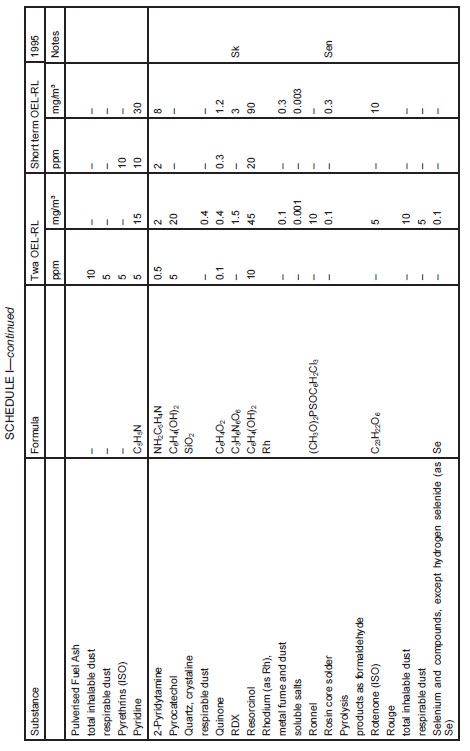
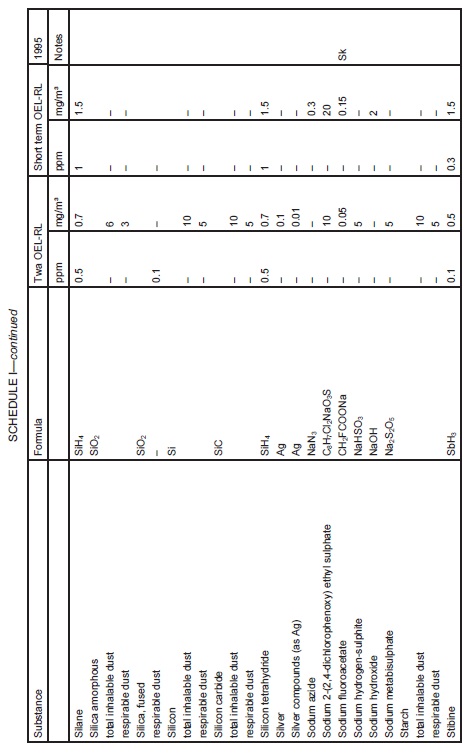
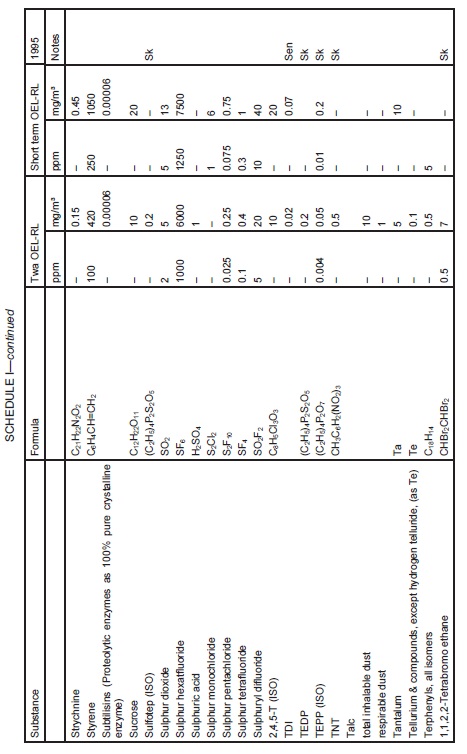
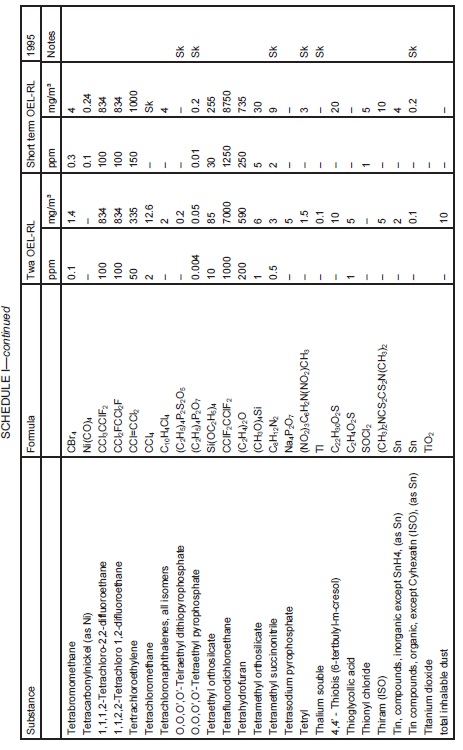
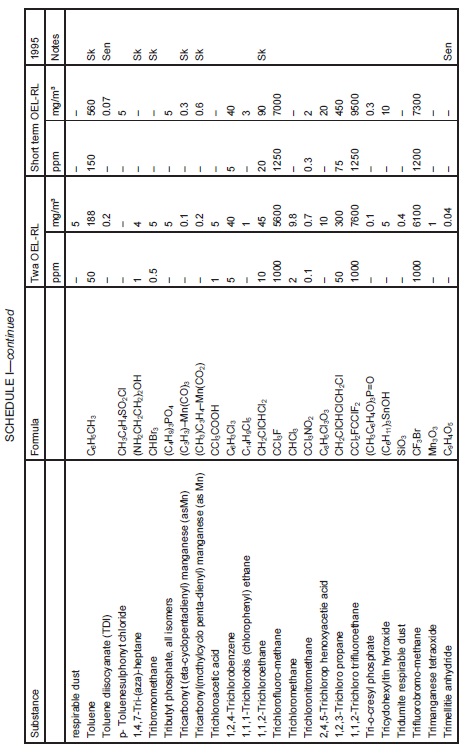
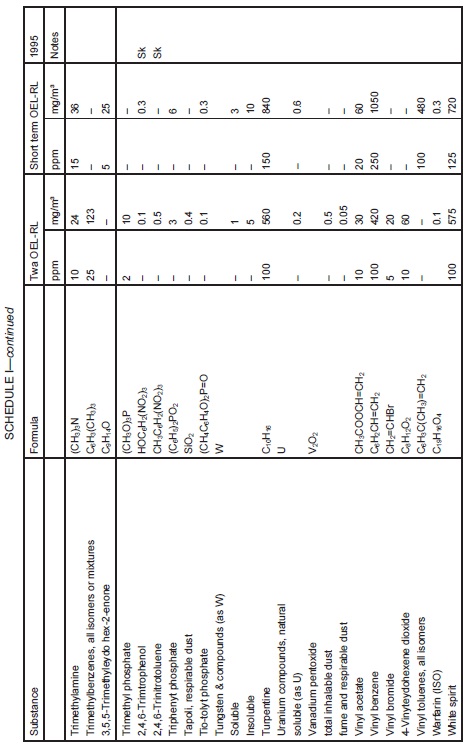
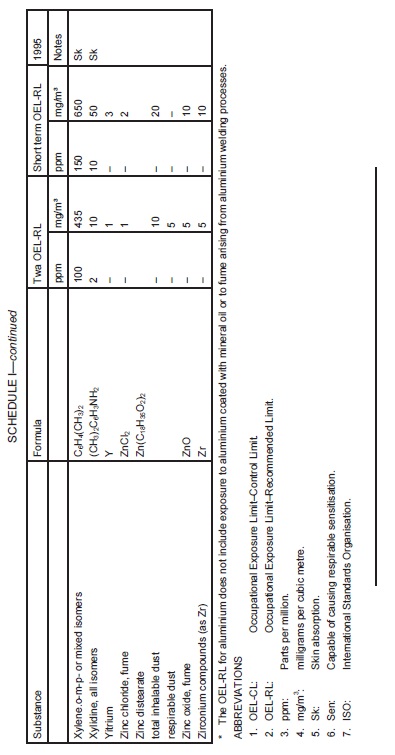
SCHEDULE I—continued
TABLE 3
BIOLOGICAL EXPOSURE INDICES (BEI)
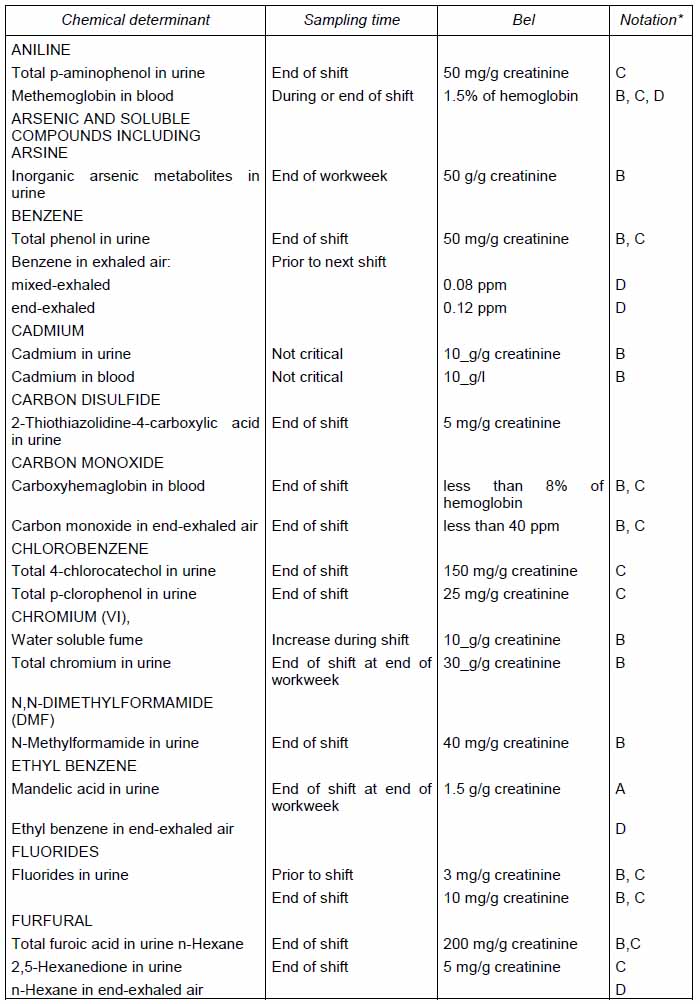
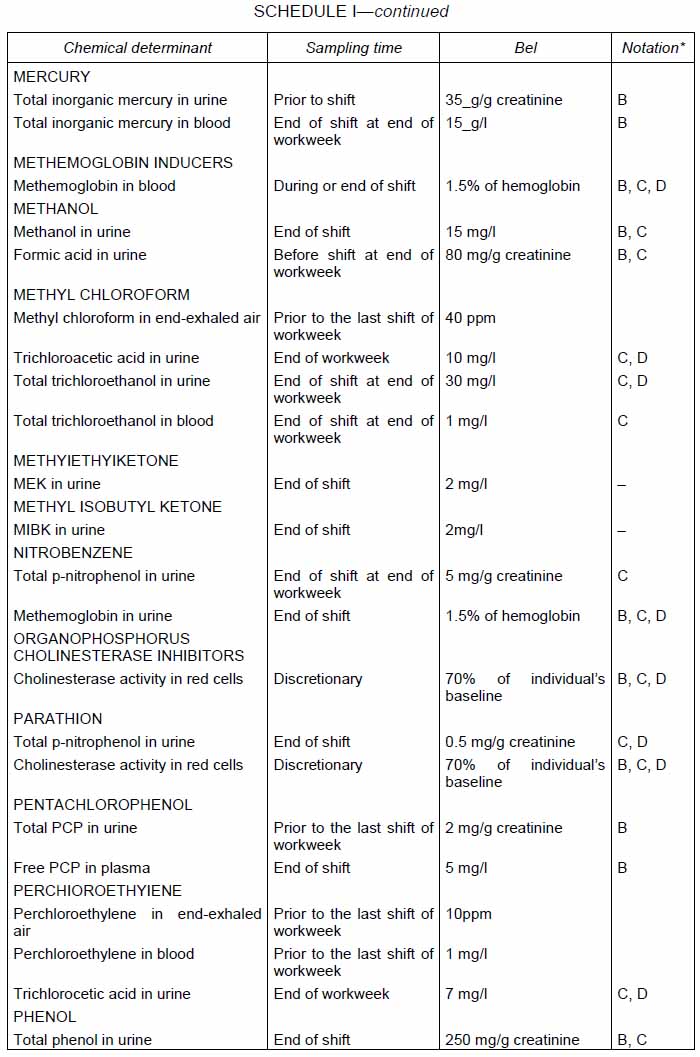
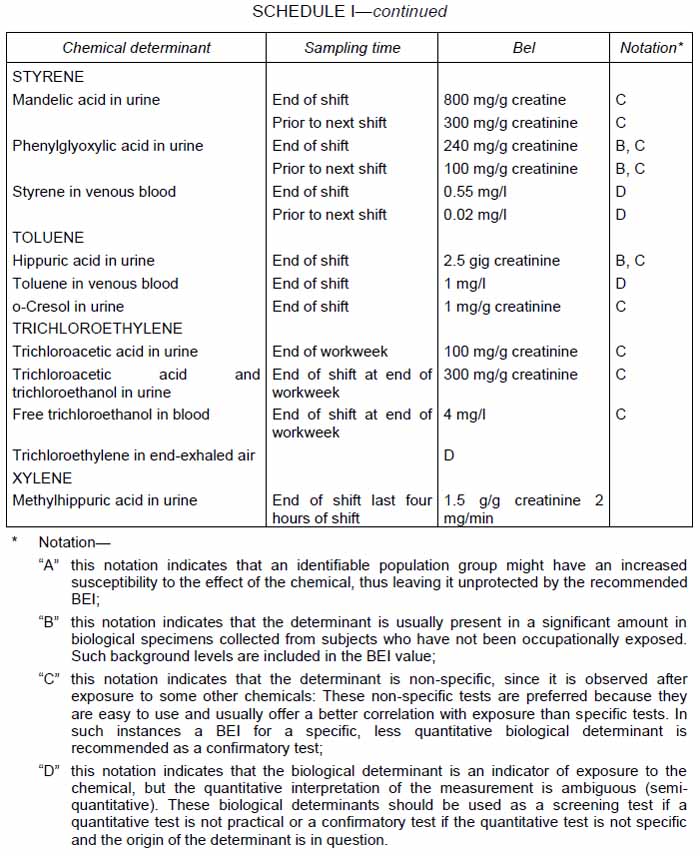
|
SCHEDULE II [Rule 5(3).]
APPLYING OCCUPATIONAL EXPOSURE LIMITS
| 1. |
General
The lists of occupational exposure limits given in Tables 1 and 2 unless otherwise stated, relate to personal exposure to substances hazardous to health in the air of the workplace.
|
| 2. |
Units of measurement
| (1) |
In occupational exposure limits, concentrations of gases and vapour in air are usually expressed in parts per million (ppm), a measure of concentration by volume, as well as in milligrams per cubic meter of air (mg/m3), a measure of concentration by mass.
|
| (2) |
In converting from ppm to mg/m3 a temperature of 25ºC and an atmospheric pressure of 101,325 KPa are used. Concentrations of airborne particles (fume, dust, etc.) are usually expressed in mg/m3. i.e.

|
| (3) |
In the case of dust, the limits in the tables refer to the total inhalable fraction unless specifically indicated as referring to the respirable fraction.
|
| (4) |
In the case of a man-made mineral fiber, the limit is expressed as fibers per milliliter of air (fibres/ml1
).
|
|
| 3. |
Occupational exposure limits – control limits: OEL-CL (Table
1)
| (1) |
An OEL-CL is the maximum concentration of an airborne substance, averaged over a reference period, to which employees may be exposed by inhalation under any circumstances, and is specified together with the appropriate reference period in Table 1.
|
| (2) |
Rule 5 of these Rules imposes a duty on the employer to take all reasonable precautions and to exercise all due diligence to ensure that exposure is kept as far below an OEL-CL as is reasonably practicable.
|
|
| 4. |
Occupational exposure limits– commended limit:OEL-RL Table
2
| (1) |
An OEL-RL is the concentration of an airborne substance, averaged over a reference period, at which, according to current knowledge, there is no evidence that it is likely to be injurious to employees if they are exposed by inhalation, day after day, to that concentration.
|
| (2) |
For a substance, which has been as signed an OEL-RL, exposure by inhalation should be reduced to that standard.
|
| (3) |
Control of an OEL-RL as prescribed in rule 7 (1) can always be regarded as adequate control of that substance for the purposes of these Rules, so far as exposure from inhalation is concerned. However, due to the variations in process control and the fluctuations in substance concentrations in the workplace, it will be prudent for employers to reduce exposure below an OEL-RL so as to ensure that the exposure of all employees does not exceed that OEL-RL. Similarly, it is not intended that the statutory requirements under rule 7 (1) should discourage the further application of good occupational hygiene principles in order to reduce exposure below the OEL-RL.
|
|
| 5. |
Long-term and short-term exposure limits
| (1) |
The pattern of effects due to exposure to substances hazardous to health varies considerably depending on the nature of the substance and the exposure. Some effects require prolonged or accumulated exposure.
|
| (2) |
The long-term (8-hour time weighted average) exposure limit is intended to control such effects by restricting the total intake by inhalation over one or more work shifts. Other effects may be seen after brief exposures, which have occurred once or repeatedly.
|
| (3) |
Short-term limits (usually 15 minute) may be applied to such substances. Where long-term limits also apply, the short-term limits restrict the magnitude of excursion above the average concentration during longer exposures. For those substances for which no short-term limit is specified, it is recommended that a figure of three times the long-term limit be used as a guideline for controlling short-term excursions in exposure.
|
| (4) |
With some other substances, brief exposure may be critical and the exposure limit necessary to prevent these excursions will also control any other effects. A separate long-term limit is not considered necessary in such cases and the short-term limit applies throughout the shift.
|
| (5) |
Exposure limits are expressed as airborne concentrations averaged over a specified period of time. The period for the long-term limit is normally eight hours. When a different period is used, this is stated. The averaging period for the short-term exposure limit is normally 15 minutes. Such a limit applies to any 15-minute period throughout the working shift.
|
|
| 6. |
Limitations to the application of exposure limits
| (1) |
The exposure limits relate to personal exposure with the exception of the annual OEL-CL for vinyl chloride, which should be recorded as the time weighted average of vinyl chloride in the atmosphere of a working place over a period of one year. The OEL-RL for cotton dust is not a personal exposure standard, but a static air standard.
|
| (2) |
The limits cannot readily be extrapolated to evaluate or control non-occupational exposure, e.g. levels of contamination in the neighborhood dose to an industrial plant. OELs only apply to persons at work. Employers should also take into account their duties under the Environmental Management and Co-ordination Act (EMCA).
|
| (3) |
The OELs are also only approved for use where the atmospheric pressure is between 85 KPa and 101,325 KPa. This covers the normal range of meteorological variations and slightly pressurised workplaces such as cleaning rooms, but not the higher pressures that may be encountered in, for example, tunneling or underwater hyperbaric chambers. Such situations require special assessments.
|
| (4) |
Occupational exposure limits, as set out in Tables 1 and 2 are intended to be used for normal working conditions in workplaces. OELs are not, however, designed to deal with serious accidents or emergencies, particularly where employees may be exposed to rapidly rising concentrations of gas, as may arise from a major escape due to plant failure.
|
| (5) |
Over and above the employers’ responsibilities to ensure that the requirements of these Rules are met, they also have a clear responsibility to ensure that the plant is designed, operated and maintained in a way that avoids accidents and emergencies. Where appropriate, detection, alarm and response measures should be used in order to minimise the effect of any such unplanned events.
|
| (6) |
To help maintain adequate operational control, employers may find it helpful to select their own indicators of control when undertaking investigations or corrective action.
|
|
| 7. |
Pesticides
Substances used as active ingredients in pesticides are listed under their chemical names and/or their common (ISO) names. These names may sometimes be used as parts of the names of proprietary pesticide formulations. In all cases the exposure limit applies to the specific active ingredients and not to the formulation as a whole.
|
| 8. |
Dusts
The general approach necessary to control occupational exposure to dusts is as follows—
| (1) |
Not all dusts have been assigned occupational exposure limits but the lack of such limits should not be taken to imply an absence of hazard. In the absence of a specific exposure limit for a particular dust, exposure should be adequately controlled.
|
| (2) |
Where there is no indication of the need for a lower value, personal exposure should be kept below both 10 mg/m3 8-hour time-weighted average total inhalable dust and 5 mg/m3 time weighted average respirable dust. Such, or greater, dust concentrations should be taken as the substantial concentrations.
|
| (3) |
A substantial concentration of dust should be taken as a concentration of 10 mg/m3, 8-hour time weighted average, of total inhalable dust or 5 mg/m3, 8-hour time-weighted average, of respirable dust, where there is no indication of the need for a lower value, and as such they are referred to as substances hazardous to health.
|
|
| 9. |
Total inhalable dust and respirable dust
| (1) |
Total inhalable dust approximates to the fraction of airborne material that enters the nose and mouth during breathing and is therefore available for deposition in the respiratory tract.
|
| (2) |
Respirable dust approximates to the fraction, which penetrates to the gas exchange region of the lung.
|
| (3) |
Where dusts contain components, which have their own assigned occupational exposure limits, all the relevant limits should be complied with.
|
|
| 10. |
Fume
| (1) |
Where a separate OEL has been set for fume; it should normally be applied to solid particles generated by chemical reactions or condensed from the gaseous state, usually alter volatilisation from melted substances.
|
| (2) |
The generation of fume is often accompanied by a chemical reaction such as oxidation or thermal breakdown.
|
|
| 11. |
Absorption through the skin
| (1) |
In general, for most substances the main route of entry into the body is by inhalation. The OELs given in these Rules solely relate to exposure by this route.
|
| (2) |
Certain substances such as phenol, aniline and certain pesticides (marked in the Tables with an SK notation) have the ability to penetrate the intact skin and thus become absorbed into the body.
|
| (3) |
Absorption through the skin can result from localised contamination, for example from a splash on the skin or clothing, or in certain cases from exposure to high atmospheric concentrations of vapour.
|
| (4) |
Serious effects can result in little or no warning and it is necessary to take special precautions to prevent skin contact when handling these substances.
|
| (5) |
Where the properties of the substances and the methods of use provide a potential exposure route via skin absorption; these factors should be taken into account in determining the adequacy of the control measures.
|
|
| 12. |
Sensitisers
| (1) |
Certain substances may cause sensitisation of the respiratory tract if inhaled or skin contact occurs.
|
| (2) |
Respiratory sensitisers can cause asthma, rhinitis, or extrinsic allergic alveolitis.
|
| (3) |
Skin sensitisers cause allergic contact dermatitis. Substances, which cause skin sensitisations, are not necessarily respiratory sensitisers or vice versa.
|
| (4) |
Only a proportion of the exposed population will become sensitised, and those who do become sensitised, will not have been identified in advance. Individuals who become sensitised may produce symptoms of ill health after exposure even to minute concentrations of the sensitiser.
|
| (5) |
Where it is reasonably practicable, exposure to sensitisers should be prevented. Where this cannot be achieved, exposure should be kept as low as is reasonably practicable and activities giving rise to short-term peak concentrations should receive particular attention. As with other substances, the spread of contamination by sensitisers to other working areas should also be prevented, as far as is reasonably practicable.
|
| (6) |
The Sen notation (marked in the Tables with a Sen notation) has been assigned only to those sensitisers that may cause sensitisation by inhalation. Remember that other substances not contained in these Tables can act as respiratory sensitisers.
|
|
| 13. |
Other factors
Working conditions, which impose additional stress on the body, such as exposure to ultra-violet radiation, high temperatures, pressures and humidity may increase the toxic response to a substance. In such cases, specialist advice may be necessary to evaluate the effects of these factors.
|
| 14. |
Mixed exposures: General
| (1) |
The majority of OELs listed in Tables 1 and 2 are for single compounds or for substances containing a common element or radical, e.g. tungsten and compounds, and isocyanides. A few of the limits relate to substances commonly encountered as complex mixtures or compounds e.g. white spirit, rubber fume, and welding fume.
|
| (2) |
However, workers are frequently subjected to other mixed exposures involving solids, liquids, aerosols or gases. These exposures can arise as a result of work with materials containing a mixture of substances, or from work with several individual substances, simultaneously or successively, in a work shift.
|
| (3) |
Mixed exposures require careful assessment of their health effects and the appropriateness of control standards. The following paragraphs provide a brief summary of the advice on the application of exposure limits in these circumstances. In all cases of doubt, specialist advice should be sought.
|
|
| 15. |
Effects of mixed exposures
| (1) |
The ways in which the constituent sub stances of a mixed exposure interact vary considerably. Some mixed exposures involve substances that act on different body tissues or organs, or by different toxicological mechanisms, these various effects being independent of each other.
|
| (2) |
Other mixtures will include substances that act on the same organs, or by similar mechanisms, so that the effects reinforce each other and the substances are additive in their effect. In some cases the overall effect is considerably greater than the sum of the individual effects and the system is synergistic. This may arise from mutual enhancement of the effects of the constituents or because one substance potentiates another, causing it to act in a way which it would not do alone.
|
|
| 16. |
Assessment and control
| (1) |
With all types of mixed exposures, it is essential that assessments be based on the concentrations of each of the constituents in air to which workers are exposed. Depending on the nature of the constituents and the circumstances of use, the relative concentrations of the constituents in air may differ considerably from those in the liquid or solid source material. The composition of the bulk material should not be relied on for assessment unless there is good evidence for doing so.
|
| (2) |
Where mixed exposure occurs, the first step is to ensure adequate control of exposure for each individual substance. However, the nature and amount of the other substances in a mixture can influence the level to which it is reasonable practicable to reduce exposure to a substance subject to an OEL-CL.
|
| (3) |
When limits for specific mixtures have been established, they should be used only where they are applicable, and in addition to any relevant individual limits. They should not be extended to inappropriate situations. It is then necessary to assess whether further control is needed to counteract any increased risk from the substances acting in conjunction.
|
| (4) |
Expert assessments for some particular mixed exposures may be available and can be used as guidelines in similar cases. In other cases, close examination of the toxicological data will be necessary to determine which of the main types of interaction (if any) are likely for the particular combination of substances concerned.
|
| (5) |
The various types should be considered in the following order—
| 5.1 |
Synergistic substances:
Known cases of synergism and potentiation are considerably less common than the other types of behaviour in mixed exposures. However, they are the most serious in their effects and require the most strict control. They are also the most difficult to assess and wherever there is reason to suspect such interaction, specialist advice should be obtained;
|
| 5.2 |
Additive substances:
Where there is reason to believe that the effects of the constituents are additive, and where the exposure limits are based on the same health effects, the mixed exposure should be assessed by means of the formula
C1/L1+C2/L2+C3/L3…>1
where C1, C2, etc. are the time-weighted average (TWA) concentrations of constituents in air and L1, L2. etc are the corresponding exposure limits. The use of this formula is only applicable where the additive substances have been assigned OELs, and L1, L2. etc. relate to the same reference period in the list of approved OELs. Where the sum of the C/L fractions does not exceed one, the exposure is considered not to exceed the OELs. If one of the constituents has been assigned an OEL-CL, then the additive effect should be taken into account in deciding the extent to which it is reasonably practicable to further reduce exposure; and
|
| 5.3 |
Independent substances:
Where no synergistic or additive effects are known or considered likely, the constituents can be regarded as acting independently. It is then sufficient to ensure compliance with each of the OELs individually.
|
|
| (6) |
The above steps provide basic protocol for assessment of mixed exposures. It is open to persons responsible for control of exposure to treat all nonsynergistic systems as though they were additive. This avoids the need to distinguish additive and independent systems and can be regarded as the more prudent course, particularly where the toxicity data are scarce or difficult to assess.
|
|
| 17. |
Monitoring mixed exposure
| (1) |
The number of components of a mixed exposure, for which routine air monitoring is required, can be reduced if their relative concentrations can be shown to be constant.
|
| (2) |
This involves the selection of a key or marker, which may be one of the constituents, as a measure of the total contamination. Exposure to the marker is controlled at a level selected so that exposures to all components will be controlled in accordance with the criteria in paragraphs 16.5.1 and 16.5.2.
|
| (3) |
However, if one of the components has been assigned an OEL-CL, the level of the exposure to that substance should always be reduced as far as is reasonably practicable.
|
| (4) |
If this approach is to be used, it should take place under the guidance of suitable specialist advice.
|
| (5) |
Rule 16 imposes a duty on the employer to monitor the exposure of employees to substances hazardous to health.
|
|
| 18. |
Complicating factors
| (1) |
Several factors that complicate the assessment and control of exposure to individual substances will also affect cases of mixed exposures and will require similar special consideration. Such factors include—
|
| (1.1) |
exposure to a substance for which there is no established limit or for which an OEL-CL has been set;
|
| (1.2) |
the relevance of factors such as alcohol, medication, smoking and additional stresses;
|
| (1.3) |
exposure of the skin to one or more substances that can be absorbed by this route, as well as by inhalation; and
|
| (1.4) |
substances in mixture may mutually affect the extent of their absorption, as well as their health effects, at a given level of exposure.
|
|
SCHEDULE III [Rule 12.]
MATERIAL SAFETY DATA SHEET
|
MATERIAL SAFETY DATA SHEET
|
No.:
Date issued:
|
|
Manufacturer/Supplier Details
|
|
|
Name:
Address:
Tel:
|
Emergency telephone no.:
Telex:
Fax:
|
|
|
1. Material identification:
|
Trade name:Chemical family:Chemical name:Synonyms:
|
|
2. Composition:
|
|
|
|
3. Hazards Identification:
|
Main hazard:Flammability:Chemical hazard:Biological hazard:Reproductive hazard:Eye effects:Health effects – skin:Health effects – ingestion:Health effects – inhalation:Carcinogenicity:Mutagenicity:Neurotoxicity:
|
|
4. First-aid Measures:
|
Material if in eye: Material if on skin: Material if ingested: Material if inhaled:
|
|
5. Fire-fighting Measures
|
Extinguishing media: Special hazards: Protective clothing:
|
|
6. Accidental Release Measures:
|
Personal precautions:
Environmental precautions:
Spills:
|
|
7. Handling and Storage:
|
Handling/storage precautions:
|
|
|
8. Exposure Controls/Personal Protection:
|
Occupational exposure limits: Engineering control measures:Personal protection – respiratory: Personal protection – hand: Personal protection – eye: Personal protection – skin: Other protection:
|
|
9. Physical and Chemical Properties:
|
Appearance: Odour:pH:Boiling point: Melting point: Flash point:Flammability:Autoflammability:Explosive properties: Oxidising properties:Vapour pressure:Density:Solubility – water: Solubility – solvent: Solubility – coefficient: Neurotoxicity:
|
|
10. Stability and Reactivity:
|
Conditions to avoid:Incompatible materials:Hazardous decomposition products:
|
|
11. Toxicological information:
|
Acute toxicity:Skin and eye contact:Chronic toxicity: Carcinogenicity: Mutagenicity:Neurotoxicity: Reproductive hazards:
|
|
12. Disposal Considerations:
|
Disposal methods:
Disposal of packaging:
|
|
13. Other Information:
|
|



















